The major energy players moving to solar
Australia leads the way in storage

Frank
MANAGING CHALLENGE AND CHANGE
AUSTRALIA’S
ISSUE 9 · March 2020 · www.energymagazine.com.au
Tudor:
HYDROGEN STRATEGY: where to next?
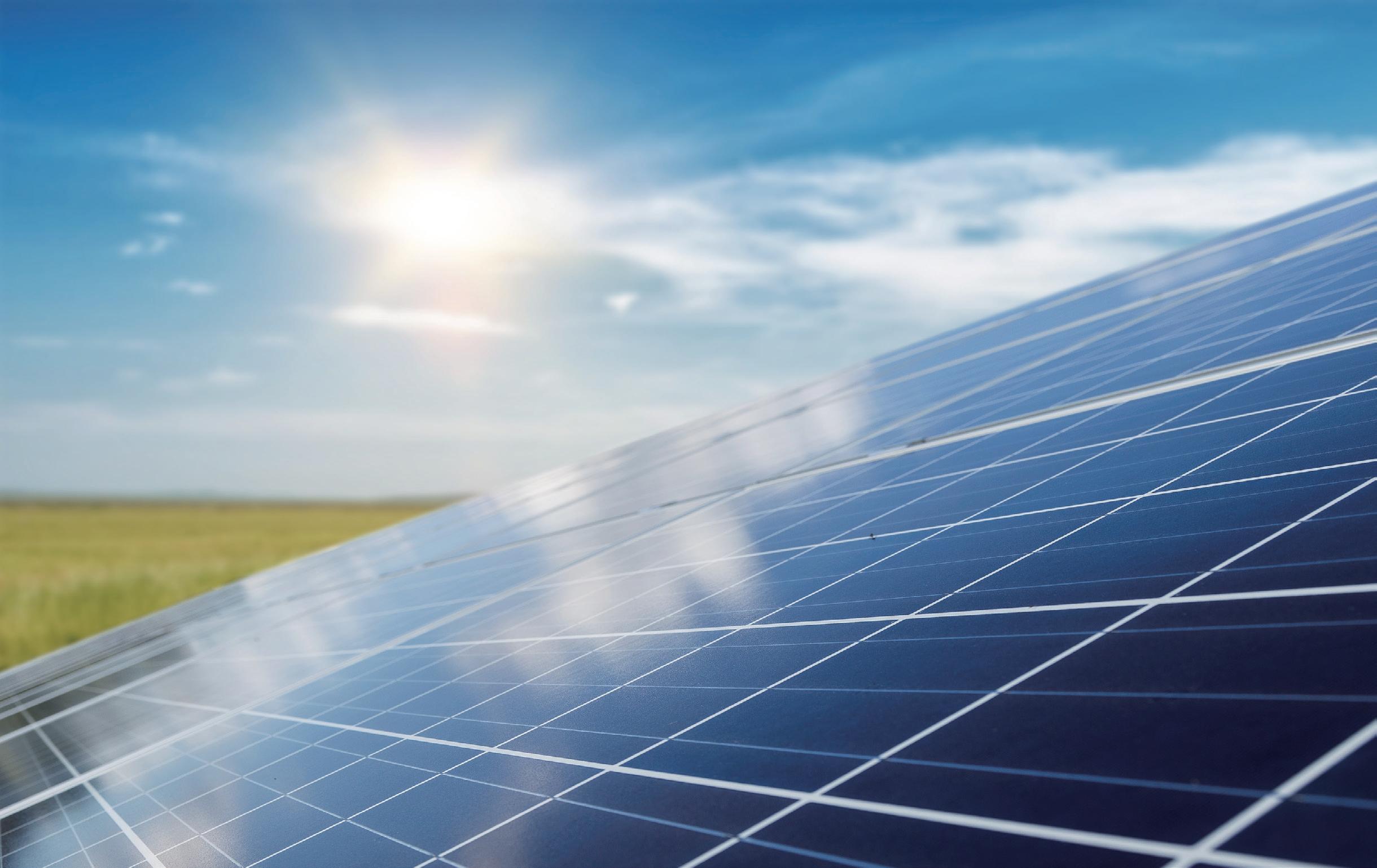

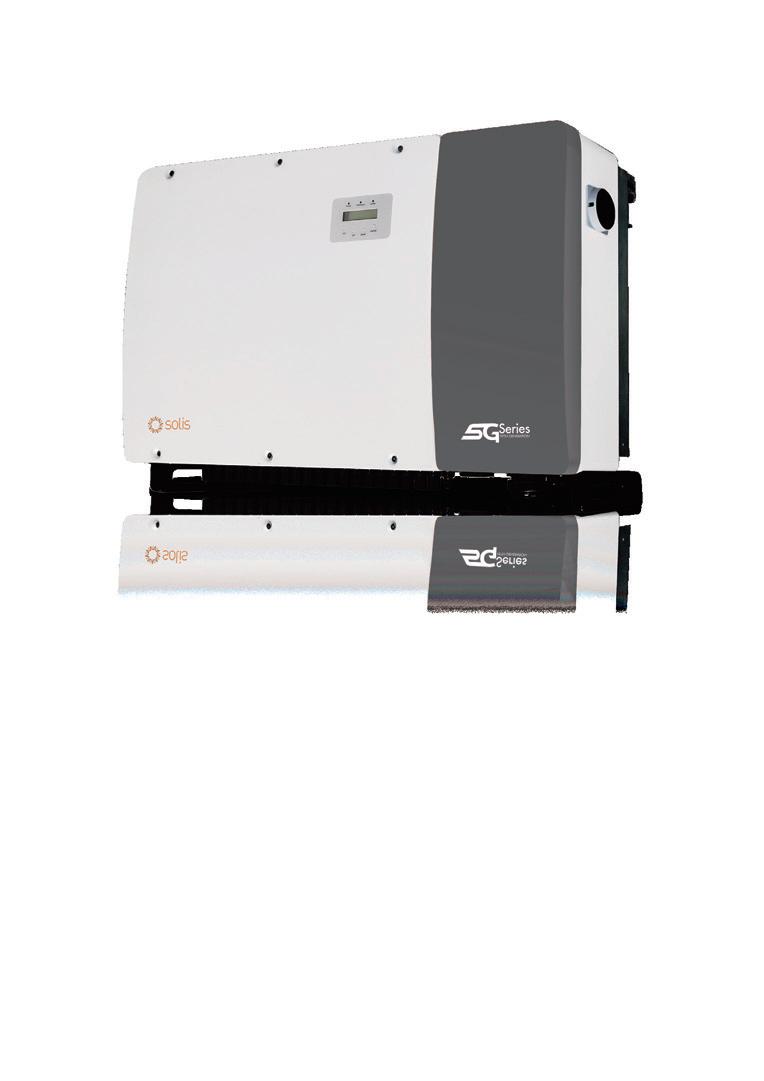
Made by Ginlong Technologies Stock Code: 300763.SZ w: ginlong.com / e: sales@ginongaust.com.au Local Service Line: (0)3 8555 9516 Add: No. 5 / 109 Tulip Street, Cheltenham,Vic. 3192 Australia Need Reliability ? The Solution is Solis Inverters Countries with Ginlong (Solis) Installations 100+ Employees 1000+ Countries with Ginlong (Solis) Installations 5GW + Global Installation 10GW + Million - Assets Total USD 200 Chinese Inverter Exporter Source: Energy Trend (Former part of DNV-GL) PVEL Reliability Test Most Bankable Asian Inverter Source: BloombergNEF Bankable. Reliable. Local.
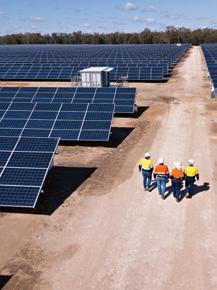


F: (03) 8456 6720
monkeymedia.com.au
info@monkeymedia.com.au energymagazine.com.au
info@energymagazine.com.au ISSN: 2209-0541
Earlier this month I was asked to contribute to an article which was looking at the steps the Federal Government should be taking to tackle climate change. This was the gist of my response:
“The first thing the current Government needs to do is acknowledge that our climate is changing; and then commit to taking action to address this.
"As far as the energy sector is concerned, there are many people within the industry working on new technologies and system improvements that will help to address the impact fossil fuels are having on the climate.
"There is undoubtedly more that can be done; and a clear policy position will help the industry move forward to do that.
"We also need to acknowledge that Australia's energy system is a complicated grid, which cannot be completely overhauled overnight. Step change, sensibly managed is what is required, and the Government needs to work with industry to formulate the steps required to do this."
As all our readers would be aware, there’s nothing controversial in this statement – in fact, reflecting on this today, I’m reminded that what I’ve suggested
above is essentially a summary of what the industry has been asking for from governments for the past ten years.
A policy position on climate change, and by extension energy, so that we can all move towards building the energy system our country needs today, tomorrow and further into the future.
Perhaps not surprisingly, nor coincidentally, much of the content in this issue reflects the challenges above – the renewable technologies that are helping with the transition to cleaner energy; the new technologies, such as hydrogen, which will also have a role to play; and the role that gas will play as we replace the coal-fired generation in our grid with renewable technologies.
My hope is that the events of this summer will represent somewhat of a tipping point for governments around Australia that emboldens our leaders to take decisive action when it comes to energy and climate.
But until that happens, let’s keep raising our voices and sharing and talking about the great work that’s already being done in the industry to help tackle the energy and climate dilemma we’re continuing to face.
1
Harvey Editor ISSUE 9—MARCH 2020 WELCOME
Andreas Klien Cyber Security Expert detect and react cyberattacks digitization and networking of energy growing danger that IEC 61850 systems cyber attacks. Therefore, cyber role in the planning and operation StationGuard monitoring system allows and malfunctions in substations to them at an early stage. www.omicronenergy.com/stationguard info.australia@omicronenergy.com ENERGY MARCH 2020 Australia leads the way in storage Frank Tudor: MANAGING CHALLENGE AND CHANGE AUSTRALIA’S HYDROGEN STRATEGY: where to next? The major energy players moving to solar Monkey Media Enterprises ABN: 36 426 734 954
Gipps St
Laura
EDITOR’S WELCOME
204/23–25
Collingwood VIC 3066
P: (03) 9988 4950
Published by We’re keen to hear your thoughts and feedback on this issue of Energy. Get in touch at info@energymagazine.com.au or feel free to give us a call on (03) 9988 4950. 6,229 This publication has been independently audited under the AMAA’s CAB Total Distribution Audit. Audit Period: 1 April 2019 – 30 September 2019 March 2020 ISSUE 9 Editor Laura Harvey Assistant Editor Imogen Hartmann Contributing Editor Siobhan Day Journalists Eliza Booth Lauren Butler Design Manager Alejandro Molano Designers Jacqueline Buckmaster Rupa Anurendra Business Development Manager Rima Munafo Publisher Chris Bland Cover shows Australian Pipeline Trust's Darling Downs Solar Farm.




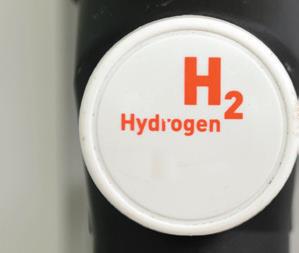

2 SOLAR AND STORAGE 14 Clean energy investment collapse: what can we do? 18 Storage is the key and Australia leads the way 22 Batteries – let’s make them sweet not sour 24 Writing the book on integrating utility-scale batteries into the grid 28 A renewed outlook on renewables 32 Driving solar project delivery 34 Accelerate the transition to clean energy with smart tools INDUSTRY INSIGHT 10 Frank Tudor: managing challenge and change with customers at the heart 24 10 HYDROGEN AND FUTURE FUELS 36 Australia’s hydrogen strategy has officially landed 40 Clean energy’s power to make an impact 42 Australian Hydrogen Centre launched 44 Green is the new vintage 45 Close Comfort is the future of air conditioning 46 Waste: a win-win bill-buster for high energy users 36 NEWS 6 VIC to NSW transmission investment “critical” 6 $2 billion Federal/NSW energy agreement 7 The future is electric, Chief Scientist says 7 Australia is the world’s largest LNG exporter 8 Adelaide backs renewables 8 Energy Queensland appoints new CEO 9 Shell merges gas and solar with new project EACH ISSUE 1 EDITOR'S WELCOME 4 CONTRIBUTORS 80 FEATURES SCHEDULE 80 ADVERTISERS’ INDEX CONTENTS March 2020 ISSUE 9 www.energymagazine.com.au


SMART NETWORKS
48 Preparing for five minute settlement: the future of Australia’s utility markets
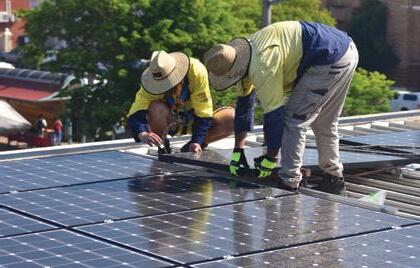
54

CONSUMER AND INDUSTRIAL RETAIL
51 Promoting renewables to benefit the customer – and the grid
54 Community-owned energy retailer outlines new vision for industry

60

SPATIAL & GIS
60 Life-saving technology for powerlines awareness
64 How thermal aerial imaging is changing solar farm management


CLIMATE
66 Climate change denialism –we’re all guilty
70 Stand-alone Power Systems – a role to play in bushfire prevention?
74 The role of LNG in achieving emissions reduction

57

PUMPED HYDRO
56 Australia’s pumping hydro evolution

SECURITY
76 ESB to provide reliability advice and security measures EVENTS
78 Top tier speakers at top tier conference
CONTENTS 3
www.energymagazine.com.au March 2020 ISSUE 9
48 66 76

Kane Thornton
Managing Director, Jemena
Frank has more than 30 years’ experience in the international oil, gas, and power industries having held various senior executive roles across the sector throughout his career. Before joining Jemena Frank was CEO at Horizon Power – Australia’s only vertically-integrated electricity utility which provides energy services to customers across regional Western Australia. Frank holds first class degrees in engineering, economics, and business administration from Curtin University (WA), the London School of Economics (UK) and AGSM (the University of NSW). He has also completed the Advanced Management Program at Harvard Business School and lectured in oil and gas economics and legal frameworks at the University of Western Australia. Frank also serves on the Expert Advisory Panel with the Australian Energy Market Operator (AEMO), is a Board member of Energy Networks Australia (and is Chair of its Asset Management Committee), and is also a former member of the Federal Government’s Australia China Council.
Chief Executive Officer, Clean Energy Council
Kane Thornton is Chief Executive of the Clean Energy Council, the peak body for the clean energy industry in Australia. Kane has more than a decade's experience in energy policy and leadership in the development of the renewable energy industry. Kane has advocated for and helped design the policies that have been critical to the renewable energy industry's growth, and continues to be an active political advocate, public presenter and media spokesperson. His previous roles include Senior Manager and Advisor for Hydro Tasmania – Australia's largest generator of renewable energy – and Executive Officer of Renewable Energy Generators Australia. Kane has broad international management experience having previously worked in technology, living and working in Asia. He has held a range of advisory and board roles with government and non-government organisations in the climate change and energy sector, and is a non-executive director of Sustainability Victoria. Kane is a graduate of the Australian Institute of Company Directors, has a Masters in Social Science and Bachelor of Information Technology.

Claire Johnson

Co-Founder & CEO, Hydrolytics
Hydrolytics is a data intelligence startup which provides market monitoring and analysis of the global hydrogen sector with the objective to enable the clean hydrogen economy. Prior to launching Hydrolytics in 2019, Claire was the CEO of Hydrogen Mobility Australia, the industry association representing Australia’s emerging hydrogen sector. In this role, Claire advocated for the introduction of hydrogen and fuel cell technologies to Australia with governments, industry and the community. Claire has a background in policy development and government relations across the private and public sectors, including as manager of government affairs at Toyota Australia. In this role she led the company’s government engagement program for a range of transport policy areas, including the introduction of hydrogen fuel cell electric vehicles to Australia. Claire has also worked for Australian federal and state governments in policy development, including industry, environmental and trade policy. Claire holds a Bachelor of Economics and a Master of Marketing from the University of Tasmania.
4 CONTRIBUTORS
Frank Tudor
March 2020 ISSUE 9 www.energymagazine.com.au

Felicity Stening
Dan
Adams and Chris Thompson Chief Executive Officer, Enova Energy
Co-founders, Amber Electric
Amber Electric was born in 2017 out of two dreams: moving the world towards 100 per cent renewable energy and using technology to improve people's lives. Chris is motivated by using new technologies to improve people’s lives. Prior to Amber, Chris worked in Iran running Bamilo, Iran’s largest online marketplace and before that was with the Boston Consulting Group. Dan is passionate about moving the world towards 100 per cent renewable energy. He’s spent the last ten years working with Tesla, the Boston Consulting Group and building social movements around climate change.
Felicity Stening is the Chief Executive Officer for Enova Energy, an organistion dedicated to the evolution of the energy industry: to unearthing good ideas, encouraging ingenuity, harnessing appropriate technologies, providing avenues for local employment, and to increasing our knowledge about renewable energies, for the benefit of the whole community. Felicity has over 25 years’ experience in the energy and environment fields, with a track record delivering innovation and high-performing projects to Australian businesses, energy utilities and government agencies. Her expertise is in electricity markets, emerging energy technology, innovation, energy efficiency, renewables and carbon markets in Australia. Former roles have included Operations Manager for Enova Energy, Commercial Manager at Jemena Gas Networks, Head of Retail Markets at Pooled Energy, Senior Product Manager at Australian Power & Gas, National Business Development Manager at Low Energy Supplies & Services (LESS) and Program Manager with the NSW Sustainable Energy Development Authority (SEDA). Felicity is a current Associate Director on the Northern Rivers Community Foundation and has held Board positions at the Association of Building Sustainability Assessors and LESS.


UNSW Scientia PhD candidate Belinda Xie
After completing a Bachelor of Science with Honours at the University of Western Australia, Belinda moved to the University of New South Wales to begin her PhD. Belinda is currently a Scientia PhD Scholar in the School of Psychology, and her research primarily explores how people reason from repetitions of evidence and the extent to which people discount redundant information. To address these questions, Belinda conducts online experiments and then uses computational models to understand how participants are reasoning in these experiments. In addition to this area of cognitive science, Belinda has also completed projects related to the psychology of climate change, and her work in this field is the subject of her article in this issue of Energy
5 CONTRIBUTORS
www.energymagazine.com.au March 2020 ISSUE 9
VIC TO NSW TRANSMISSION INVESTMENT “CRITICAL”
AEMO and TransGrid have published a joint Project Assessment Conclusion Report (PACR), recommending critical short-term investment to increase the transfer capacity of the existing Victoria to NSW transmission corridor.
The preferred option identified in the PACR is to implement the following upgrades to the existing Victoria to NSW transfer corridor by 2022-23:
» Install a second 500/330kV transformer at South Morang Terminal Station
» Re-tension the 330kV South Morang – Dederang transmission lines, as well as associated works (including replacement of series capacitors which will be replaced with higher rated capacitors to align with the new line ratings), to allow operation at thermal rating
» Install modular power flow controllers on the 330kV Upper Tumut – Canberra and Upper Tumut – Yass lines to balance power flows and increase transfer capability
This preferred option is aimed to boost the Victoria to NSW interconnector export capability by approximately 170MW during peak demand conditions in NSW, and yields the highest net market benefits of all options assessed through the Regulatory Investment Test for Transmission (RIT-T) process, primarily through more efficient sharing of generation resources between the states.
This option has an estimated cost of $87 million (in present value terms) and is expected to deliver a net economic benefit of approximately $268 million (in present value terms), by:
» Reducing dispatch costs, through more efficient dispatch of generation in Victoria and NSW
» Reducing capital costs associated with new generation build in NSW
AEMO Managing Director and Chief Executive Officer, Audrey Zibelman, said this proposal is underpinned by AEMO’s Integrated System Plan (ISP) and will provide a strong return on investment.
“Initial estimates show that for every dollar invested in this urgent short-term project, we’ll see approximately three times that in net
market benefits, and these market benefits will start to accrue almost immediately following the proposed commissioning of the project in 2022-23,” Ms Zibelman said.
“These benefits are largely the result of cost savings achieved through more efficient dispatch of generation in Victoria and NSW, and reduced capital costs associated with new generation build in NSW. This helps to protect consumers from paying more than necessary for their electricity.”
TransGrid Chief Executive Officer, Paul Italiano, said the upgrade will deliver the capacity to share more electricity between NSW and Victoria.
“Upgrading the interconnector will provide the greatest benefit to energy consumers at the lowest possible cost,” Mr Italiano said.
The PACR confirms the initial investment option proposed in AEMO and TransGrid’s Project Assessment Draft Report (PADR) for the Victoria to NSW Interconnector Upgrade RIT-T published in August 2019. It is the culmination of more than 18 months of investigation, including market modelling and stakeholder consultation.
The PACR analysis took into consideration the status of other RITTs in progress at the same time and confirmed that the preferred option remains justified. The preferred option is consistent with the Group 1 priority project identified in AEMO’s Draft 2020 ISP.
Ms Zibelman said this investment is a critical early step in AEMO’s ISP to achieve a lowest cost portfolio of resources and strategic transmission development in the long-term interests of consumers.
“With this RIT-T coming to an end, we are now well positioned to build on this work and consider investment options to address the long-term interconnection requirements between Victoria and NSW identified in the ISP,” Ms Zibelman said.
“We need future-proofing solutions that will enable us to maximise the value of new generation connections coming online in north west Victoria and southern NSW, and maintain adequate energy supplies in the NEM as our coal fleet reaches the end of its technical life and new fuels and technologies come to the fore.”
$2 BILLION FEDERAL/NSW ENERGY AGREEMENT
The Federal Government, in partnership with the NSW Government, has announced a landmark $2 billion agreement to lower power prices for consumers, reduce emissions and strengthen grid reliability in New South Wales.
The deal between the NSW Government and the Federal Government will include funding for transmission projects ‘Humelink’ in southern NSW and the Queensland-NSW interconnector, and for the nation’s first dedicated renewable energy zone in NSW’s Central West.
Clean Energy Council Chief Executive, Kane Thornton, said the support for further transmission and a Renewable Energy Zone should provide some exciting opportunities for a wider rollout of renewable and storage technologies in NSW.
“The agreement is a positive step forward for the continued growth of the NSW renewable energy sector,” Mr Thornton said.
Mr Thornton said the exact details of the investment and initiatives are still unclear.
“While we are still waiting on the detail of where and how the $2 billion will be spent, any initiatives to speed up the rollout of clean technologies, such as hydrogen research, are very exciting for NSW.”
Australian Petroleum Production & Exploration Association (APPEA) Chief Executive, Andrew McConville, said the economic

case for developing local gas resources is irrefutable – well-paid and secure local jobs, state royalties, more secure supply and downward pressure on gas and electricity prices.
“If industry can further explore and develop gas resources with governments allowing proper environmental assessment and approvals processes to occur, Australia can continue its shift to a lower carbon, sustainable energy economy.
“It’s important for Australia’s oil and gas industry to be recognised for the positive role it can continue to play in the broader energy and emissions reduction debate. Natural gas is the perfect complement to the growing use of renewables and will continue to be so for decades to come.”
NEWS 6 March 2020 ISSUE 9 www.energymagazine.com.au
THE FUTURE IS ELECTRIC, CHIEF SCIENTIST SAYS
Australia’s Chief Scientist, Dr Alan Finkel, has outlined his vision for an “electric planet” in an address to the National Press Club (NPC).
Dr Finkel spoke to the NPC to outline a path to a planet that’s powered by low carbon generation, with a reliable, efficient and robust electricity system that’s globally accessible.
“The only way to meet the energy needs of the future without sacrificing standards of living, or undermining the economy, is by planning for an orderly transition that embraces science and technology as the stepping stones to the future we want,” Dr Finkel said in his speech.
“A future where we supply the vast majority of our energy requirements by electricity. Clean electricity. A future I like to call the ‘Electric Planet’.”
Dr Finkel noted that Australia’s recent bushfire crisis was a direct result of climate change.
“The link between climate change, a rising number of forest fire danger days and our season of bushfires is clear, and has resulted in a steep collective cost that can be measured in billions of dollars in economic damage – which pales to insignificance when compared to the greater costs behind the statistics.
“Unless long-term action is taken, these extreme bushfire conditions will be repeated, and indeed continue to worsen, into the future.”
Dr Finkel highlighted that renewable energy must play a greater role if Australia and the world are to cut emissions, but despite the rapid growth of wind and solar in particular, it would be decades before renewables alone can power our modern societies.
“While these technologies are being scaled up, we need an energy companion today that can react rapidly to changes in solar and wind output. An energy companion that is itself relatively low in emissions, and that only operates when needed,” Dr Finkel said, adding “natural gas will play that critical role”.
Dr Finkel outlined the role that gas has played in dramatically lowering emissions from power generation in jurisdictions such as Britain and South Australia, where a shift from coal to gas had also enabled a more rapid take-up of renewable energy.
His comments follow data released by the International Energy Agency that showed global emissions stabilised last year even as the world economy expanded – as emissions from electricity generation in advanced economies declined due to the expanding role of renewable sources (mainly wind and solar), fuel switching from coal to natural gas, and higher nuclear power generation.
Dr Finkel also highlighted the potential role hydrogen will play as a transport fuel, a chemical feedstock and a means to export energy between continents. The natural gas industry is well-placed to assist in the development of a large-scale commercial hydrogen industry, both in using gas to produce hydrogen and using gas infrastructure to process and transport hydrogen.
Australian Petroleum Production & Exploration Association Chief Executive, Andrew McConville, said Dr Finkel’s emphasis on the positive role of gas reflects the industry’s own position that the fuel must be part of any orderly energy transition.
“It’s important for the natural gas industry – including Australia’s growing gas exports sector – to be recognised for the positive role it is and can play in the broader energy and generation debate,” Mr McConville said.
“In short, natural gas is enabling the shift to renewables and will continue to do so for decades come.
“As the global appetite for energy continues to grow, the process of substituting gas for more emissions-intensive fuels allows importing countries to satisfy growing demand and reduce emissions.
“Given our abundant natural gas resources this can be a critical and valuable Australian solution to a global challenge.”
AUSTRALIA IS THE WORLD’S LARGEST LNG EXPORTER
Australia has become the largest exporter of Liquefied Natural Gas (LNG) in the world, sending 77.514Mt of LNG overseas in 2019.
Australia edged out former No. 1 LNG export titleholder Qatar, which produced 75Mt in 2019.
The 2019 Australian LNG exports were more than twice those of the United States, the world’s other fast-growing LNG producer. The US Energy Information Administration expects the US to have exported 34.3Mt in 2019.
The Australian contribution came from across all three fully established LNG hubs at Karratha in Western Australia, Gladstone in central Queensland and Darwin in the Northern Territory – home of both the Ichthys and Darwin LNG projects.
Total Australian 2019 LNG shipments were up by 11.4 per cent on 2018, primarily due to the growth in production from the Ichthys project, operated by Japan’s INPEX.
Western Australian production was steady in 2018 and Queensland production was up by 8.2 per cent to 22.4Mt, with both APLNG and QCLNG operating at close to full capacity.
The figures and new world crown are confirmed in analysis of ship tracking data by Australian independent energy consultancy, EnergyQuest.
Its Chief Executive, Dr Graeme Bethune, said that Australia’s operational capacity of 88Mt now substantially exceeds the 77Mt of its Middle Eastern rival.
“2019 is the first time Australia has topped global LNG export performance on a sustained annual basis.
“Australia’s ten LNG projects have a combined capacity of 87.8Mt. However, with only 88 per cent of total nameplate capacity used over 2019, there remains opportunity going forward to lift the current production milestone even higher.
“For example, the Shell-operated Prelude floating LNG project offshore WA is only expected to reach full capacity in 2020.”
On a percentage basis, the Northern Territory proved the glamour performer for 2019, lifting sold output 153 per cent to more than 10.5Mt from 4.15Mt the previous year.

Western Australia continued to dominate the country’s LNG output at 57 per cent of the national total, with Queensland garnering 29 per cent of those exports.
The largest contributing project to Australian LNG exports was the Woodsideoperated North West Shelf project in WA, followed by the two Chevron-operated WA projects, Gorgon and Wheatstone.
The largest per cent growth was the Northern Territory’s Ichthys LNG project, producing 7.529Mt in calendar 2019 – up 900 per cent in a year from its commissioning volumes in 2018.
Western Australia alone is now the world’s second largest LNG producer with Queensland ranking a significant sixth.
The new data underpins the emergence of the Northern Territory as now the third force in Australian LNG, producing 14 per cent of Australia’s 2019 LNG exports.
7 NEWS www.energymagazine.com.au March 2020 ISSUE 9
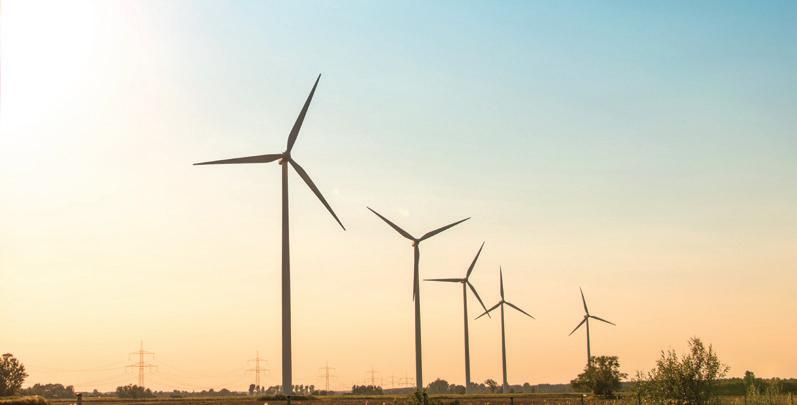
The City of Adelaide’s operations will be running on 100 per cent renewable electricity from 1 July 2020, under a new energy procurement deal.
The City of Adelaide is partnering with Flow Power to meet its electricity needs from a mix of wind and solar power in an effort to develop renewable energy generation and provide more jobs.
Lord Mayor of Adelaide, Sandy Verschoor, said that procuring 100 per cent renewable electricity was part of the City of Adelaide’s commitment to becoming a carbon neutral council and will reduce its emissions by approximately 50 per cent.
“The City of Adelaide is taking climate change seriously and this partnership demonstrates that we are taking real and meaningful action on climate change. We are leading the way in the transition to cost effective, clean and reliable energy,” Ms Verschoor said.
“From 1 July 2020, if it’s run by the City of Adelaide, it’s being powered by renewable electricity – the agreement is a first for any council in South Australia.
“This means that all our corporate and community buildings, council event infrastructure, electric vehicle chargers, barbecues in the Park Lands, water pumps, street lighting and traffic lights – everything that council operates – will be powered by renewable electricity.
“The electricity to be provided by renewable generation each year is equivalent to powering over 3800 homes. The switch will reduce emissions by over 11,000 tonnes or the equivalent of taking 3500 cars off the road.”
Ms Verschoor said that the switch was expected to see a 20 per cent cost saving compared to the City of Adelaide’s most recent contract.
“This partnership will not only save our rate payers money – it helps cement Adelaide’s international clean and green reputation.”
The electricity in the contract will be delivered from Clements Gap wind farm in mid-north South Australia and new solar farms on the Eyre Peninsula and in the South East. The Streaky Bay and Coonalpyn Solar Farms, which Flow Power has acquired from Tetris
Energy, are expected to help generate local employment opportunities in both construction and operational stages.
Flow Power Co-Founder and Director of Engineering and Projects, David Evans, said that the partnership with City of Adelaide would play an important role in driving investment in new renewable projects.
“This deal will provide crucial support to new solar projects in the state, creating jobs and helping to bring more renewables into the system.
“It’s evident that South Australia is a world leader in renewable energy. We have seen significant growth since opening our Adelaide office and are committed to driving the uptake of renewable energy in the state for the long-term.
“We view this as a long-term partnership, which will empower the city to fulfil its ambitious climate commitments and create opportunities to support the energy system.”
The City of Adelaide said that switching to renewable electricity was one of many ways it is taking action to address climate change.
In 2019, new solar panels were installed in four additional locations, increasing the City of Adelaide’s total solar power capacity to over 1.1MW and generating enough electricity to power 338 homes. Buildings such as the Adelaide Town Hall, works depots, car parks, Adelaide Central Market and Adelaide Aquatic Centre are being powered by on-site solar power, saving the City of Adelaide 12 per cent in building electricity use and over a quarter of a million dollars per annum.
ENERGY QUEENSLAND APPOINTS NEW CEO ADELAIDE BACKS RENEWABLES
Energy Queensland (EQ), parent company of Energex and Ergon, has appointed a new CEO to head up its Townsville headquarters.
The position was awarded to Rod Duke, who brings with him more than 34 years of executive and energy industry experience.
“Energy Queensland includes Australia’s largest electricity distribution company as well as an innovative energy services provider in Yurika, and a highly successful retailer – so it was important that a highly experienced CEO with significant contemporary energy experience and leadership was appointed,” Queensland Treasurer Jackie Trad said.
“In line with our 2015 election commitment, Energy Queensland’s headquarters is in Townsville.
“Mr Duke will work from Townsville and, as a reflection of EQ’s statewide business, divide his time between regional Queensland locations and Brisbane.”
Before joining Energy Queensland, Mr Duke held senior roles at
Santos, Singapore LNG Corporation, the energy market regulator in Singapore, and Woodside. He was most recently CEO of the Gladstone LNG project operating company for Santos and its partners.
Energy Minister, Dr Anthony Lynham, said, “Mr Duke brings a wealth of knowledge and transformational energy experience at a time when Australia’s energy sector is facing significant disruption.”
Energy Queensland Chairman, Phil Garling, said he was looking forward to Mr Duke taking up the position.
“The group of companies that make up Energy Queensland have a vision to energise Queensland communities, and have established a strong culture of safety, innovation and putting real value on the diversity of its people,” Mr Garling said.
“This provides strong foundations for Mr Duke to build on and, from our conversations to date, I already have great confidence for the future. Being born in Gin Gin and having lived and worked in Queensland for many years, Mr Duke understands the future challenges and importantly the heritage of our companies.”
NEWS 8 March 2020 ISSUE 9 www.energymagazine.com.au
SHELL MERGES GAS AND SOLAR WITH NEW PROJECT
Construction has begun on the Gangarri project, Shell’s 120MW large-scale solar farm in Wandoan, South West Queensland.
The solar farm will connect to the National Electricity Market grid with the capacity to generate enough clean energy to power 50,000 homes.
Up to 200 construction jobs are expected to be created during the construction of the farm.
Queensland Minister for Natural Resources, Mines and Energy, Dr Anthony Lynham, said the solar farm will generate clean energy for QGC’s natural gas processing plants, showing how gas as a transition fuel and clean energy assets can coexist.
“With Shell sanctioning this 400,000 panel solar farm it will become part of Queensland’s clean energy revolution, which is providing the world a practical template on how to transition to low emissions future,” Dr Lynham said.
“The Darling Downs and South West Queensland is literally an energy powerhouse, these regions have developed the unprecedented large-scale $70 billion onshore gas industry from a standing start, and now it is hosting some of largest clean energy generators in the country.
“I welcome Shell’s first global investment in an industrial-scale solar farm on Queensland soil and I am also pleased they have recognised the Iman people, the traditional owners of the land of where the farm will be constructed, and named the project Gangarri.
“Gangarri is a fitting name for the project, Gan meaning sun and Garri meaning light in the Iman peoples dialect.”
Shell Australia chairman, Tony Nunan, said solar will play an increasing role in the global energy system, especially when partnered with a reliable energy source such as gas.
“This is Shell’s first global investment in an industrial-scale solar farm, and we are proud to be investing in the ‘Sunshine State’ as a key centre of activity under Shell’s global ambition to expand our integrated power business,” Mr Nunan said.
“It will help power the operations of our QGC project and reduce carbon dioxide emissions by around 300,000 tonnes a year.
“It continues our long-standing commitment to the regional development of Queensland and creating thriving, diverse local economies.”
Dr Lynham said Shell’s Gangarri solar farm follows AGL and Vena Energy’s recent announcement about Queensland’s biggest battery near Wandoan.
“AGL and Vena’s battery will be a stone’s throw away from the Gangarri solar farm,” Dr Lynham said.
“Around $5 billion has been invested in renewable energy projects in Queensland since December 2016, creating 4700 jobs.
“Queensland now has almost 5500MW of renewable generation capacity.
“Shell’s Gangarri Solar Farm will help us remain well on track to reach our target of 50 per cent renewable energy by 2030.”

9 NEWS www.energymagazine.com.au March 2020 ISSUE 9

March 2020 ISSUE 9 www.energymagazine.com.au 10 INDUSTRY INSIGHT
Frank Tudor, Managing Director, Jemena.

Frank Tudor: MANAGING CHALLENGE AND CHANGE WITH CUSTOMERS AT THE HEART
As one of Australia’s largest energy infrastructure businesses, the eyes of the industry are often on Jemena for guidance and inspiration on the path forward in this brave new energy world. We caught up with Managing Director Frank Tudor to gain an insight into his vision for the business as we grapple with a complex and constantly changing environment.
Frank Tudor is an experienced energy industry leader in Australia, with more than 30 years’ involvement in the international oil, gas, and power industries, and having held various senior executive roles across the sector throughout his career.
Mr Tudor stepped into the Managing Director role at Jemena in October 2018, before which he was the CEO at Horizon Power – Australia’s only verticallyintegrated electricity utility which provides energy services to customers across regional Western Australia.
Coming up to 18 months in the role, Mr Tudor sat down with us to take stock of his time since commencing with the business, and to outline his vision for Jemena moving forward.
Mr Tudor says that his impression of Jemena as a business was very positive. He says that business operations in the last five to six years were pragmatic, leaving the company in a strong position.
According to Mr Tudor, it was this strong foundation, fostered by outgoing MD Paul Adams, that made for such a seamless transition of management between the two.
“We both acknowledged that there’d have to be some change, but again, those changes can only be made if you've got
a good foundation. We certainly had a brilliant foundation.”
Mr Tudor took a collaborative approach to the transition, spending a lot of time analysing the business and discussing it with shareholders. Mr Tudor acknowledged that Jemena’s streamlining of practises across the many businesses had made sense because of the common energy focus across them. He said that Jemena “had excellence” in the way it ran its processes, with common standards and approaches.
To enhance this, Mr Tudor decided that it was time to critically evaluate how the business was meeting customer needs across the Australian energy landscape and how it enacted the company’s ‘Bringing energy to life’ approach. To this end, he introduced market focused streams across the business and said that as technology and regulations change, so too does the competition, and that this approach would allow the business to be more flexible and competitive in the different markets.
“It drives autonomy and, inherently, it drives innovation.”
Mr Tudor has first implemented a separate focus on the different lines of business at an executive level. By appointing executive general managers (each with their own P&L, customer
and asset accountability), he believes each segment of the business has someone responsible for delivering on its individual objectives.
This methodology can be seen in the different branches of Jemena’s business, Mr Tudor says. On one end of the scale, Jemena runs a project and services business under the brand of Zinfra. Zinfra has its own independent presence in the market and therefore, requires its own stream of accountability, a “recognition that each one of those segments has got its own set of drivers, its own set of challenges, its own set of opportunities”.
Then in NSW, Jemena has a regulated gas business as well as an extensive unregulated gas business that covers the company’s transmission lines and extends all the way through the Northern Territory. In electricity, Jemena contributes to electricity distribution in Melbourne, which is going through significant changes as renewable energy continues to generate interest. In these large-scale lines of business, Mr Tudor says Jemena leverages a lot of expertise from parent companies State Grid of China and Singapore Power, both of which “understand energy intimately” to advise on best practice.
www.energymagazine.com.au March 2020 ISSUE 9
11 INDUSTRY INSIGHT

Embracing renewable opportunities
One of the key areas the business will be investigating moving forward will be renewables, in a variety of formats – solar, batteries, microgrids and possibly pumped hydro, which Jemena is just beginning to explore.
Mr Tudor says that the use of pumped hydro in China and Europe has demonstrated its role in renewable energy storage and reliability. It’s for this reason that Jemena is looking for opportunities in pumped hydro across Australia.
Currently, renewable energy is being complemented by the firming capacity that coal and gas provide, according to Mr Tudor, but reliance on fossil fuels can be reduced if there is an adequate storage solution. While fossil fuels won’t be eradicated entirely any time soon, Mr Tudor says that renewables will need to go handin-hand with gas, which is “the cleanest form of fossil fuel and very flexible”.
Lithium batteries offer an important contribution to sustainable storage but, Mr Tudor says, they’re better at managing transient or short-term volatility, rather than load shifts. Cue pumped hydro, which has the sustained capacity to store and generate energy when demand is high, but when the sun and wind are absent. While hydro presents an ideal solution, the key challenge with this form of renewable generation is construction, particularly around the many geological factors to consider.
“You’ve got to have the topography, you’ve got to have the water, and you’ve got to have the proximity to the right part of the grid as well,” notes Mr Tudor.
Mr Tudor says that a lot of pumped hydro project opportunities are already identified and under development, so Jemena is looking at a suite of projects across the
country, to see where they could best add value or collaborate with these developers.
Another focus area of the business is microgrids, with Jemena currently working with a range of commercial and industrial customers behind the meter. Mr Tudor describes microgrids as aggregated distributed energy resources which, he suggests, more than half of Australians will be using in some form one day.
“Like it or not, the path that we're currently on leads us towards a heavily distributed energy resource kind of future... it's a very important segment of the market.”
Mr Tudor said his time working at Horizon Power in Western Australia, and its significant portfolio of microgrids, gave him a unique perspective on the technology. He says a plan that involves working directly with customers and having a say in state government regulations is paramount in order to maintain stakeholder investment.
Hydrogen – a natural fit
A sense of trust and support from customers is something that’s echoed through in Jemena’s renewable gas ambitions. Jemena is exploring the potential to introduce biomethane into the network, through waste-to-energy technologies and is in consultation with a number of potential partners across New South Wales. In addition, Jemena, in collaboration with the Australian Renewable Energy Agency (ARENA), is advancing its Western Sydney Green Gas project (WSGG), which will install an electrolyser, produce hydrogen, and blend it into the network. Mr Tudor is confident this project will demonstrate that a blend of 10 per cent hydrogen can be introduced into the gas network without impacting customer’s appliances.
The $15 million WSGG project will explore three significant areas, including renewably produced hydrogen, long-term storage options and transportation.
The 500kW electrolyser will be the first of its kind in NSW and will produce enough energy to heat approximately 250 homes and businesses.
Mr Tudor is also optimistic about garnering interest in hydrogen buses and large vehicles, and the potential for hydrogen in the transport sector.
“As we move towards a renewable energy future, renewably sourced gas will become increasingly significant. In addition to its green credentials, hydrogen, biomethane and other alternative fuels will enable current assets to be utilised well into the future. The gas network can support these fuels which could, one day, see our 1.4 million customers in NSW having access to solar and wind generated gas, and enjoy the benefits of renewable energy just as those with rooftop solar panels, and without having to build expensive new infrastructure.
“It's important, I think, to demonstrate that the network can accommodate, that appliances can accommodate, and that customers can trust, renewably sourced gas.”
Price point is an issue for hydrogen, Mr Tudor admits, but in presenting hydrogen’s potential as a real, long-term strategy, the scope will increase, thereby driving costs down.
“We've got to actually present it as something that's a real option so that we can then bring a lot of attention, a lot of ingenuity, a lot of scale to bear,” Mr Tudor said.
Mr Tudor is encouraged by the COAG Energy Council’s National Hydrogen Strategy, published in November 2019. Australia’s Chief Scientist, and COAG Energy Council Hydrogen Working Group Chair, Dr Alan Finkel, wrote in the report, “Clean hydrogen as a fuel is now poised to become a reality.
“Energy is the foundation of civilisation. To meet future demand while avoiding the by-products of our current energy sources we have to find alternatives.
“These will be a mix of primary energy sources such as solar and wind electricity, and secondary energy carriers, of which hydrogen will make an essential contribution as a high-density, zeroemissions fuel.”
Mr Tudor said that this type of nationallevel strategy is something that Japan has implemented as a five-year energy policy with a goal of decarbonisation. Japan’s focus on creating a hydrogen industry
March 2020 ISSUE 9 www.energymagazine.com.au
12 INDUSTRY INSIGHT
Mr Tudor receives the Significant Investment Award for the NGP from Senator Simon Birmingham.

could result in the subsidisation of the start-up of export from countries like Brunei, Norway and Australia – an opportunity that Mr Tudor thinks will give hydrogen some credibility, and real legs as an industry in Australia.
Managing the transition
Even with these projects on the horizon for Jemena, Mr Tudor admits that the transition journey to renewables will be complex. Mr Tudor says that the Integrated System Plans (ISP) developed by the Australian Energy Market Operator (AEMO) is long overdue and will both strengthen the connections between state and territory-based electricity networks and integrate the development of new transmission lines to connect Renewable Energy Zones into the network.
The concept of concentrated renewable energy zones and a strengthened grid is encouraging to Mr Tudor, and one that he believes will help in the task of managing reliability, affordability and sustainability for the future.
Mr Tudor emphasises that distributed energy resources (DER) are still important as the energy industry establishes processes for integrating large-scale renewables into the market. He says that, so far, guidance on where and how renewables are to be developed and how they will operate has been scarce, and that’s come with some consequences –namely a congested grid. By this he means that the grid doesn’t have a buffer because it’s become fully loaded – something that the ISP is seeking to address.
If the hosting of distributed energy is uncontrolled, or overloaded, it can cause major power issues, Mr Tudor explains. As people install their own solar panels or
batteries, it creates a bi-directional flow of electricity that is difficult to accommodate given the original systems weren’t designed for this purpose. As hosting capacities increase, investments need to be made in dealing with power quality and protection issues, he says.
Though the magnitude of managing renewable energy transition can be daunting, Mr Tudor says that he can take comfort in the fact that nobody has got it completely figured out.
“There isn't a perfect recipe. Nobody has wonderful clarity about what the future's going to look like.”
One thing that Mr Tudor is clear on is the fact that gas will need to fulfil its natural role as a transition fuel in the swing to renewable energy through the next ten, 15, 20 years.
“We need to get the message out that gas has a significant role to play in the short, medium and long term, and that there are investment opportunities if we can get the landscape right.
“Our industrial customers tell us they want more gas supply and as an industry and business, we are working hard to enable new gas to come to market.
“We know Australia has vast reserves of gas which if unlocked it can be transported from remote areas to the high demand east coast by an interconnected network of pipelines.
“The Northern Gas Pipeline, from Tennant Creek in the Northern Territory to Mount Isa in Queensland is an important step in creating this network and we are already planning its expansion and extension should the predicted vast reserves of the Beetaloo Basin be realised. There’s enough gas in the Beetaloo to supply gas to the east coast for more than
200 years, although it’s still early in the development process.
“In the meantime, Southern reserves are declining and new, near-term affordable gas supplies are required. But there’s no single solution, no jurisdiction has found the silver bullet. We need to learn from the US and European markets considering imported gas as part of the integrated gas supply system. New gas developments such as Narrabri are required and efficient infrastructure investment is needed to bring this gas to customers at the lowest price.
The customer comes first
Working closely with customers, or a representative group of customers, is at the forefront of Jemena’s plan moving forward in order to establish trust and have a direct line of communication. Mr Tudor says it will also be crucial for the business to utilise its access to leading global companies in the sector through its shareholders.
Mr Tudor says that while in the energy industry we often talk about the three Ds - distribution, decarbonisation and digitisation - Jemena likes to also focus on the ABC of energy - access, balance and coordination and collaboration.
Access obviously refers to customer ability to utilise energy sources; and also has a focus on equity too. Balance refers to things like the right balance of thermal generation versus renewable energy; and innovation with reliability, in order to keep the lights on. Coordination and collaboration meanwhile refer to industry partnerships Jemena has established with the view to providing better outcomes for customers.
A clear example of this is The Energy Charter, which has seen energy businesses across Australia sign up to be publicly accountable for their actions.
Mr Tudor also says that at the heart of Jemena’s operations is an ethos of reliability, affordability and sustainability. He remains clear though, that whether it is long-term or short-term goals, sunken or future investments, Jemena will need to collaborate with its customers, and the industry to get there.
In a time of immense change within the energy industry, it’s exciting to see where leaders such as Mr Tudor will steer the ships they’re captaining. Jemena has a clear mandate for what it wants to achieve, and a sensible approach to an industry in transition.
After his own period of transition into managing the energy giant that is Jemena, the path has clearly been set: now it’s about moving forward and achieving the goals that have been put in place.
www.energymagazine.com.au March 2020 ISSUE 9 13 INDUSTRY INSIGHT
Mr Tudor cuts the ribbon to celebrate construction of the Northern Gas Pipeline.

CLEAN ENERGY INVESTMENT COLLAPSE:
WHAT CAN WE DO?
New investment commitments in large-scale renewable energy projects have collapsed by more than 50 per cent according to new analysis by the Clean Energy Council, which reveals a fall from 51 projects worth $10.7 billion in 2018 down to 28 projects worth $4.5 billion in 2019. We caught up with Clean Energy Council Chief Executive Kane Thornton to understand what this downturn in investment means for the industry, and gain insight into how we can turn the current situation around.
March 2020 ISSUE 9 www.energymagazine.com.au
14 SOLAR AND STORAGE

 Kane
Kane
Thornton.
The new research from the Clean Energy Council shows that while the strong flow of projects that were committed in 2017 and 2018 are now coming online, the pipeline of new projects commencing construction has dropped significantly due to the stalling of commitments in 2019.
Clean Energy Council Chief Executive Kane Thornton said mounting regulatory risks, under investment in transmission and policy uncertainty have contributed to increased risks for investors, and resulted in a lowering in confidence and slow-down in investment commitment for large-scale renewable energy projects.
“What this data tells us is that there’s a slow down in new investments, and that is starting already to trickle through the industry,” said Mr Thornton.
www.energymagazine.com.au March 2020 ISSUE 9 15 SOLAR AND STORAGE

“As the current wave of projects under construction reach completion, there is going to be, and there is already, a slowdown in the level of construction activity within the industry.
“Ultimately, that will mean less work, less jobs in the industry, and essentially less activity at the large-scale side of the industry.
“A continued slow-down in new investment will put greater pressure on reliability and power prices as Australia’s old coalfired power stations continue to close. New investment is critical to replacing these coal-fired power stations and delivering on Australia’s emission reduction targets.”
Investor confidence
This reduced investment confidence was reflected in the Clean Energy Council’s recent Clean Energy Outlook Index, which revealed a clear fall in investor confidence in the sector.
The top reasons for a decline in investor confidence were grid connection issues, a lack of strong national energy and climate policy, and network congestions and constraints.
Many of the rules relating to grid connection, network investment and market design are no longer fit-for-purpose, and are a significant deterrent to potential investors.
“These issues need to be resolved urgently if Australia hopes to attract investors and ensure the necessary level of new energy generation capacity.”
According to Mr Thornton, the results that are gathered through the Clean Energy Outlook Index reflect what he hears anecdotally from key players in the industry.
“Recently I met with an international company that’s been very active here in Australia. The message from them is that when they tally up all of the different challenges they now face in Australia, such as policy uncertainty, when you add all of that up together, it just adds uncertainty and adds risk.
“These investors are sitting there with a pipeline of projects right around the globe, and they want to invest in Australia, we’ve got great renewable resources, but we are a higher risk option than any number of dozens of countries around the world where, to be frank, their policy makers and regulators have worked harder in preparing for this moment in time, and things are smoother. They can manage their risk, and they work through risks more easily than they can in Australia at the moment.”
What can we do?
So in the face of ongoing federal policy inertia, which doesn’t look like changing any time soon, what can the renewable energy industry do to bolster confidence and try and get the industry moving?
Mr Thornton says it’s important to note the work that state and territory governments around Australia are currently undertaking, with the ACT, Queensland and Victoria being particularly obvious examples.
“We’ve seen a number of state governments step into the market to provide policies and to provide that certainty, and I think that does help to prop up the current level of investment.
“It’s not ideal, we’d rather it be done nationally, and in a coordinated fashion. But there are opportunities there.”
For Mr Thornton, the other obvious area for the renewable energy industry to tap into is the corporate market. As we see more and more large corporates becoming frustrated with the lack of a clear, national energy policy, increasingly these businesses are looking to procure and secure their own energy supply from renewables.
“The Power Purchase Agreement market is something that’s growing,” said Mr Thornton. “And with businesses like Telstra, BlueScope and Sun Metals all looking to secure their own renewable supply, it obviously presents an opportunity for renewable developers.
“The silver lining to our recent research is that we’ll continue to see projects go ahead at some rate – not an ideal rate, but at some rate anyway.”
Short-term pain, long-term gain
The other thing Mr Thornton is keen to point out is that while the current level of investment has fallen, the long-term future for renewables investment is very bright.
He points to a raft of new investment that is coming for the transmission side of the industry, which will allow for the increased uptake of renewable technologies.
“My assessment is that while the short-term is going to be a bit challenging, the long-term outlook is very bright,” said Mr Thornton.
“It’s very bright because of the fundamentals. The cost of renewables has come down, our old coal fire generation is old and getting older, and there’s an inevitability about coal coming out of the market.
“And finally, despite a decade of climate policy wars, the climate change issue hasn’t gone away, and in fact it’s become more serious. There’s an inevitability about Australia having to reduce our emissions. We know that renewable energy is where the heavy lifting has been done, and can be done in the future.”
Mr Thornton points to the horrific summer bushfire season as further evidence of this.
“The Australian public I think have seriously awoken to the reality of climate change in a way that I don’t think they might have previously.
“The community, and the business world, are both realising the damage and the risk from climate change, and very clearly, I think that’s shifting behaviour. That’s about the purchasing decisions that are made, the grassroots movements, the decisions by big business, right through to the ballot box into the future.
“There’s a shifting of sentiment around climate change. The Australian public likes renewable energy, and they want more of it. We’re going to see that increasingly shift to drive our political leaders to get onboard in a way that they struggled to historically.
“So I think we all know what the future looks like, the question is just how we get there.”
March 2020 ISSUE 9 www.energymagazine.com.au
16 SOLAR AND STORAGE
The recent summer bushfire season has served to heighten the community’s resolve to transition to clean energy, according to Kane Thornton.
Drive more piles, more accurately

Semi-autonomous pile driving technology combines the Vermeer PD10 pile driver with Carlson PDGrade machine guidance to:
• Increase productivity
• Improve safety
• Eliminate stringlines
• Reduce survey costs
Get in touch today:
info@positionpartners.com.au
www.positionpartners.com.au Australia
• New Zealand
• SE Asia
1300 867 266 Precision Solar Farm Technology
AUSTRALIA LEADS STORAGE IS
by Marie Lam-Frendo, Chief Executive Officer, Global Infrastructure Hub
The role energy storage will have to play in the global shift towards increased renewables uptake cannot be understated, according to Global Infrastructure Hub Chief Executive Officer Marie Lam-Frendo. Here she looks at the influence Australian projects, such as the Hornsdale Power Reserve, are having on investors and developers around the world.
 Marie Lam-Frendo
Marie Lam-Frendo
The future of energy storage is becoming increasingly important in light of the trends in global energy supply and demand. In its World Energy Outlook 2019, the International Energy Agency’s (IEA) figures show that although the production of renewable energy is increasing, it is being outstripped by the rise in overall energy demand. This means the percentage of global demand being met by renewables is barely moving and
consequently, energy-related carbon emissions continue to rise and are unlikely to peak until 2040 if the world continues on its present path.
Storage has incredible disruptive potential for the energy industry. It is one of the best available avenues we have for speeding up the integration of renewables into the energy mix and solving a raft of connected energy problems along the way. As the demand for electricity rises vis-a-vis other primary energy sources due to consumer technology trends (such as
March 2020 ISSUE 9 www.energymagazine.com.au
18 SOLAR AND STORAGE
LEADS THE WAY THE KEY AND
electric cars and mobile devices), there is a corresponding increase in the opportunity that energy storage presents.
How exactly can energy storage help solve the massive energy demand versus emissions reduction conundrum? While the answer is not yet fully in our grasp, we now have at-scale examples which I believe are instructive of the way forward.
The Hornsdale Power Reserve (HPR) located in South Australia is an illustrative case of energy storage innovation. Currently the world’s largest lithium-ion battery at 100MW capacity and 129MWh storage, the system is owned and operated by Neoen, uses Tesla powerpacks and was initiated via a Twitter exchange between Tesla CEO Elon Musk and Atlassian cofounder Mike Cannon-Brookes. Following devastating storms and associated blackouts in the state, the South Australian government required a grid-connected
solution which could both provide back-up storage and rapidly respond to emergency events. Located next to the 300MW Hornsdale Wind Farm, which is its charging source, HPR supports the integration of renewable energy in South Australia, trading on the spot market when energy demand is high. HPR has demonstrated its value since coming online, responding to multiple grid stability issues with speed and precision, leading to the recent decision to expand the battery’s capacity to 150MW by July 2020.
Two other large-scale renewable energy projects in the pipeline point to the opportunity battery storage is presenting. Mr Cannon-Brookes is one of the early backers of the ambitious Sun Cable project, which will be a 15,000-hectare solar array in the Northern Territory. Sun Cable will be supported by battery storage and linked to Singapore via a high voltage
cable, intended to significantly reduce Singapore’s dependence on natural gas. The battery required to support this solar production will be an incredible 150 times the size of the HPR. Across the Pacific, Warren Buffett is behind the Gemini Solar and Storage project in the United States’ Nevada desert through Berkshire Hathaway subsidiary NV Energy. It will use electricity generated by the 2,900-hectare, 690MW solar plant, supported by 590MW of battery storage for dispatch during Nevada’s early-evening peak.
The economic case for battery storage has taken a great leap over the past decade. Part of this can be explained by the precipitous drop in the cost of energy storage systems. A study by McKinsey & Company found that between 2012 and 2017, the cost of a utility-scale system fell by more than 20 per cent each year. It took solar photovoltaic and wind technologies
www.energymagazine.com.au March 2020 ISSUE 9 19 SOLAR AND STORAGE

much longer to achieve the same degree of cost efficiencies.
The other part of explaining storage’s great economic case leap is the variety of ways it can be used, or to put it another way, the number of problems it can solve.
The South Australian HPR project has demonstrated that battery storage is moving in the direction of doing much more than providing power reliability and backup, important though that is. Frequency regulation, firming and smoothing the variability of solar and wind power, load following and other grid support services are functions of increasing value to governments and regulators concerned with energy security and utilities seeking competitive advantage and diversifying their business models. Meanwhile, an increasing number of businesses and prosumer households are benefiting from deploying their battery units to optimally manage their solar and use of the grid to cut their power bills. What’s more, batteries will increasingly enable efficiencies at the neighbourhood level, with entire locales able to partially or fully sustain themselves and be net contributors to smart grid energy needs.
There is, or has been in the recent past, a widely held perception that technology which supports infrastructure, or InfraTech, is very expensive. While this may be true for mammoth projects like Sun Cable, which
is of an unprecedented scale, the HPR cost a reasonable $90 million, and within its first quarter of operation, had already facilitated approximately $33 million in cost savings for grid stabilisation services, also creating the potential for consumers to benefit from reduced power prices.
Infrastructure has historically been an industry slow to adopt technological advancements. It has become clear that governments and industry leaders need to make intentional commitments to adopt tech solutions in infrastructure and set incentives for the adoption and supply of InfraTech. InfraTech is a focus this year for the G20, and the Global Infrastructure Hub is playing an active part in this work because of the role technology and innovation can play in infrastructure, not only creating economic benefits, but also addressing environmental, social and governance (ESG) challenges.
These ESG challenges are becoming increasingly important to investors. In 2019, the Global Infrastructure Hub, in partnership with EDHEC, released an investor survey of over 300 leaders across all markets, in which 36 per cent identified achieving ESG objectives as a “first order question”. This was more than double the percentage from 2016. This sentiment turning into action is evidenced by the increasing number of climate finance initiatives such as the Climate Finance
Partnership, set up by the governments of France and Germany to invest in climate change-linked infrastructure upgrades in emerging markets. In January this year, BlackRock, the world’s largest fund manager, announced a $US100 million commitment to the fund which will go toward renewable energy, energy efficiency and storage solutions.
Private sector innovation, as well as financing, will be crucial to achieving new storage-optimised energy business models and data-driven solutions. To prove the point on innovation, we need look no further than the rapid deployment of the HPR, which was installed and working 100 days from contract signature, as Musk had promised on Twitter. To be sure, the acceptable level of risk is lower for most investors than it is for billionaires (such as Musk, Cannon-Brookes and Buffett), and herein lies the challenge: attracting the capital needed to scale up emerging energy storage technology, including alternatives to lithium-ion batteries, to support the transition to clean energy on a global scale. The public and private sectors each have their roles to play, and I believe increasing how effectively they interact, such as by creating space for innovation in energy contracts, will determine whether the 2020s become known as the decade for emissions reduction led by the mass uptake of renewables and energy storage.
March 2020 ISSUE 9 www.energymagazine.com.au 20 SOLAR AND STORAGE
COUNT ON THE TRACK TRENCHER AND TEAM THAT DELIVERS.
Vermeer’s range of Commander® Track Trenchers have been helping deliver major infrastructure projects throughout Australia and the Oceania Region for over 30 years. Our nation-wide dealer network is there to support you on-site and in the project office, backed by a global network over 6,000 people in 60 nations. Contact us to learn how we can support your project. /









VERMEER Vermeer and the Vermeer logo are trademarks of Vermeer Manufacturing Company in the United States and /or other countries. © 2019 Vermeer Equipment Holdings Pty Ltd. All Rights Reserved. Overseas model shown.
VermeerAustralia VERMEER.COM.AU | 1300
JOB DONE.
BATTERIES –LET’S MAKE THEM SWEET NOT SOUR
by Michael Lewis, Media and Communications Manager, Energy Networks Australia
Batteries are a great complement to solar installations, but at the moment, they’re not optimised for peak performance. Here, Michael Lewis, Media and Communications Manager at Energy Networks Australia, outlines some steps that could be taken to achieve the desired response from batteries.
Batteries can be like the grid’s sugar hit.
They deliver quick, short bursts of energy. The problem is the sugar crash.
Like serving red cordial at a six-year-old’s birthday party, the energy crash hits hard and all at once – not good news for the parents/grid.
There are currently no useful incentives to smooth battery usage.
Most systems start to charge as soon as the house’s solar starts generating in the morning and discharge rapidly, early in the evening – all of them in a similar way and all at the same time.
Often these cycles are short, meaning both imports and exports are reduced for only short periods, generally not at ideal times.
If left unchecked, this trend will lead to unnecessary, extra investment in grid infrastructure and on-call generation, such as gas or pumped hydro. This is expensive.
But what if we adjusted our battery usage to smooth out demand?

What happens now?
We can see what currently happens in a typical household using actual data from Powerlink (see Figure 1).
The blue line is household demand, and the yellow shading shows when the battery is either charging or discharging.
In this scenario, the house has a solar PV system and battery storage capacity. Most batteries are installed with solar.
Morning
In the morning, people typically leave for work and demand drops.
As the sun rises, solar generation kicks in.
The battery begins charging at its maximum rate, soaking up all the excess solar generation.
After a few hours, the battery is full, and from then the solar generation is fully exported to the grid.
This means the household is now exporting solar PV at its maximum capacity during the time of minimum demand.
The minimum demand has not changed – the battery is not helping manage local voltage and the congestion issues caused by solar generation.
Evening
The opposite happens at night.
People return home and begin turning on appliances leading to a spike in demand.
The fully charged battery system discharges at its maximum rate until it is depleted.
For the remainder of the evening, the household is now importing electricity, a time when we have least generation capacity in the grid.
The peak demand remains high.
Depending on the size of the battery, the household may switch from battery supply back to grid supply at the time of peak demand, exactly what we don’t want to see happening.
March 2020 ISSUE 9 www.energymagazine.com.au
22 SOLAR AND STORAGE
Figure 1. Impact of battery on household demand – present behaviour (image courtesy Powerlink).
What do we want to happen?
If this example happens on a large scale, the sharp changes in solar import and exports could be detrimental to the wider grid. These rapid shifts in demand may be difficult to manage and risk system stability.
Instead of adding to the peaks and troughs, it would be great if batteries can be used to smooth out the grid.

The desired response from the system perspective is to reduce the peak export and consumption of the household, without a net change to the amount of electricity imported and exported.
Morning
Rather than the battery immediately charging at its maximum rate, it charges slower but for longer.
This could be done by partially charging and partially exporting.
Ideally, the rate of charging would slowly increase to a maximum at around 11am. Charging would then taper off again through the afternoon.
This could also be coupled with the use of “smart” appliances, such as washing machines, dishwashers, pool pumps or water heaters, to run when solar PV is generating.
The result is a smoother demand curve meaning the battery is having more of an impact when the grid needs it.
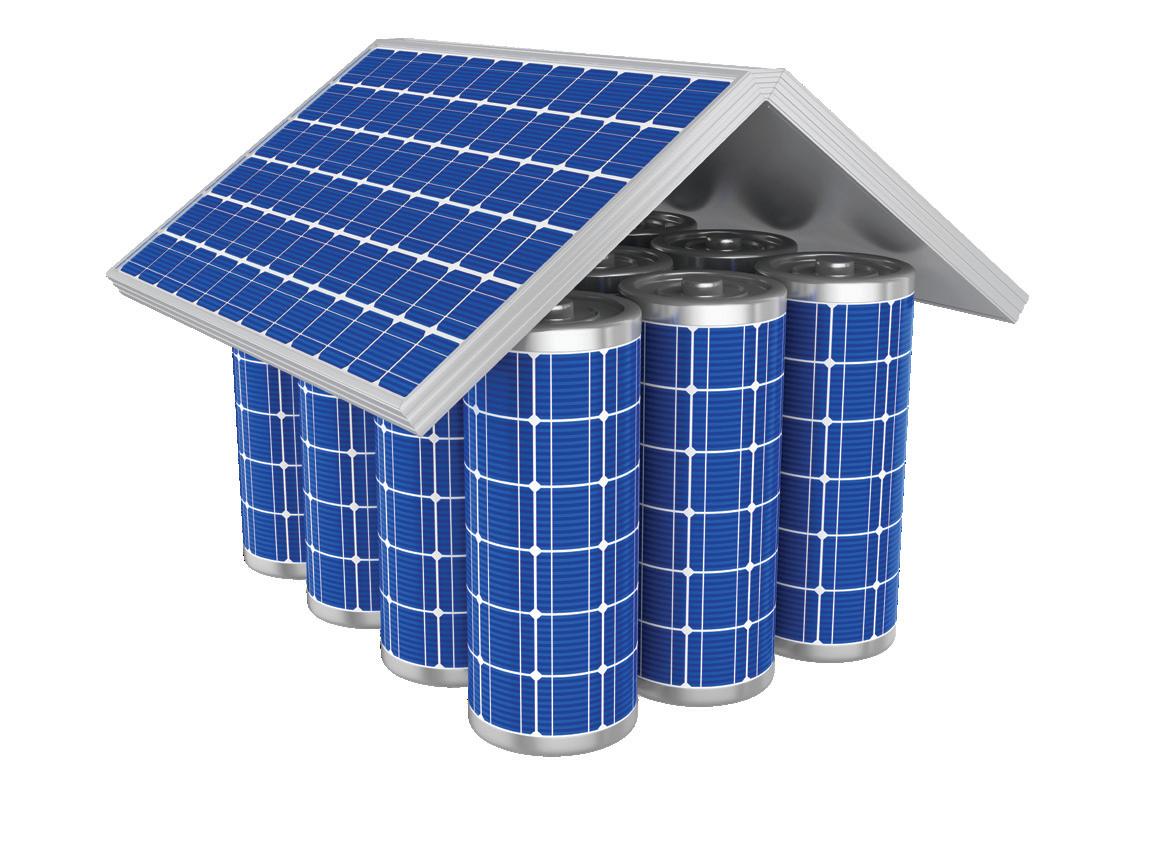
Evening
At the end of the day when the customer returns home, they have a full battery.
Instead of this battery discharging at its maximum rate, the local system partially imports and partially draws from the battery. This smooths the evening demand.
Overall the customer has not had to export any less or import any more electricity than normal, but the entire grid benefits from smoother demand.
How do we achieve this?
This concept of demand shifting is not new and is something we’ve written about before as ways to address the duck curve that exists because of the high penetration of solar in our grid.
The problem faced here is coordinating this response for millions of individual customers and systems around the grid.
Generally speaking, we’d prefer carrots to sticks – it is not optimal to regularly restrict exports of clean energy nor to try and force customers to only part-supply from their charged batteries.
What we could do is introduce demand-based price signals for both import or export, which would enable those with solar and battery systems to save money – while delivering benefits for all electricity customers.
Tariffs are being looked at in other jurisdictions around the world, such as Hawaii, to incentivise optimal battery use.
Overall benefits
If we can incentivise battery owners to flatten demand, we can avoid building unnecessary infrastructure spending.
This means all customers don’t pay more than they need to while maintaining a stable grid.
In the long term, smarter technology will combine with battery storage to offer cheaper and more flexible grid management solutions.
For the moment, we need to dilute the cordial to avoid hyperactivity.
www.energymagazine.com.au March 2020 ISSUE 9 23 SOLAR AND STORAGE
Figure 2 shows how the system should ideally look.
Figure 2. Impact of battery on household demand – desired response (image courtesy Powerlink).
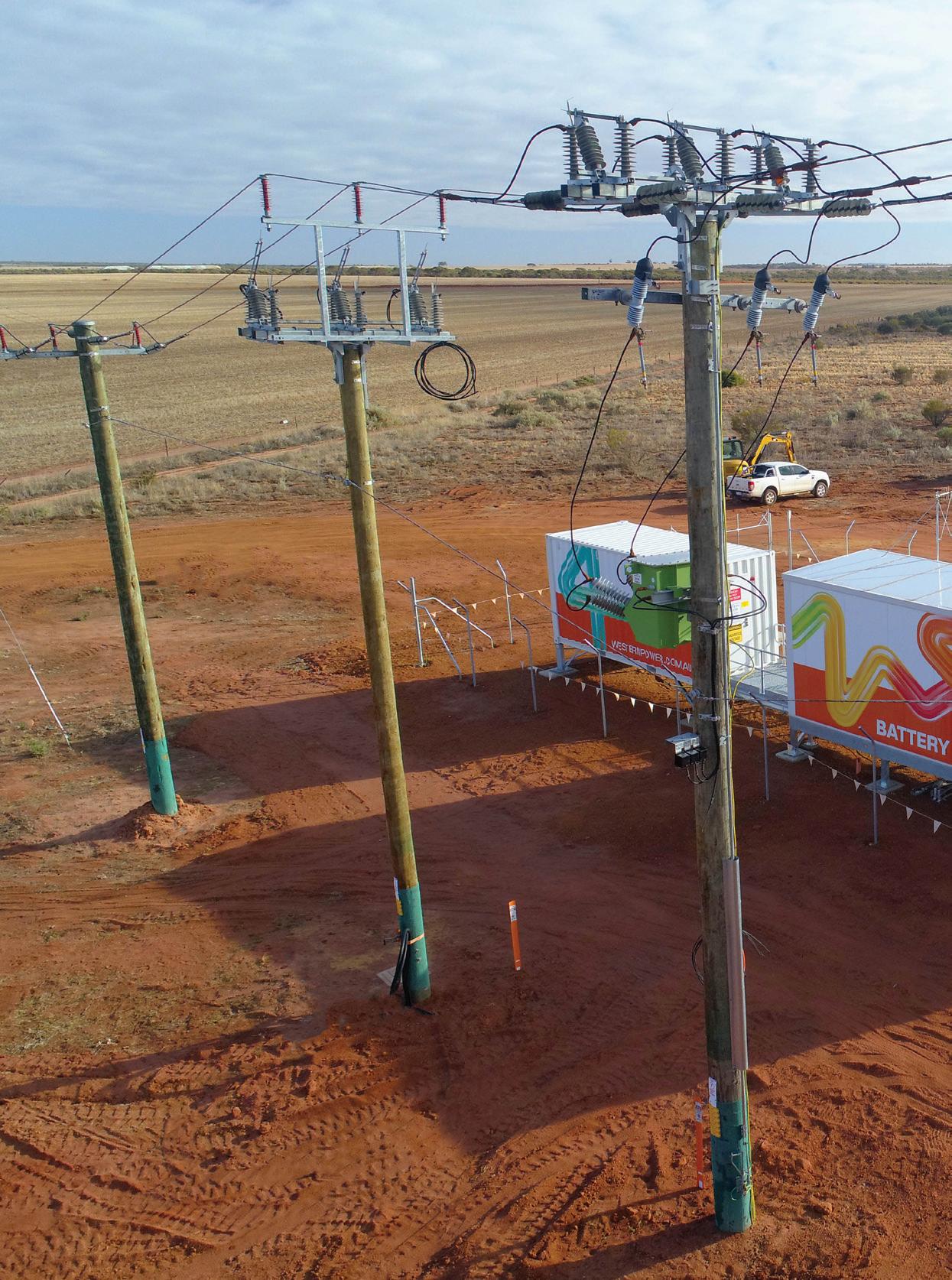
WRITING THE BOOK ON INTEGRATING UTILITY-SCALE BATTERIES INTO THE GRID
In remote communities, ensuring reliability can be one of the greatest challenges facing a network operator. Western Power has recently discovered the power a Battery Energy Storage System can provide if the network is ever disconnected; and in the process of connecting their system to the grid, effectively written the book on utility-scale battery integration into the grid.
March 2020 ISSUE 9 www.energymagazine.com.au 24 SOLAR AND STORAGE

The town of Perenjori, which sits between Perth and Geraldton in Western Australia, has a reliability story familiar to other regional centers spread out over the vastness of Australia.
Serviced by a single 75km long feeder line from Three Springs, the town’s power supply is subject to the elements – which in these parts of the west are unpredictable and volatile.
Anyone living in the town prior to 2016 would have said unplanned power outages were a fact of life. Back then, Perenjori averaged around eleven outages a year, totaling nearly 30 hours.
Western Power Project Manager Ian Anderson said this customer experience was unacceptable for homes and businesses in the community, and a source of frustration for crews on the ground and engineers searching for solutions.
“The stark reality was that our approach to improve the reliability through traditional maintenance and investment was not returning the improved reliability performance we wanted for homes and businesses in Perenjori,” Mr Anderson said.
www.energymagazine.com.au March 2020 ISSUE 9 25 SOLAR AND STORAGE
Western Power’s Battery Energy Storage System in Perenjori.
“When you get those long single lines like the one running to Perenjori, many different things can cause an issue, from falling tree branches through to a more serious fault.
“Although 90 per cent of the time it would be something simple, it takes time for a crew to patrol the line, find and remedy the issue – sometimes a few hours. During that time, the town has no power.”
So Western Power – in a world-first – installed a large community Battery Energy Storage System (BESS) for the town that could instantaneously provide up to four hours of power if the line went down.
On first glance the concept was simple but, as with all technology trials, the devil was in the detail and as this was the first attempt at a BESS integration into an existing network, the details didn’t really exist.
Mr Anderson said that while the base technologies (lithium ion batteries, industrial inverter/charger systems) were well proven and relatively low risk, the way they operated together and with the network interfacing control systems was new and unproven.
“Battery storage systems are generally not set up at the end of long line; rather, functioning either continuously connected to the power network, or as a backup after power has been lost,” he said.
“And this system, which is always online, operates fully autonomously to monitor the state of the network, detects faults back into the HV backbone and can instantaneously disconnect from the grid – all while supporting the town of Perenjori with no power interruptions – had never done before.
“As there was little directly relevant knowledge anywhere to draw on, we had to decide on operational parameters by design, intuition and sometimes on best guess.
“In effect, we have written the book on how to integrate utilityscale batteries into the grid. The benefits have far outweighed the struggles, the swearing and the long hours of problem solving.
“Given most of the time Perenjori only lost power for a couple of hours, the battery will hopefully tide them over while the fix was happening and reduce the amount of time without power during more serious faults.
“An automated SMS notification system also provides warning to the community of impending outages,” said Mr Anderson.
BESS was installed on the outskirts of town in 2018 and is normally connected in standby mode and kept charged by the main network.
“As it was the first time anyone had installed anything like this in Australia, we learnt a lot through the installation process. It took us longer to integrate the battery into the network than we expected, but we have persevered and it’s now working really well.”
The town’s residents have been an important part of the process, embracing their role as trial participants and feeding back to the project team to help find and rectify issues.
Mr Anderson said there was an enormous sense of achievement from the team in conquering the seemingly never-ending stream of technical challenges the BESS project presented. Importantly, these successes have translated into improvements for the families in Perenjori and their energy lifestyles.
“The community has said that being able to finish cooking meals, not losing unsaved documents on computers, and even the tiny things like not resetting digital clocks nearly a dozen times a year are the customer experiences that matter.
“One of the big successes has been the SMS message the Perenjori residents receive when the line goes down, letting them know that BESS has kicked in and is supplying them with power they otherwise wouldn’t have had. It also lets them know if BESS is running low on power, so they can prepare for a potential outage rather than be caught off guard.
“Removing the suddenness of an unplanned outage from the customer’s life has given them back the power to make choices and plan better. These things rarely show up on blueprints but are often the outcomes that really matter.”
Results from 2019 suggest BESS is really paying off, with Perenjori avoiding over 25 hours of outages in the first 18 months of operation.
“We have had less issues on the feeder line this year, so typically the number of outages would be higher. But either way BESS has covered most of the ones that have happened, so the town only had just over five hours total of power outages last year.
“Although BESS was expected to have a minimum of two-hour charge, it has exceeded expectations, powering the town for longer stretches of four to five hours.
“BESS also helped us during planned maintenance works, supplying power to the town. That meant we’ve been able to do upgrades to the line without impacting homes or businesses in the Perenjori township at all.
“Now we’ve tested and shown how well this kind of community battery unit can work for end of the line locations, we can look to other places where this might work as part of our modular and autonomous network,” Mr Anderson said.
“It feels great to have some real solutions for our rural customers.”




March 2020 ISSUE 9 www.energymagazine.com.au
26 SOLAR AND STORAGE
An example of some of the text messages Western Power customers connected to the BESS receive when it is operational.

Your partner in digital transformation.
Hexagon PPM helps the world work smarter. Our solutions for EPC’s and asset owners are designed to tackle today’s project complexity, deliver business returns and ensure safety through reliable, efficient operations.
• Enterprise Project Performance
• Front End Engineering and Design (FEED)
• Procurement and Materials Management
• Construction Management
• Fabrication
• Completions & Handover
• Operations and Maintenance
• Shift Handover & Situational Awareness
• Mobile Workforce
Visit hexagonppm.com or call +61 3 9856 1943 to find out how partnering with us will digitally transform your business and give you the competitive advantage to thrive in the Australian energy sector.



March 2020 ISSUE 9 www.energymagazine.com.au 28 SOLAR AND STORAGE

A RENEWED OUTLOOK ON RENEWABLES
With so much conversation surrounding climate change and companies’ responsibility to make a positive environmental impact, an increasing number of Australian energy companies are branching into the renewables space. One of these is the Australian Pipeline Trust (APA), traditionally an owner of gas transmission assets, which has invested time and money over recent years to not only develop solar and wind projects, but source 50 per cent of its electricity generation capacity from renewables.
By diversifying and moving into the development of renewable energy projects across Australia, APA is working towards its goal of shifting towards a sustainable, lower carbon future. While meeting this goal will certainly strengthen the company, an APA spokesperson says that its purpose is also to strengthen communities with responsible energy.
“This involves thinking about doing the right thing by communities, people and the environment. It goes to the way we do business as well as the investments we make,” the APA spokesperson said.
In 2010, APA’s board endorsed renewable energy as an investment stream for the business. Since then, APA has invested approximately $750 million into renewable projects across Australia.
“These include three wind farms at North Brown Hill, Emu Downs and Badgingarra, and three solar farms at Emu Downs, Badgingarra and Darling Downs,” the APA spokesperson said.
APA has made a huge impact with its clean energy initiatives over the past decade, particularly with half of its electricity generation capacity being
sourced from renewables. With this in mind, it’s no surprise that its clean energy initiatives will save over 8.5 million tonnes of greenhouse gases from being released into the atmosphere over the next quarter century, as well as providing energy for over 220,000 homes each year.
Why diversify?
APA’s renewable energy projects have developed in alignment with recommendations from the Taskforce on Climate-related Financial Disclosures (TCFD) and with acceptance of the Intergovernmental Panel on Climate Change’s (IPCC) assessment of climate change science – that the climate is changing as a result of human influence. In short, it is an initiative borne from the company’s belief that climate change is one of the most significant issues facing both the energy industry and Australia as a whole.
The APA Sustainability Report for FY2019 stated that diversifying is part of APA’s view to being more sustainable. For the company, being sustainable means to be active in helping to displace more carbon-intensive energy options like coal or oil, both in Australia and overseas and
www.energymagazine.com.au March 2020 ISSUE 9
29 SOLAR AND STORAGE

to achieve that, APA has a view to continue to grow and build its portfolio of renewable energy assets – specifically, wind and solar.
Renewable projects
APA’s $750 million portfolio of renewable energy projects has a total nameplate capacity of more than 470MW, including projects currently under construction. While APA is actively exploring the design, testing and commercialisation of clean energy sources such as hydrogen and renewable methane, the majority of its current renewable energy endeavours are wind and solar projects.
Wind projects
APA’s 132.3MW North Brown Hill Wind Farm at Hallett in South Australia is expected to save a total of 355,000 tonnes of carbon emissions each year for the next 25 years, making a total saving of 8,875,000 tonnes. It consists of 63 wind turbine generators and has a long-term offtake arrangement with AGL Energy for both the electricity generated and the renewable energy credits produced.
The 80MW Emu Downs Wind Farm is expected to save 232,000 tonnes of carbon emissions and was the first Australian wind farm to be equipped with state-of-the-art blades manufactured by Vestas at its Portland facility in Victoria. Construction of the $180 million Emu Downs Wind Farm project started in November 2005 and consists of 48
turbines, a substation, interconnection to the main 132kV electricity grid, administration and stores buildings and a network of access roads. At its peak, it supplies 50,000 homes per year with clean energy and is expected to save 232,000 tonnes of carbon emissions each year over the next 25 years, making a total saving of 5,800,000 tonnes.
APA has also entered into a long-term agreement with Alinta that underpinned the development of the 130MW Badgingarra Wind Farm. The Badgingarra Wind Farm, which was completed in early 2019, is just north of the existing Emu Downs Wind Farm and Solar Farm. It consists of 37 Siemens 3.6MW wind turbines which are connected to the Western Power electricity grid. The turbines are installed at a height of 85m with a tip height of 150m which will help to supply more than 115,000 Western Australian homes with clean energy. The initiative will save more than 420,000 tonnes of greenhouse gas emissions each year.
Solar projects
Co-located with the Emu Downs Wind Farm is the 20MW Emu Downs Solar Farm, which is underpinned by a power purchase agreement with Synergy as well as funding from the Australian Renewable Energy Agency (ARENA). Completed in early 2018, the solar farm spread over 70 hectares and was made possible through $5.5 million in ARENA funding. The solar panels are fitted
on a tracking system to ensure that the maximum amount of solar is collected.
The 17.5MW Badgingarra Solar Farm (BSF), which commenced commissioning in August 2019, is adjacent to the Emu Downs farms and co-located with the Badgingarra Wind Farm, which together created a 250MW renewable energy precinct. The BSF consists of 62,000 panels across 40 hectares of land and uses a NEXTracker single axis tracker system to provide a total output of 17.5MW to the Western Power grid. The potential output of BSP could power over 6,000 Western Australian homes and save up to 32,900 tonnes of greenhouse emissions each year. APA has also entered into a longterm offtake agreement with Origin Energy to develop a 110MW solar farm in Queensland’s Darling Downs in accordance with a $20 million ARENA grant. The solar farm has approximately 430,000 solar panels covering 250 hectares and was officially opened in November 2019.
In total, APA owns and/or operates over $21 billion of energy infrastructure across Western Australia, South Australia, Victoria, New South Wales and Queensland. With sustainability and clean energy production at the forefront of APA’s vision and of the broader Australian energy industry’s vision for the future, these assets and their impact are only expected to grow.
March 2020 ISSUE 9 www.energymagazine.com.au
30 SOLAR AND STORAGE
PURE HYDROGEN, ZERO EMISSIONS
At ANT Energy Solutions, we use only the best technologies in our custom-made renewable energy systems for the creation and use of Green Hydrogen as a 24/7 energy source. Using both state-of-the-art PEM or alkaline electrolysers from our partner Hydrogenics, a simple, robust interface splits water into hydrogen and oxygen. The created hydrogen can then be used immediately or stored for future energy requirements.
ANT Energy Solutions is serious about next generation electrolysers and are passionate about creating effective products and solutions for Australia’s transition through the supply of reliable, renewable and secure energy supplies. With a research and development program supported by the government Cooperative Research Centres Projects (CRC-P) grant, scaled down electrolysers are being developed which will allow for greater flexibility and affordability for energy consumers than ever before. This is ANT Energy Solutions commitment to providing real energy security for Australia and our trading partners.
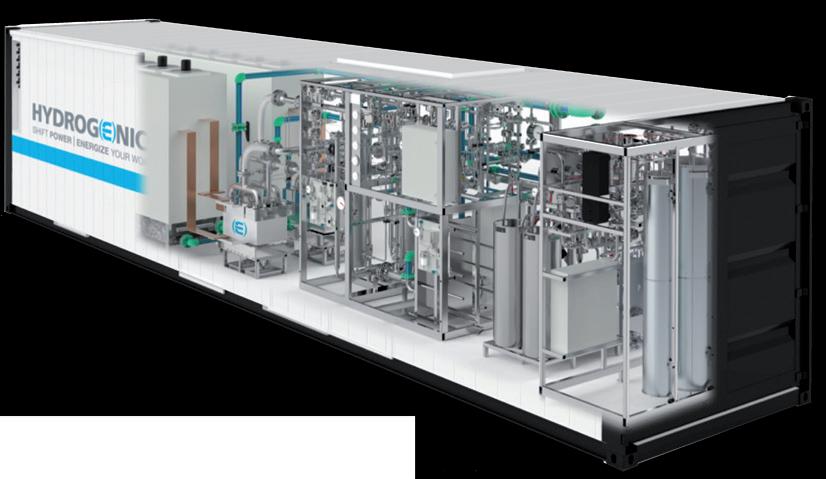
www.antsolutions.com.au
Electrolysers
and
fuel cells
APPLICATIONS FEATURES CUSTOM USE • Industrial • High Efficiency • Energy Security • Mobility/Transportation • Low Maintenance • Baseload Power • Off-Grid Power • Unlimited start/stop cycling • Replacing Diesel Generators • Hydrogen Export • High run-time • Continuous power requirements
Energy
Small footprint • Small, medium and large-scale
Grid Stabilisation
Fast response times for applications
Power-to-gas frequency control ANT Energy Solutions info@antsolutions.com.au 1300 596 368 JOIN THE HYDROGEN REVOLUTION
•
•
•
•
•

DRIVING SOLAR PROJECT DELIVERY
Late last year, the Australian Energy Market Operators (AEMO) released the Draft 2020 Integrated System Plan (ISP). The ISP has highlighted the need for over 30GW of new utility-scale renewable generation to replace coal-fired generation by 2040. With a highly diverse future energy system on the horizon, and solar playing a big role in this, more pressure is on solar contractors to maximise efficiency and minimise downtime.
The Draft ISP outlines a profound transition to a National Electricity Market (NEM) of diverse renewable, gas-powered and distributed generation, supported by energy storage and network solutions. As the solar industry looks set to continue its steady growth, one key way to ensure the efficiency of a project is by considering the equipment used and how it will impact construction. Vermeer offers solar industry pioneers the high-quality, productive equipment solution this rapidly expanding market demands.

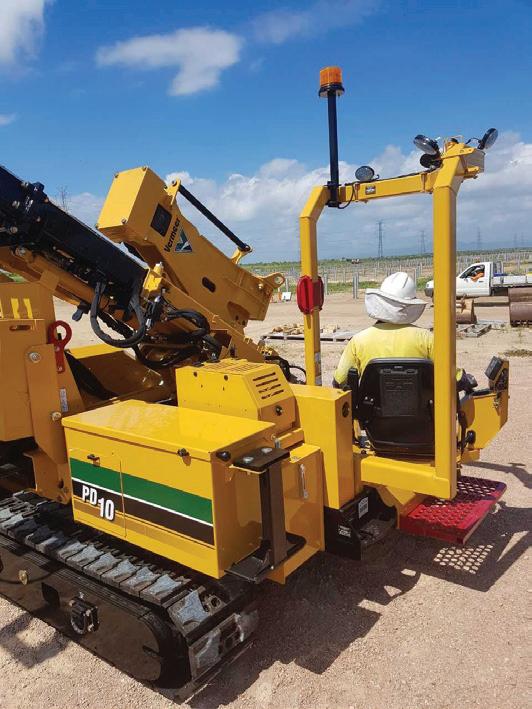
High-quality pile driving equipment will not only install piles quickly and accurately, but will also reduce damage to the top of the pile, reducing the need for rework and ensuring quick project turnaround.
Equipment considerations
According to General Manager of Sales at Vermeer, Jeff Lawson, solar sites require high levels of accuracy to enable panel motors to be mounted correctly, making precise equipment a nonnegotiable on site.
32
SOLAR AND STORAGE ENERGY PARTNER CONTENT
Vermeer’s PD10 in action.

Another problem faced by solar installers is that pile driving machines are notorious for damaging the top of the pile.
Common types of damage caused by these machines include mushrooming the top of the pile and stripping it of its coating, which can lead to corrosion issues down the track.
“Every small mistake made by inferior equipment will lead to increased expenses and decreased efficiency. While organisations may save money in the short term, doing a job effectively once is more cost and time efficient than having to go back and re-work minor issues,” Mr Lawson said.
Proven success and support
Mr Lawson said that one of the sector’s most well-proven pieces of equipment is Vermeer’s PD10 Solar Pile Driver.
“Vermeer's PD10 Solar Pile Driver has the ability to reliably perform with speed and precision. It has exceptional accuracy with an optional laser receiver integrated into the control system and a GPS-enabled design to improve productivity,” Mr Lawson said.
“The PD10 has been designed specifically to meet the unique needs of large-scale solar installation, offering significantly longer service intervals than those of competing brands — meaning less downtime and reduced maintenance costs.”
With contractors facing a solar boom, completing projects on time is crucial.
“The PD10 features a hammer that has 80 per cent more impact energy than our original pile driver, which is important to reducing cycle times and getting the job done,” Mr Lawson said.

According to Mr Lawson, the PD10 also offers productivityenhancing features such as efficient ground drive, a conveniently placed dual joystick, a wide trackpad to minimise jobsite disturbances, a bash plate designed to reduce damage to piles and an integrated control system, offering the operator critical information on pile angle and height accuracy.
The PD10 has already been used successfully on projects throughout phase 1 and 2 of the renewable energy zone development as per the ISP, including at the Darling Downs Solar Farm in QLD.
More than just a machine
While the features and benefits of any piece of equipment are important, Mr Lawson also said that the value of quality equipment is significantly increased when great sales and after-sales support is offered.
“Vermeer equipment is backed by the support network of an unmatched dealer network. Being part of the RDO Australia Group, with over 500 employees and 18 dealership locations, means that we can offer Australia wide servicing and parts are available across the country as well,” Mr Lawson said.
“Choosing the right piece of equipment with the right support will not only make organisations more efficient, but also more productive and more profitable.”
33 ENERGY PARTNER CONTENT SOLAR AND STORAGE
ACCELERATE THE TRANSITION TO CLEAN ENERGY WITH SMART TOOLS

What could compelling, beautifully designed proposals do to help boost your solar sales? If you’re looking for the one-stop shop to increase your solar business productivity, look no further than Nearmap on OpenSolar.
The partnership of Nearmap and OpenSolar has resulted in a powerful insights-based tool for solar companies across Australia and New Zealand.
According to Global Market Insights, Australia’s solar installation for residential and commercial sectors could exceed five million units by 2030. The demand for more clean energy continues to grow and with that demand comes the need to design and implement solar systems more efficiently and effectively.
Nearmap on OpenSolar is an end-to-end sales toolkit that takes the pain out of the solar sales cycle. Need to see the current condition of a roof before setting foot on site? Nearmap on OpenSolar can help with that. Want to design a complete solar system with energy calculations in a beautifully designed proposal?
Nearmap on OpenSolar is your answer. Andrew Birch, co-founder of OpenSolar, said the partnership with Nearmap was an easy decision to make.
“We knew that designing systems with really beautiful highresolution aerial images, where you can look around properly from all angles – north, south, east, west – could really help sell a customer a total system. It’s another way for customers to more readily buy into clean energy solutions,” Mr Birch said.
The mission of OpenSolar to grow clean energy was a natural fit for Nearmap, whose mission is to change the way people see the world to transform how they work. Nearmap on OpenSolar was a perfect solution to both.
Prospecting and closing the sale – a large part of the solar industry – becomes easier since this new tool showcases how a solar installation will look on a customer’s home. With a completely mobile and interactive design platform, a sales rep can customise a system on the spot while presenting to a customer. This provides the ability for a customer and sales rep to find the best solution for their home and energy needs.

An additional feature included with Nearmap on OpenSolar is the built-in CRM; it can track the customer touchpoints from beginning to end and all in between. Design multiple systems with ease with access to imagery across seasons and a comprehensive hardware catalogue. Once a system is designed, a sales rep can quickly showcase the benefits and environmental impact of choosing solar to power their home.
“Customers are busy and solar isn’t something they typically wake up and demand that they need,” Mr Birch said.
“The imagery really helps pull in the emotional piece, draws them in so they understand what the end result will look like. Higher quality presentations equals more conversions.”
With roughly 20 per cent market penetration for solar in Australia, it’s clear that the future is bright to increase the opportunity for more clean energy. Nearmap on OpenSolar is the right tool at the right time to continue to drive this effort forward. Access to historical imagery provides truth on the ground to help solar companies design stunning proposals and then track their customer experience, all in one single spot.
“It’s the best place to start for a compelling conversation,” Mr Birch said.
“Great software and beautiful imagery – all to help sell lower cost energy to consumers and help save the planet.”
March 2020 ISSUE 9 www.energymagazine.com.au
34 SOLAR AND STORAGE ENERGY PARTNER CONTENT
The OpenSolar platform.
SEE CLEARLY, SELL SIMPLY WITH NEARMAP ON OPENSOLAR
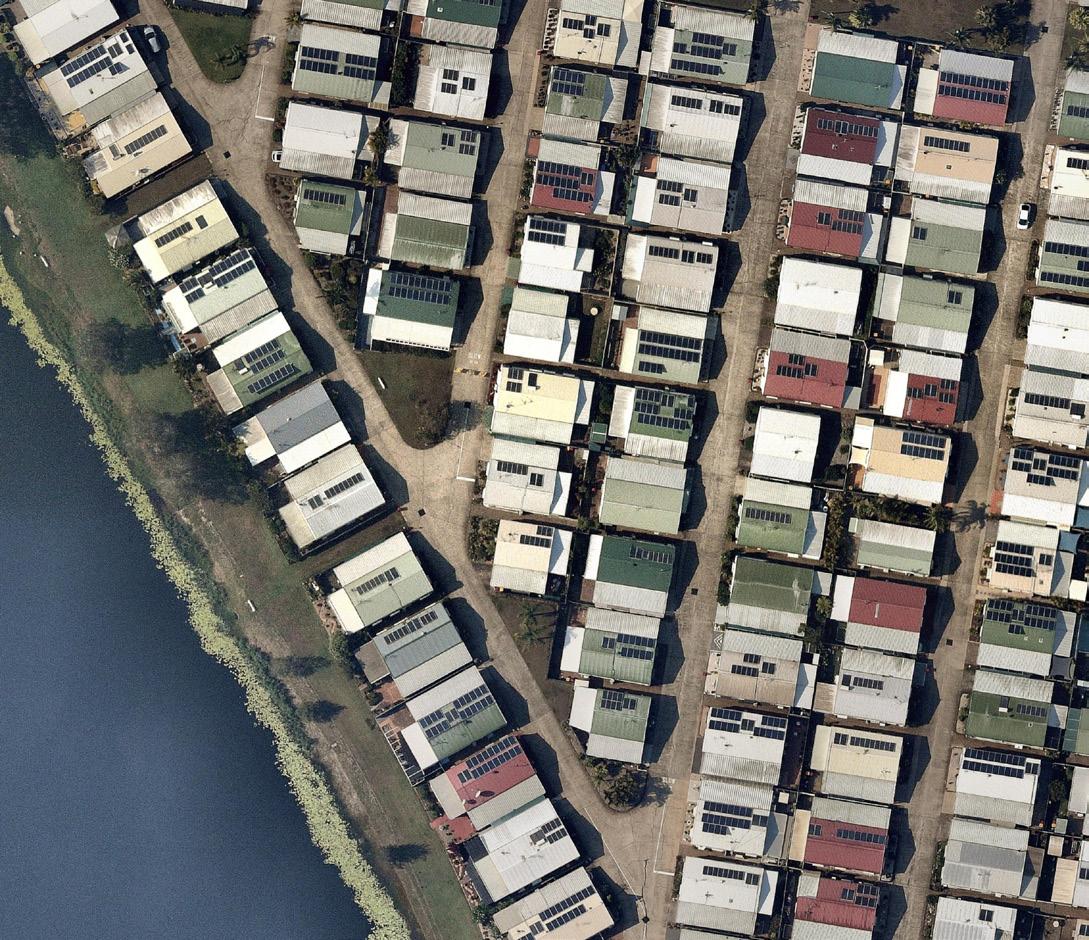
THE END-TO-END SOLAR SALES TOOLKIT WITH PREMIUM IMAGERY
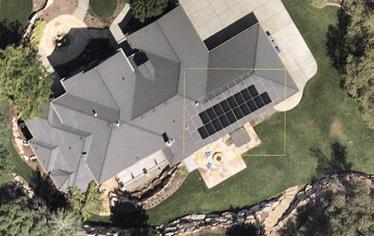
SEE CLEARLY
View incredible detail with access to vertical and oblique high resolution aerial imagery.


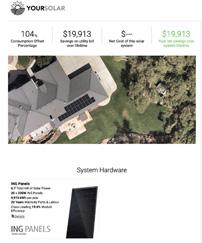
PLAN EASILY
With the interactive design features and premium imagery.

SELL SIMPLY
Personalise your proposals and pricing models so your brand shines.
nearmap.com/opensolar
Captured: 19/11/2019 Tweed Heads, NSW

AUSTRALIA’S HYDROGEN STRATEGY HAS OFFICIALLY LANDED
March 2020 ISSUE 9 www.energymagazine.com.au 36 HYDROGEN AND FUTURE FUELS

The document and its nine supporting papers outline an “adaptive” approach to supporting the development of the Australian hydrogen sector. That is, the strategy is designed to evolve as the sector matures and is intended to be responsive to dealing with the uncertain outlook for hydrogen ahead. It does this by focusing on removing market barriers in areas such as regulation, R&D, and skills and workforce to enable a quick scale-up once the sector is ready to take off.
The strategy will be jointly owned by all Australian governments – that is federal, state and territory – in the spirit of cooperative federalism. This means that all jurisdictions have a stake in ensuring its success, with the COAG Energy Council continuing to be the key decision-making body for the strategy’s implementation.
Backed by $370 million in project funds and $13.4 million for implementation activities, the strategy identifies four measures of success:
1. Australia is one of the top three exporters of hydrogen to Asian markets (at this stage given the efforts going into project development in Australia versus other countries, this seems likely to be achieved)
2. Australia has an excellent hydrogen-related safety track record (this will be critically important – fortunately we have very good credentials in similar sectors such as LNG to leverage upon)
3. Hydrogen is providing economic benefits and jobs to Australians (this isn’t quantified, but from the number of Australian energy companies already setting up dedicated hydrogen teams, this is already starting to be seen)
4. Australia has a robust, internationally accepted, provenance certification scheme in place (more on this below)
While strongly requested by industry, not surprisingly, the strategy does not include specific sector targets. Figures around hydrogen production levels, numbers of refuelling stations and the like were deemed to be too difficult to secure agreement on by all states and territories as well as being challenging to set given the early stage of the sector. Given the adaptive nature of the strategy however, this is subject to change.
So, what happens next? The national taskforce established in late 2018 to lead the drafting of the strategy will now shift its focus to implementation. All of the strategy’s 157 joint actions will be reviewed with next steps against each item to be shared shortly.
 by Claire Johnson, Co-Founder & CEO, Hydrolytics
by Claire Johnson, Co-Founder & CEO, Hydrolytics
To much fanfare and a little bit of controversy, Australia’s national hydrogen strategy was released to an eagerly awaiting Australian industry in late 2019. Receiving highly unusual unanimous support from Australian energy ministers sitting around the COAG table, the strategy was the culmination of 12 months of work spearheaded by head hydrogen advocate (otherwise known as Australia’s Chief Scientist) Dr Alan Finkel.
The taskforce, which sat in the Department of Industry, Innovation and Science, will likely sit in the new Department of Industry, Science, Energy and Resources. While Federal Energy Minister Angus Taylor held portfolio responsibility for hydrogen, it’s unclear if this will continue with the resources portfolio taking a more active role of late, including signing a joint statement with Japan on hydrogen export collaboration in January this year.
ARENA will continue to play a lead role with $70 million earmarked for hydrogen electrolyser deployments, particularly over 10MW. It will be interesting to see how many proposals they receive at that scale this year, given ARENA has indicated they will not be able to accept applications beyond this date due to their 2022 legislated cessation. Let’s hope that’s overturned. The hydrogen fund is expected to open for proposals in March 2020.
The CEFC is also gearing up to play a bigger role in hydrogen projects with a $300 million “Advancing Hydrogen” concessional finance fund. Few details have been released at this stage, but no doubt these will follow soon.
Pleasingly, my former organisation, the Australian Hydrogen Council, will be an important player in the strategy’s implementation, and will be looking at a guarantee of origin program providing hydrogen certification as well as developing an industry code. This is a great endorsement for the work of the association and its members.
Obviously, a lot of the activity connected to the national strategy will be driven on the ground by Australian states and territories with many already being on the hydrogen journey for some time. While those who are looking to develop projects should be talking to ARENA and CEFC, the states and territories will of course be essential project partners. The current status of each is presented below.
Australian Capital Territory
By mid-2020 we can expect to see ACT Government public servants driving around in Hyundai NEXO’s and filling up at the Fyshwick refuelling station currently under construction. We may well see our Chief Scientist following suit at some point.
With the Fyshwick station’s proximity to federal parliament, there’s an opportunity for politicians to follow the ACT’s lead. Ministers should consider swapping over their Comcars to a NEXO (or Toyota Mirai) to show their commitment to hydrogen and send a positive signal to the Japanese and Koreans – who of course we want to do big business with on the export front.
www.energymagazine.com.au March 2020 ISSUE 9
37 HYDROGEN AND FUTURE FUELS

While the ACT is also doing some research in the hydrogen injection space, it’s unclear if they’ll make a bigger move into blending with natural gas at this stage. Injecting hydrogen into ACT’s networks could make sense however rather than going down the full electrification route as has been flagged previously.
New South Wales
NSW had been relatively quiet on the hydrogen front until they recently announced their target of 10 per cent of the state’s gas to come from green hydrogen by 2030. This is a lot of hydrogen and how it will be achieved remains to be seen, but it certainly could mitigate some of the impacts of natural gas pricing on the East Coast.
Industry is stepping up to bring hydrogen to NSW however, with Jemena progressing their demonstration scale power-to-gas project set for launch in mid-2020. An option also exists for a co-located refuelling station, but a vehicle fleet user needs to be secured prior. This is where the NSW Government can play a role in kick starting hydrogen mobility in Sydney.
The NSW Transport Minister’s announcement in 2019 that they were looking to electrify their entire Sydney bus fleet (approximately 8000 buses) seems like an obvious place to start. They called for proposals in 2019 to make this happen so let’s see what this year brings. The potential Jemena station is really an ideal opportunity for the NSW government to start trialling hydrogen buses with the infrastructure piece already solved.
Northern Territory
With its abundance of high-quality solar resources, there’s a clear opportunity for the NT to step up and become a serious hydrogen player. Incorporating a hydrogen component into the Mike Cannon-Brookes and Andrew Forrest backed Sun Cable project à la the Asian Renewable Energy Hub in WA should be looked at, particularly if they start considering options for exporting energy beyond Singapore where HVDC cable doesn’t cut it.
Queensland
Queensland is busily implementing their renewable hydrogen strategy with a number of projects already announced, including BOC and ITM Power's electrolyser and refuelling station project expected to come online in 2020 with Queensland Government officials taking a fleet of five Hyundai NEXO.
Their $15 million fund closed for expressions of interest back in August last year, so it will be fascinating to see which projects progress and also if there’s any money remaining for a second round. Based on the level of interest in Queensland’s export potential it’s likely to be oversubscribed. The Queensland Premier has also taken a personal interest in hydrogen so expect to see plenty of activity in the state.
South Australia
Ahead of the pack, SA had the head start on other states, starting their hydrogen journey way back in 2017. It’s not particularly long ago, but the sector is moving relatively quickly. They recently followed up their roadmap with an action plan confirming the Liberal Government’s commitment to hydrogen.
SA will see some of the fruits of their labour this year, with AGIG’s power-to-gas project coming online in 2020. Let’s hope some of the national strategy funds can be directed towards getting Adelaide a refuelling station network to leverage that 1.25MW electrolyser. This makes a lot of sense and Adelaide could be the first Australian city with a cluster of hydrogen stations.
Tasmania
Tasmania has come from nowhere and is now the state to watch from both a hydrogen export and domestic use perspective. It has all the characteristics you need for cheap, clean hydrogen in volume – firm and low-cost hydro energy, closing in on 100 per cent renewable and lots of water.
Their draft action plan closed for public comment in January. It’s unclear at this stage if the government will allocate any funding for projects but given their desire for an export scale project in the future at industrial site, Bell Bay, and with all other states with hydrogen interests putting some dollars on the table, we can expect there may be something.
Victoria
Victoria is full steam ahead with their brown coal to liquid hydrogen project known as the Hydrogen Energy Supply Chain (HESC). The HESC consortium started construction of the Latrobe Valley facility in late 2019 with the first shipment of hydrogen to Japan expected this year. While the amount of hydrogen to be shipped is small (around three tonnes), it will validate whether the technology stands up and will inform their decision to go to commercial phase, expected in the mid-2020s.
On the green hydrogen side, after quite an extensive consultation period, it remains unclear what level of financial support will be allocated to green hydrogen projects in the state. The challenge for the Victorians will be managing expectations. Given their positioning of ‘green’ and ‘brown’ hydrogen as separate programs, a decision to not allocate funding to the green side when the other has received $50 million may not go down so well with industry.
Western Australia
WA is already on the path to becoming a major renewable hydrogen exporter. Several projects have already been announced aimed at the export opportunity, including the massive 15GW Asian Renewable Energy Hub. WA has also announced support for feasibility studies across a range of hydrogen applications and have $9 million funding up their sleeve for infrastructure projects. Announcements are expected on this soon.
All in all, it's a very exciting time for hydrogen in Australia with a lot of activity taking place at all levels of government and across multiple industry sectors. Obviously however, the demand for hydrogen on a mass scale will need to materialise for Australia’s investments to bear fruit. Australian governments and industry will be vigilantly pursuing these supply opportunities over the next decade.
ABOUT HYDROLYTICS
Hydrolytics is a hydrogen focused consultancy supporting organisations to navigate the Australian hydrogen sector. Hydrolytics is headed by Claire Johnson, the former CEO of the Australian Hydrogen Council.
March 2020 ISSUE 9 www.energymagazine.com.au
38 HYDROGEN AND FUTURE FUELS



TITANIUM PARTNERS PLATINUM PARTNERS GOLD PARTNERS REGISTER FREE ATTEND AUSTRALIA’S PREMIER EVENT FOR SOLAR, STORAGE, ENERGY MANAGEMENT, WIND, HYDROGEN & ZERO CARBON VEHICLES 7 - 8 APRIL 2020 INTERNATIONAL CONVENTION CENTRE | SYDNEY AUSTRALIA REGISTER NOW! smartenerg yexpo.org.au LATEST PRODUCT EXPERT SPEAKERS MARKET INTELLIGENCE FANTASTIC NETWORKING
CLEAN ENERGY’S POWER TO MAKE AN IMPACT
While the Australian energy industry and Australians’ efforts to generate and use clean energy is a huge step in the right direction, a holistic approach towards clean energy generation and use must be fostered to give clean energy the power to make an impact.
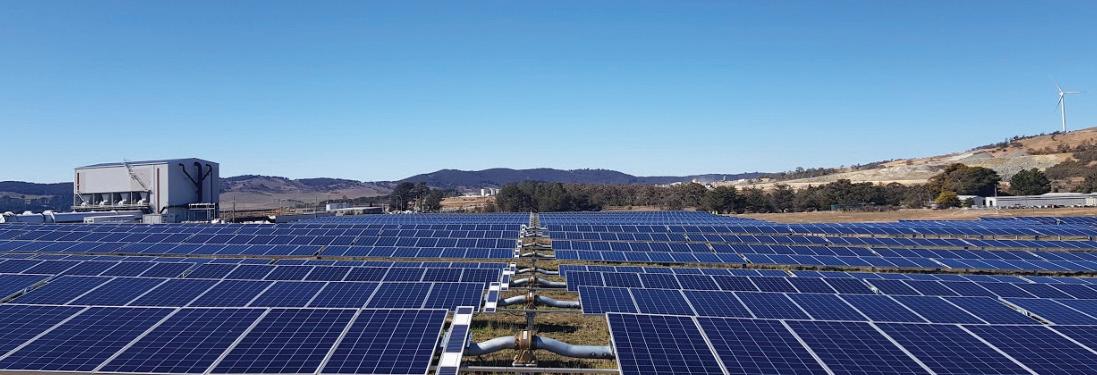
Australia’s energy industry is becoming increasingly clean, with at least 35 per cent of Australia’s energy needs expected to be met by renewable energy solutions by 2021. Furthermore, Australians are more eco-conscious than ever in terms of their energy, technology and transport choices.
With this mindset, paired with a growing network of reliable charging stations, it won’t be long before Australia sees a surge in the uptake of electric vehicles and other clean, battery powered technology. But how far can the benefits of these ecofriendly options go if they’re powered by energy generated from coal?
This is the type of question that Veolia continues to explore at the site of its Woodlawn Eco-Precinct. The Bioreactor on site maximises the recovery of energy by generating electricity from methane gas, created by decomposing waste. But while this process was an important way to create energy from waste gases, Veolia realised it could further maximise the amount of clean energy generated by further investing in other methods of renewable energy generation within the Eco-Precinct.
Wind and solar for Woodlawn
Considering all aspects of the production cycle has seen Veolia maximise Woodlawn’s potential with the installation of a 2.5MW solar farm. Veolia is no stranger
to the benefits of solar farms, having installed a number across the country for organisations including the award winning solar battery at University of Sunshine Coast, and Mid North Coast Local Health District, where an energy performance contract is set to achieve energy savings of over 4,070,106 kWh-e.
The solar farm at Woodlawn uses a NEXTracker single-axis tracking system for maximum solar generation, and includes 7200 solar PV modules which provide energy directly to the precinct. Since its installation in July 2019, the $5.5 million initiative has not only offset emissions, but also site costs, with the bulk of electricity used to power its waste processing activities being generated by the solar farm.
Further to the solar farm, Woodlawn is also home to a 23 turbine wind farm, owned and managed by Infigen Energy. This group of 2.1MW turbines, with an installed capacity of 48.3MW, produces enough energy to power approximately 32,000 average Australian households each year through the national energy grid. This represents a saving of about 138,000 tonnes of greenhouse gases per year.
When maximising clean energy production, it’s important to consider what options are viable for a specific site. The Woodlawn site is particularly suited to both solar and wind generation, with high levels of sun exposure and the perfect mix of wind, climate patterns and typography for wind power.
Going the extra mile
Veolia is continually exploring ways the facility can further contribute to the circular vision for waste management and energy production.
“We’re very keen to expand our resource recovery at the facility. Our next areas of focus are to harness waste heat and waste carbon dioxide that we’re generating, and we have some exciting plans in the works in this space, that would make the facility a contributor to the circular economy at every level,” says Henry Gundry, Manager of Woodlawn Eco-Precinct.
“We also have an on-site aquaculture farm which is gathering heat from our landfill biogas engine, and we see a real avenue to progress into food production, using waste heat from the engines, and potential CO2 recovery in large-scale greenhouses.
“This is our vision, and the next step will be about bringing these ideas into fruition.”
An example to industry
By maximising clean energy production on the Woodlawn Eco-Precinct, and capturing emissions and other waste products, the Woodlawn Eco-Precinct is taking a holistic approach to waste and clean energy production.
With time, this is an approach that must be adopted by the energy industry as a whole in order for it to reap the full benefits that renewables have to offer, and critically, to minimise the impact of traditional energy generation on the environment.
March 2020 ISSUE 9 www.energymagazine.com.au 40 HYDROGEN AND FUTURE FUELS ENERGY PARTNER CONTENT
The solar farm at Veolia’s Woodlawn facility.

Reth in k energy
With solutions designed for your operational priorities. Providing operations and maintenance services for critical energy infrastructure is Veolia’s core focus. In doing so, we contribute to long-term energy security and climate resilience within the communities we serve. Are you ready to Rethink Sustainability?
veolia.com/anz
HYDROGEN CENTRE LAUNCHED AUSTRALIAN
The Australian Hydrogen Centre has recently been launched at Adelaide’s Tonsley Innovation District to support the development of the resource. The Centre will be led by Australian Gas Networks in collaboration with founding members Neoen, AusNet Services and ENGIE, and has secured $1.28 million from ARENA, $120,000 from the South Australian Government and $500,000 from the Victorian Government.
The Australian Hydrogen Centre (AHC) will undertake feasibility studies into blending 10 per cent and 100 per cent hydrogen into city and regional gas networks in South Australia and Victoria as a key step towards the greater use of hydrogen in gas distribution networks.
In addition, the AHC will publish knowledge sharing reports to externalise key insights and data from the operations of Australian Gas Networks (AGN’s) flagship project, Hydrogen Park South Australia (HyP SA).
South Australian Minister for Energy and Mining, Dan van Holst Pellekaan, said the coinvestment from the Federal and Victorian Governments, as well as AGN and its partners, showed commendable leadership.
“The Australian Hydrogen Centre’s ambitious research will explore the pathways required to decarbonise the South Australian and Victorian gas distribution networks by identifying methods to scale up renewable hydrogen production and consumption,” Mr van Holst Pellekaan said.
“Considering South Australia’s enormous wind and solar resources, we have significant natural advantages that can be leveraged to produce, consume and export 100 per cent green hydrogen.
“This project builds on the South Australian Government’s $4.9 million investment in Hydrogen Park SA that will see hydrogen blended with natural gas and delivered to 710 homes in the local community.”
The hydrogen will be produced on-site, using renewable electricity to split water (H2O) into hydrogen and oxygen by electrolysis.
Mr van Holst Pellekaan said the hydrogen will be blended with natural gas and supplied to nearby homes and businesses via the existing gas network, with potential also to supply 100 per cent hydrogen to industrial users via tube trailers (long storage tubes on the back of semi-trailers).

March 2020 ISSUE 9 www.energymagazine.com.au
42 HYDROGEN AND FUTURE FUELS
“A five per cent hydrogen blend is the first important step to reducing gas related emissions, and will help accelerate renewable hydrogen into the South Australian economy,” said Mr van Holst Pellekaan.
“The aim of the funding is to support large scale deployments of renewable hydrogen projects and bring costs down to help to make the technology commercially viable.
“The development of new energy technologies is at a tipping point, and renewable hydrogen will soon provide a much needed carbon-free fuel for our domestic and export markets.
“Producing a clean burning gas like renewable hydrogen supports South Australia’s intention to be net-zero emissions from electricity generation by 2030s and net-zero emissions across the state by 2050.”
The South Australian Government’s support for the Centre forms part of South Australia’s Hydrogen Action Plan, released in September 2019.
ARENA CEO, Darren Miller, said the natural gas network could be a key piece of infrastructure to support decarbonisation of the national energy system.
“The network has the potential to be used for the long-term storage of renewably produced hydrogen and limit the need for electrification alternatives, which can be costly.
“The development of a local hydrogen sector will underpin the investment in technology and skills to support the long-term export opportunity. These studies will go a long way to identifying the possibility of using and storing hydrogen in local gas networks.
“AGN, as part of Australia’s broader energy industry, has commenced the new decade with a strategy that aims to deliver substantial, measurable and world-leading outcomes in minimising the current and future carbon footprint across the whole of our national gas distribution business.
“This public licence also requires total transparency so the studies will provide guidance as to both the best solution to deliver renewable gas into our networks while ensuring full engagement with all stakeholders and consumers about this step-change in Australian energy delivery.
“The 2020s will be an exciting time for the energy industry and consumers. ARENA’s foresight in backing the strategy for a roll-out of more renewably sourced gas in these two key major markets, is to be commended.”
Energy Networks Australia CEO, Andrew Dillon, said the broad support of the AHC reinforced the role of energy networks in enabling a sustainable energy future.
“Hydrogen will play an important role in the energy transition as we adopt new technologies such as renewable generation to reduce emissions from the energy sector,” Mr Dillon said.
“The AHC will deliver a practical pathway for blending hydrogen into networks and will directly contribute to the delivery of the National Hydrogen Strategy.
“Flexible hydrogen production creates additional value streams for excess renewable electricity and can also be used to manage peak demand.
“Establishing a strong, domestic hydrogen industry will drive the development of Australia’s hydrogen export industry.
“Hydrogen technology is already being embraced around the world for domestic and commercial use in gas networks and to fuel passenger and freight trains.”

www.energymagazine.com.au March 2020 ISSUE 9 43 HYDROGEN AND FUTURE FUELS
GREEN IS THE NEW VINTAGE
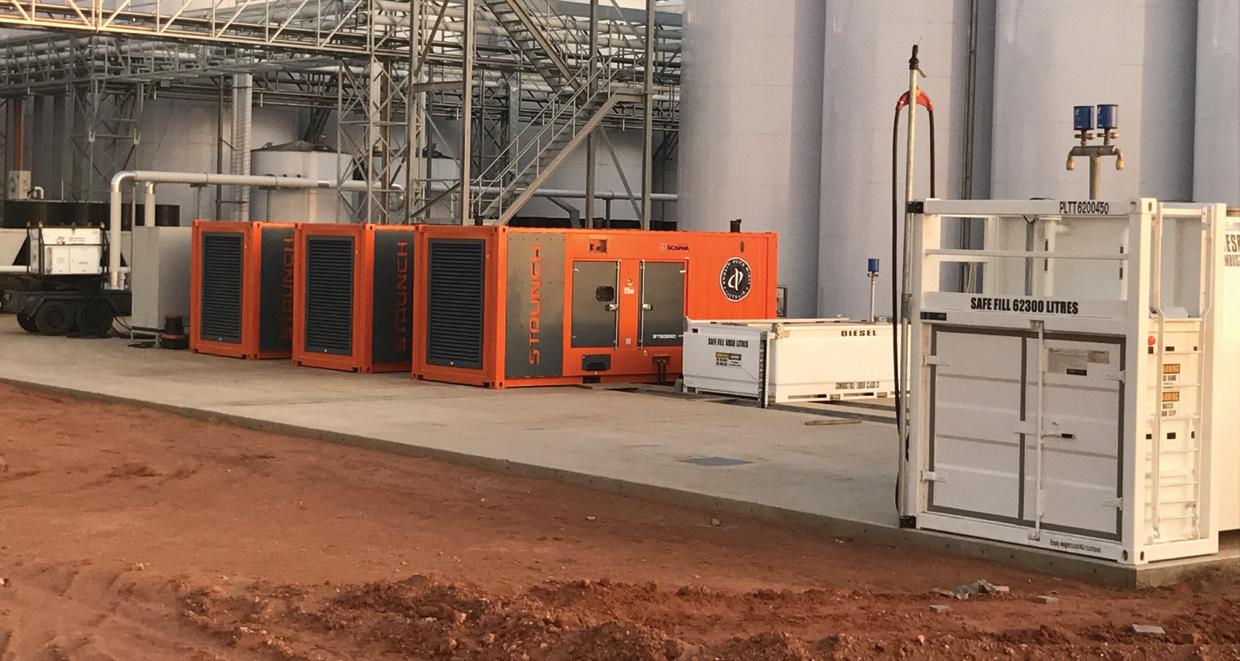
It’s not only the bottles that are green at Andrew Peace Wines; an innovative 21st century approach to power generation is delivering environmental and financial benefits too.
Family-owned Andrew Peace Wines is one of the top 20 wine exporters in Australia, sending four million cases overseas annually. The Swan Hill, Victoria, winery has taken extraordinary steps to reduce its carbon footprint, secure its power supply, and install the capacity to feed energy back into the grid.
Renewable Baseload Generators (RBG), having previously converted the winery’s original backup generator to run on straight biodiesel, has recently installed six new Staunch generators powered by Scania to run its water treatment facility and provide prime power to the winery.
Combining 1.6MW of solar with the biodiesel-powered Staunch/ Scania generators, Andrew Peace Wines is moving away from fossil fuelled power and its grid-supplied electricity, and aims to use waste streams as well as harvesting its own energy crops as feed stocks for on-site biodiesel production, thus closing the loop and further reducing its environmental impact.
The distributed energy resources not only provide long-term energy reliability for the AP Wines operations, they will also play a key role in providing support to the network in times of extreme stress.
Delivering the green solutions to AP Wines is a coalition of suppliers, comprising Danny Williams from RBG, Wally Younan from Staunch Machinery, Richard Martin from AEES Group, Les Cutajar from ComAp, and Kedem Levy from Enel X.
RBG has teamed up with Scania Australia to supply fueloptimised biodiesel-compatible engines, and with Staunch Machinery, builders of quality generator enclosures designed in the Middle East, to produce generators perfect for the Australian climate and operating environment.

Danny Williams said the RBG biodiesel generators reduce emissions, smooth out fluctuation in solar power generation, provide security of energy supply as well as providing capacity to feed back into the grid.
All RBG generators are super silent and feature ComAp control systems, making them flexible and suited to a number of on-and off-grid functions, including grid export. They also integrate with the site’s ComAp Hybrid Management control system.
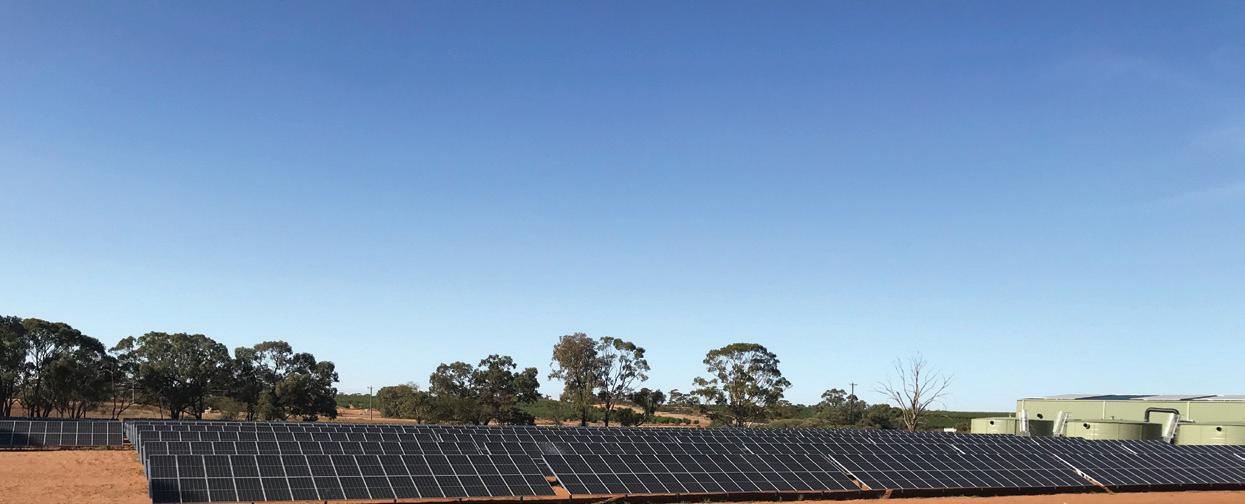
Enel X is a global market leader in demand response and power flexibility. With Enel X’s help, AP Wines is turning its backup generators into a flexibility asset that will support the grid, earn new revenue and put downward pressure on wholesale electricity pricing.
Richard Martin, Managing Director of AEES Group, energy supply management experts, said that AP Wines’ move towards innovative energy sources helps deliver better management of the seasonal impost of the network poles and wires demand costs. Combining these initiatives can save the business up to 50 per cent of its grid-derived energy costs.
44 HYDROGEN AND FUTURE FUELS ENERGY PARTNER CONTENT
CLOSE COMFORT IS THE FUTURE OF AIR CONDITIONING
With a mission to provide affordable and efficient cooling to everyone who needs it, without compromising sustainability, Close Comfort technology has revolutionised portable air conditioners.

Say goodbye to those large, noisy portable air conditioners with thick exhaust hoses that need a technician for installation – costing you time, money and, usually, a window.
Since Close Comfort needs no water or exhaust hoses, there’s no installation or mess. This means you can be cool and comfortable wherever you are, even outside in sheltered places.
Close Comfort’s Australian-invented technology provides you with affordable refrigerated air conditioning, wherever you are and wherever you go.
Portable and convenient
Close Comfort units need no water, exhaust hoses or window kits to operate. So, with no installation required and weighing just 17kg, you can be cool and comfortable wherever you are.
Sustainable and eco-friendly
Close Comfort uses just 300W of electricity – costing less than $1 a night to run, which is up to 75 per cent lower than
traditional portable air conditioners. Save money and decrease your carbon footprint for a sustainable lifestyle.
Some of the additional benefits of Close Comfort air conditioners include:
» Can be used with affordable solar plus battery and inverter power supplies
» Hermetically sealed refrigeration circuit with safe greenhouse and ozone friendly refrigerants eliminates leakage and recharging
» Also provides optional micro-particle filtration and dehumidification
» Eliminates ducting, drain, pipes, leaks and condensation
» Designed for recycling and material re-use
Close Comfort is the future of air conditioning in a carbon constrained world, with rising expectations for personal comfort and the need for sustainability.
For more information about Close Comfort air conditioners, head to www.closecomfort.com or call
(08) 9386 3257.

www.energymagazine.com.au March 2020 ISSUE 9 45 ENERGY PARTNER CONTENT HYDROGEN AND FUTURE FUELS
The Close Comfort air conditioning units.
WASTE: A WIN-WIN BILL-BUSTER FOR HIGH ENERGY USERS
As rising gas and electricity prices continue to bear down on manufacturers and other high energy users, the Australian market is increasingly looking to alternative fuels as a viable option to rein in costs and deliver positive environmental outcomes.
ResourceCo Energy is among those at the leading edge of the work being done in Australia to progress the use of alternative fuels. ResourceCo has over 25 years’ experience in extracting maximum value from materials otherwise destined for landfill, having produced over one million tonnes of waste-derived fuel, working alongside companies like Adelaide Brighton Ltd and Boral.
CEO of ResourceCo Energy, Henry Anning, says alternative, behind the meter options are as available for many Australian manufacturers who have seen gas and electricity prices skyrocket, with as much as a 400 per cent rise in five years – a trend he says is showing no signs of abating.
“Long-term, low-cost, renewable energy solutions are the obvious choice for energy hungry manufacturers seeking to regain control of burgeoning energy bills,” Mr Anning said.
Two large projects are progressing in Australia, with Australian Paper seeking to reduce the cost, risk and emissions of its heat use through an energy-from-waste solution, and Orora looking to establish a waste cogeneration plant at Botany.
“There is a massive opportunity for Australian manufacturers to embrace energy-from-waste solutions – the technology exists now and it’s a win-win in terms of generating heat and feeding electricity into the grid, while being environmentally responsible.
“ResourceCo Energy has spent the last 12 months honing an energy-from-waste solution that helps provide those benefits to mid-scale gas and coal users, enabling them to reduce reliance on expensive, emissions-generating fossil fuels and instead utilise heat and electricity from recovered fuel from waste,” Mr Anning said.
“Our behind the meter solutions focus on establishing infrastructure that meets customers' long-term heat and energy production requirements and provides a fixed cost solution through a renewable heat source.
“As an example, we can deliver a real solution for businesses with existing boilers using between 100 thousand gigajoules and a petajoule of natural gas – by installing between a five and 40MW recovered fuel boiler.
“The boilers use recovered fuel – a remanufactured wasteto-fuel source comprised of commercial and industrial (C&I) and certain construction and demolition (C&D) materials such as residual timber, plastic, paper and cardboard.”
Transitioning from fossil fuels to using waste to generate energy requires infrastructure changes and the accompanying capital investment – a consideration ResourceCo’s Henry Anning says doesn’t need to preclude businesses from making the change.
“ResourceCo will fund, build, own and operate the energy plant, taking the risk and capital cost away from the user while providing a lower cost, renewable heat or electricity source under a long-term agreement – providing a level of control and certainty unavailable in the traditional energy market,” Mr Anning said.
The success of the model is evident in the European market, which is about 20 years more advanced than Australia in the adoption of energy-from-waste solutions which limit the financial and environmental costs of energy production and achieve environmentally-sound waste management outcomes.
In the UK, Saxland International has established the country’s largest dedicated waste wood fired Combined Heat and Power (CHP) plant in Slough, providing the 400 companies on its site, including a Mars factory, with electricity, heat and water. The current station has more than 100 per cent redundancy, meaning that it can supply the estate more than twice over, with excess power sold to the grid.
Meanwhile Kiowatt, in Luxembourg, is providing electricity to the grid, heat to industrial users and cooling for a data centre through a cogeneration plant using recovered fuel. At full capacity the plant will make it possible to produce 22.4GW of electricity every year, which can be injected into the public grid to supply up to 6300 households.
“We are just scratching the surface in Australia in terms of what’s possible to reduce cost, risk and emissions, but it’s an approach that is starting to gain momentum,” Mr Anning said.
“If businesses, government and communities truly embrace the advantages of a circular economy, it will be a win for everyone.”
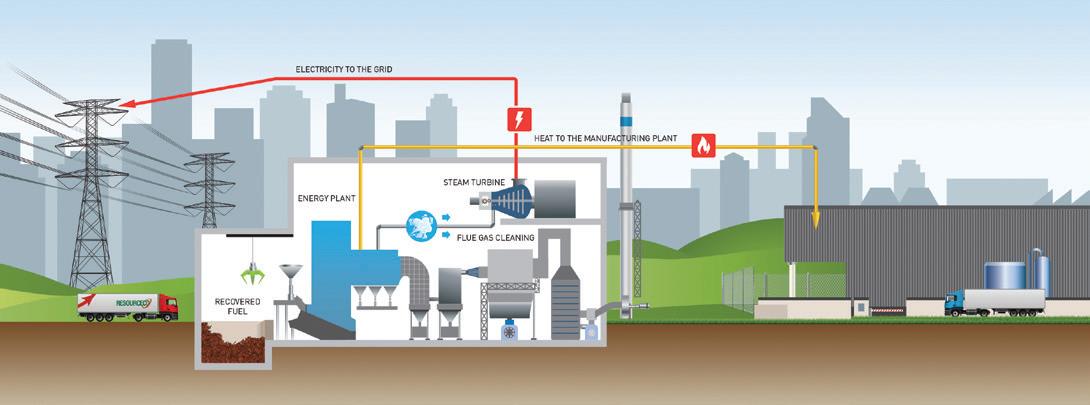
Recovered fuel to provide industrial heat.
March 2020 ISSUE 9 www.energymagazine.com.au
46
HYDROGEN AND FUTURE FUELS ENERGY PARTNER CONTENT

TOMORROW’S SOLUTIONS. TODAY

PREPARING FOR FIVE MINUTE SETTLEMENT:
THE FUTURE OF AUSTRALIA’S UTILITY MARKETS
by Kayne Coulter, Product Manager, Power, ION Commodities
When Australia first formed its national electricity market over 20 years ago, it adopted a five-minute dispatch period. Due to technological limitations at the time, it also adopted a 30-minute settlement period. Over the years, this discord between supply and demand resulted in inherent market inefficiencies. However, with the advancement of new technologies and ongoing efforts to modernise electricity markets in preparation for the explosion of renewable energy, Australia has mandated a move to a five-minute settlement (5MS) period by 2021.
March 2020 ISSUE 9 www.energymagazine.com.au
48 SMART NETWORKS
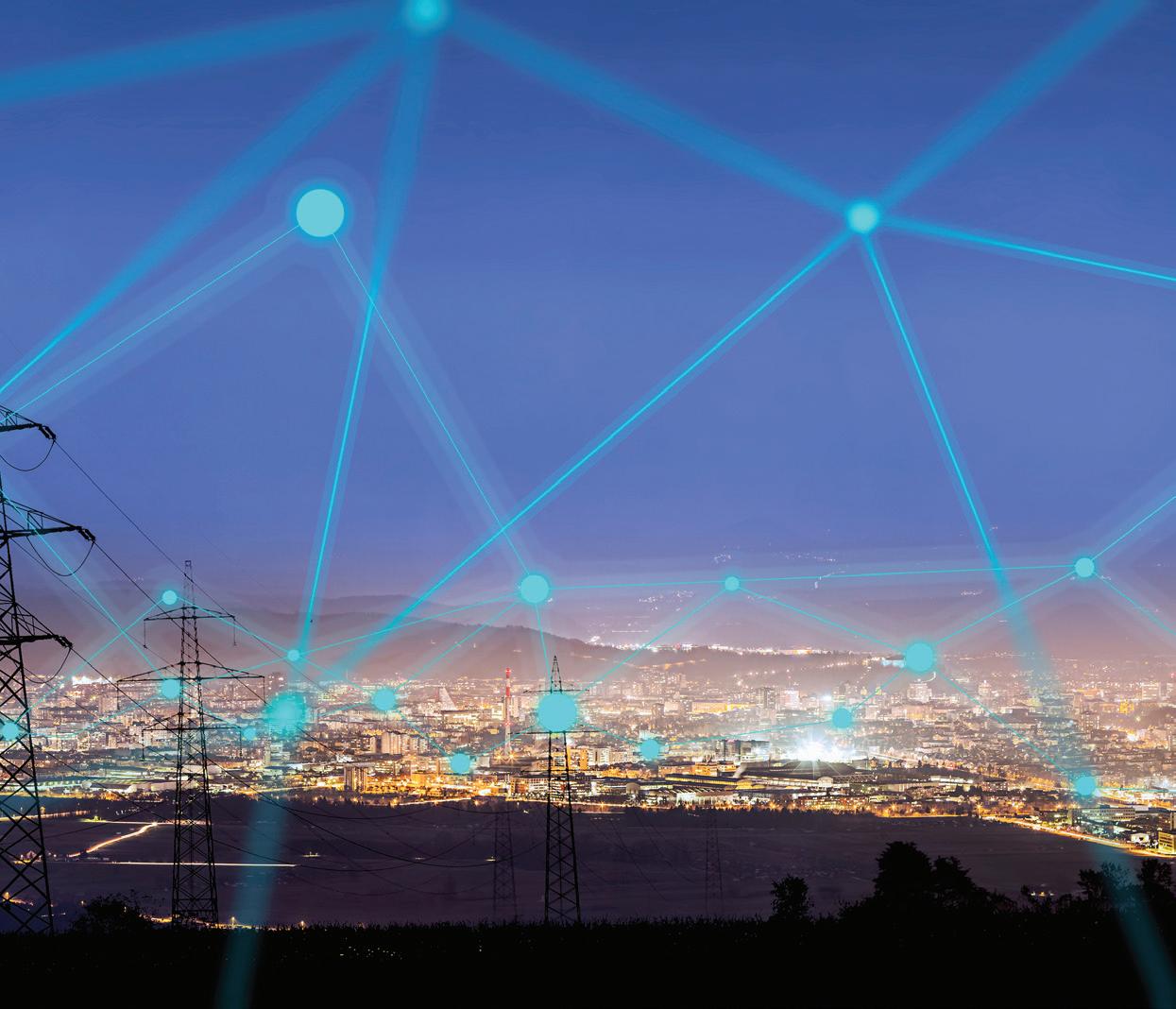
For many organisations, staying ahead of the existing half-hour settlements is already a priority. However, five-minute settlements (5MS) will fundamentally change business operations. Because of this, Australian utilities traders must be strategic about how they manage the new 5MS process – six times the settlements, six times the workload, and six times the data they are accustomed to processing
The advantages of 5MS
The benefits of adopting 5MS are numerous. Utilities will be able to respond faster to changing consumer demand, consumers will see lower electricity costs as a result of a more reliable grid, and utilities will see greater profits as the cost of wholesale electricity declines.
Another perceived advantage of the shorter settlement period is the potential to trigger greater investments in renewables
and upgraded technology infrastructure.
Renewable energy is driving greater attention to 5MS in other countries as well.
The Australian Energy Market Commission purports that 5MS will encourage greater investment in rapidly advancing technologies like batteries that support the increased adoption of renewable energy – which inherently brings with it greater variability in supply.
Additionally, early adopters will find that the shorter settlement period provides better price signals for resources and greater clarity on market conditions and constraints – especially the unpredictability of wind energy.
Is Australia a bellwether?
By 2021, utilities traders in Australia will no longer receive 48 settlements in one day – they will receive 288 settlements. The rest of the world may not be far behind.
European countries in particular are all-in on investing in renewable energy. Denmark recently reported that almost half of its energy came from wind power in 2019. With this rapid transition, global energy markets are opening themselves up to greater variability and will need a solution like 5MS to address these changes.
One example, Ireland, which also relies heavily on wind energy, moved toward 5MS following an EU directive pushing the island from multiple markets to a single market interconnected with the rest of the EU.
As a result, both Northern Ireland and the Republic of Ireland benefit from a seamless, cross-border exchange of electricity, which has reduced spot prices and increased efficiencies. The interconnections linking the grids between the two countries and EU countries on the continent as well as the growing reliance on renewable energy all add up to the makings of an ideal scenario for swift reconciliation periods.
www.energymagazine.com.au March 2020 ISSUE 9 49 SMART NETWORKS
Notably, the single electricity market on the island of Ireland has been a point of contention during Brexit negotiations.
The Philippines has also moved toward a 5MS scenario – although for different reasons. Following decades of persistent electricity shortages, the Philippine Government introduced reforms designed to drive greater investment in the national electricity grid’s infrastructure, including additional investment in renewable energy. These investments increased the interconnectivity of the country’s three main energy grids, necessitating faster response times to address supply and demand throughout the country.
Mitigating the five challenges of adopting 5MS
Even with perceived advantages, moving the market to 5MS will not be without operational obstacles. Here are five challenges utilities might face when moving to 5MS and how to address them:
Challenge 1: the explosion of data
The first challenge will be an explosion of data flowing through front-to-back office operations with the increased settlement periods. Schedulers, traders, and risk managers will have to make decisions based on more and more data at shorter intervals. And back-office accounting will have to manage the increased number of settlements in their workflow as well. For many commodity organisations, this new influx of data is simply too much for spreadsheets to handle. To remain competitive in the 5MS market, many organisations will need to look to commodity trading and risk management software to help make decisions and report information seamlessly across the business enterprise.
Commodity management software
paired with advanced analytics can help commodity organisations harness the changing volume, velocity, veracity, and variability of data sources in a market where there is more data generated than ever before. As this industry shift takes place, organisations that take advantage of advanced commodity analytics to harness the barrage of data will not only capitalise on their own settlements, but also maintain an edge over their competitors.
Challenge 2: an increase in decision points
Along with the rise in data points, another challenge that will need to be addressed is the increased number of decisions resulting from increased settlement periods. Machine learning (ML) can help address this challenge by automating previously manual processes and significantly improving energy supply and demand forecasting.
Technology like machine learning can help traders better predict instances like changing wind production or when energy demand may peak. By narrowing the margin of uncertainty, utilities will see increased profitability. Additionally, machine learning reduces previously manual operations and allows traders to spend time on higher value activities.
Challenge 3: transition to new technology
With the rapid transformation of Australia’s electricity sector, utility traders need nimble processes designed for a market that is vastly different from 50 years ago. Outdated processes will no longer sufficiently manage the increased speed of workflow impacting entire organisations from the front-to-back office.
Investing in digitalising processes with a commodity trading and risk management solution and evolving technologies like machine learning and artificial intelligence (AI) can address these challenges. A CTRM solution paired with machine learning and AI will be critical to driving information across interconnected systems to automate the value chain and help utility traders make decisions.
With 5MS, schedulers, traders, and risk managers will need to quickly embrace and strategically adopt new technologies like advanced analytics, artificial intelligence, and machine learning to manage the influx of data and decision points.
Challenge 4: quicker responses to changing regulatory environments
Another challenge this new era will bring about is the fact that regulatory regimes are now requiring faster responses from energy companies, which must be nimble in adhering to new regulations.
Again, this challenge can be addressed by investing in commodity trading and risk management solutions and pairing them with machine learning algorithms that
can set limits and automate alerts when systems near certain parameters. Similarly, advanced analytics can help analysts across the value chain gather and draw insights from data to ensure compliance.
Challenge 5: changing energy mix and the rise of prosumers
As 5MS drives greater investment in renewable energy, traders will also have to prepare for the rise of “prosumers” resulting from the linked rise of distributed generation. Prosumers are consumers that have become power producers. Their impact ranges from solar grids to commercial-scale solar projects that can at times create excess power. This excess power is sent to the grid via net metering – a process that will have to be accounted for and reconciled much faster with 5MS.
Here, innovation is also key. Commodity trading and risk management software can provide insights, controls, and tools to manage the increased volatility, uncertainty, and risk that comes from managing new and unpredictable sources of electricity derived from distributed generation.

Preparing for tomorrow
Utilities in Australia and around the world need to prepare for the challenges and opportunities new technologies offer. Done right, 5MS could ultimately help utilities increase their profitability.
With 5MS, schedulers will have to make decisions based on more and more data and will need tools to help them execute at a competitive level. With the right analytics and trading and risk systems in places, schedulers, traders, and risk managers will be able to make decisions and report that information across the entire enterprise.
With the speed of regulatory change and the explosion of data, utilities should integrate advanced analytics into processes today to ensure front-to-back office operations are prepared for tomorrow.
March 2020 ISSUE 9 www.energymagazine.com.au 50 SMART NETWORKS
PROMOTING RENEWABLES TO BENEFIT THE CUSTOMER – AND THE GRID
by Siobhan Day, Contributing Editor, Energy
Sitting on a beach in Ecuador, two friends came up with an idea that they believed would solve the energy trilemma. The concept was quite simple: offer consumers real-time, wholesale energy prices, and promote the use of renewables and off-peak energy use to improve grid reliability. Energy Contributing Editor, Siobhan Day, spoke with Amber Electric Co-Founder, Dan Adams, to discuss his brainchild – an energy company that is set to disrupt the industry by offering consumers more autonomy in when and how they use energy.
Co-Founders of Amber Electric, Dan Adams and Chris Thompson, met while working at Boston Consulting Group. With a shared passion for renewable energy and customer-centric digital technologies, they founded the ‘new-age’ energy company back in December 2017.
Less than 12 months later, Amber Electric was launched to customers in Sydney in August 2018. In October 2018, Chris finished a 12-week accelerator program at Startmate and won Startup Vic’s Impact Pitch Night.
Now servicing South Australia and Sydney, Amber Electric has seen tremendous investment in recent months, making it well positioned to scale its product and service offerings right up the east coast of Australia.
Moving to a two-way market
“In every other market you think about, it is a two-sided market where both buyers and sellers are responding to a price,” Mr Adams said.
“But the traditional energy market is one-sided, where suppliers see the wholesale price, but customers don’t, so they have no opportunity to respond to it.”
Amber Electric is able to bypass this traditional model and offer customers direct access to real-time wholesale energy prices at a monthly subscription fee of $10.
Through a simple online application, customers are able to see what the wholesale electricity price is at that moment in time, as well as a forecast for the next 12 hours.
The app also offers customers information on their daily, weekly and monthly energy consumption, as well as warnings for when wholesale prices are likely to spike.
“There are times when energy prices are more expensive, and we see those as an opportunity. Because they often happen in January, particularly on those hot days, we send notifications to customers recommending they go to the movies that afternoon,” Mr Adams said.

“Those high-price events really are an opportunity to dramatically increase savings. If they can engage with those and reduce their consumption for a few hours a year, they can save significantly more.
“The other side of that is wholesale prices are actually negative sometimes. Sometimes there’s surplus renewables in the grid, and we’ll actually pay people to use electricity – which people find pretty hard to believe.”
Environmental sustainability
Not only does Amber Electric offer customers the chance to be paid to use energy, but the company also provides information on the percentage of renewables in the grid so customers can shift some of their usage to the times when there are lots of renewables available.
“Because renewables are now the cheapest form of power, there’s this sort of beautiful win-win where customers are saving money and supporting the transition to more renewable energy at the same time,” Mr Adams said.
“Customers can look at the app and say, ‘I’m going to do my washing and drying at 3pm because I know there’s going to be a lot of solar in the grid and the wholesale prices are going to be cheap, so I can save money and support renewables’.
“It gives customers that bit of insight into how they can manage their energy use in a way that is going to help them the most, while benefitting the planet.”
Benefitting the grid
The ability to shift energy consumption away from peak periods is not just reducing costs for the consumer and creating more demand for renewables – it is also increasing the reliability of the grid.
“I think in consumers’ minds there’s this idea that they can save money and help the environment by using less power, but it’s quite a new concept that when you use power matters even more,” Mr Adams said.
www.energymagazine.com.au March 2020 ISSUE 9 51 CONSUMER AND INDUSTRIAL RETAIL

“Sometimes it makes sense to use more power because there is a lot of renewables in the grid. Sometimes it’s expensive and it makes sense to use less when it’s coming from coal, and you can increase your environmental impact by using less at those times.
“While all consumers are interested in reducing energy costs, there are a lot of customers that are very engaged and plan their life around using power when it’s cheap and renewable.”
Digitising energy
Dan and Chris aren’t really the type to stick to tradition, so it’s no surprise that their plans for Amber Electric are quite different from those of traditional companies.
“There’s two big trends happening in the energy market. One is the transition to renewables, and the other is a sort of digitisation of energy at the household level, with smart devices coming into people’s homes that can be optimised and controlled,” Mr Adams said.
“We think there’s a big opportunity to merge these two trends and start to use those devices in people’s homes to enable that transition to renewable energy.”
They will offer additional services, like optimising household batteries, electric vehicle chargers and other smart devices to run when wholesale prices are at their lowest levels, helping customers change their behaviour without much effort involved.
March 2020 ISSUE 9 www.energymagazine.com.au
52 CONSUMER AND INDUSTRIAL RETAIL

“Devices in customers’ homes are really leveraged to enable the transition to renewables and reduce the cost to customers because they can reduce the overall cost of running the network by reducing demand at those peak times,” Mr Adams said.
“The Amber model is just giving customers access to the wholesale price and then helping them optimise as many devices as they want.
“This way customers aren’t restricted to one device, they can have as many devices as they want from as many different suppliers as they want, and we can optimise it for them, or they can have the device manufacturer optimise it.
“The digitisation of energy is also the decentralisation of energy. Customers are taking more ownership with solar panels, batteries and EVs, and starting to be active participants in the energy market, rather than just inactive consumers of it.
“It is an exciting time when what is in the customers’ interest is also in the interest of the planet.”
www.energymagazine.com.au March 2020 ISSUE 9 53 CONSUMER AND INDUSTRIAL RETAIL
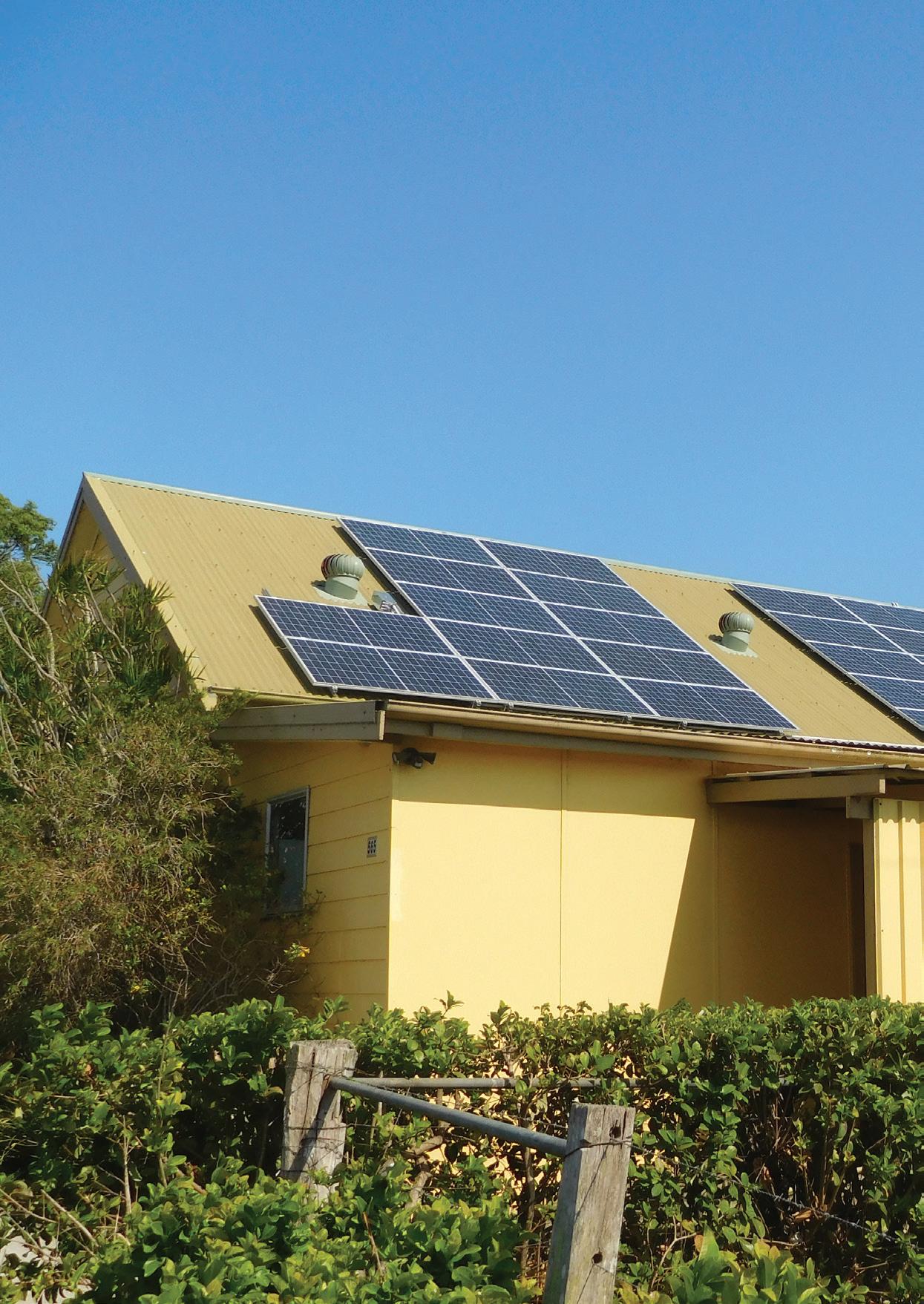
COMMUNITY-OWNED ENERGY RETAILER OUTLINES NEW VISION FOR INDUSTRY
54 CONSUMER AND INDUSTRIAL RETAIL
Enova helps put solar PV on community organisation roof tops with COREM (Community Owned Renewable Energy Mullumbimby). This is Coorabeell Hall’s new solar array in NSW.
Electricity retailer Enova Community Energy – created from grass-roots community action in the Northern Rivers of NSW and focused on leadership in local community self-sufficiency – last year expanded its availability throughout NSW, and is now on target to launch in South East Queensland in early 2020.
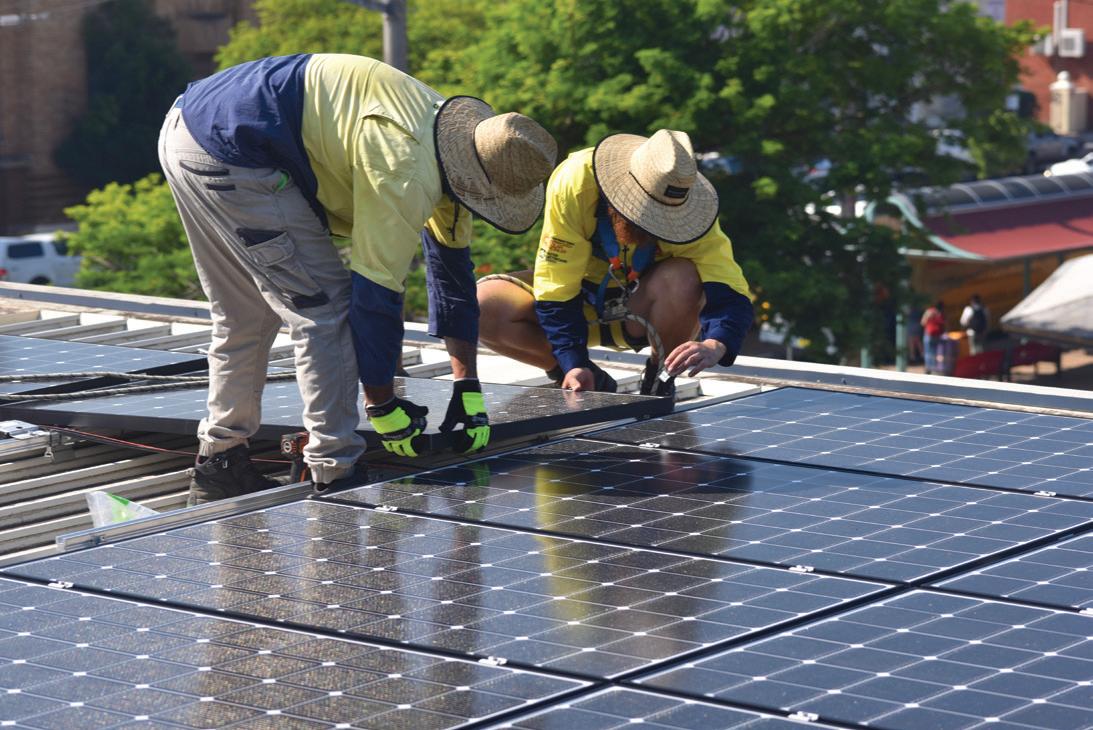
Enova Community Energy was founded in 2016 as a direct outcome of the community’s drive towards alternative energy models. Enova is truly community-owned, with more than 1600 individual Australian shareholders having invested to grow the organisation.
The company already has more than 7500 customers throughout NSW. As a social enterprise, 50 per cent of Enova’s profits are directed into initiatives to facilitate this vision through its registered not-for-profit charity arm.
Enova CEO Felicity Stening said, “Enova’s aim is to establish an energy supply model that can be recreated by communities across the country, and in the longer term, produce enough renewable energy locally to meet all its customers’ energy needs.
“Enova works in collaborative partnerships with organisations and communities to facilitate and implement
initiatives that create new energy models, where energy is locally generated, community-owned renewable energy. The aim is to pave the way for towns and suburbs to generate, store and share their own renewable energy, and move away from coal-fired power,” said Ms Stening.
“We are purposefully and actively disrupting the energy model. That model from the 20th Century is outdated and inefficient, as power is lost along the way.”
Already about 60 per cent of Enova’s customers have rooftop solar panels, which is three times the state and national average of solar take-up. Enova is harnessing this renewable resource by buying back exported solar energy and recirculating it. Up to half of Enova’s energy supply comes from its own customers’ solar rooftops.
Enova led the market with the highest feed in tariff in NSW for more than two years, to encourage rooftop solar uptake. Enova presently sources the remainder of its energy demand from the grid and
offsets the carbon emissions related to all power purchases.
In simple terms, the solar energy fed back into the grid by customers is offset against Enova’s total energy purchase needs for its customers.
Enova Community Energy is focused on increasing the amount of locally generated renewable energy, building energy security in local areas, and ensuring money spent on energy bills circulates in local communities.
The company’s plans include growing the customer base to deliver significant profits back to its not-for-profit arm for community renewable energy projects. Enova retails electricity to NSW and will soon expand to Queensland and other states.
This will enable both large and smallscale community-owned renewable energy generation and storage projects. In addition, new energy models facilitating the generation, distribution, storage and sharing of energy through local energy
www.energymagazine.com.au March 2020 ISSUE 9
55 CONSUMER AND INDUSTRIAL RETAIL
Social benefit solar garden installation on the roof of North Coast Community Housing in Lismore.

trading, microgrids, virtual power plants, and solar gardens will deliver sustainable and resilient communities.
“Solar gardens and microgrids are key innovations for introducing communityowned locally generated energy to suburbs and towns around the state and reducing reliance on fossil fuels. By leveraging technology and partnerships, we’re already delivering outcomes in the Northern Rivers area of NSW and we have recently launched Australia’s first social benefit solar garden in Lismore, NSW,” said Ms Stening.
Enova is already building a body of knowledge for making local energy systems, solar gardens and microgrids happen. In the case of the solar garden, Enova us pioneering the systems and processes that will distribute its benefits to solar gardeners who are North Coast Community Housing tenants and local community organisations.
A solar garden is a centrally-located solar PV array on a small business rooftop where solar gardeners receive a credit on their
electricity bill for the solar generation of the panels – similar to if the panels were on their own roof.
“We are trying to ensure renewable energy is accessible by all,” said Ms Stening.
The financial benefits generated by a 35kW solar array situated on the rooftop of North Coast Community Housing in Lismore, NSW, are being distributed in the form of energy bill credits to 19 social housing tenants, four community organisations and North Coast Community Housing.
This is a great example of creating local renewable energy generation, which can be distributed to benefit local people in need.
Enova is also piloting its first microgrid in the Byron Bay Arts and Industrial Estate with more than 20 local businesses involved. This microgrid will enable local generation, storage and distribution of renewable energy in the industrial estate, and shows how business can collaborate to create local solutions to self-reliance.

“Our vision is to enable energy selfsufficiency for everyone and to build resilient communities. To achieve this, we need to connect businesses in industrial precincts and houses in streets, so they can share locally generated renewable energy amongst themselves; and we need to ensure that the renewable energy transition is accessible by all,” said Ms Stening.
Enova Community Energy is Australia’s first community-owned energy retailer, formed as a social enterprise to reduce carbon emissions and facilitate the transition to a renewable energy future by building sustainable and resilient communities where renewable energy is accessible by all. To learn more about Enova Community Energy, visit www.enovaenergy.com.au or contact Cassandra Sheppard on (02) 5622 1700 or 0401 165 843, or email cassandrasheppard@enovaenergy.com.au
March 2020 ISSUE 9 www.energymagazine.com.au
56 CONSUMER AND INDUSTRIAL RETAIL
Enova Energy’s 2019 AGM was a packed house. Shareholders enjoying post-formality socialising.
Enova Energy CEO Felicity Stening.
AUSTRALIA’S PUMPING HYDRO EVOLUTION
by Imogen Hartmann, Assistant Editor, Energy
With the demand for solar and wind energy in Australia ever increasing, so too is the demand for baseload energy options that can back these resources up. Pumped hydro is at the forefront of new energy technologies in Australia, ensuring that energy is available even when the sun and wind are not.
The pumped hydro energy storage (PHES) system is one of the most mature energy technologies to date, having been used (in various forms) for thousands of years. For decades, hydroelectricity has been providing five to seven per cent of Australia’s total electricity supply and in 2017, it made up 40 per cent of renewable energy nation-wide.
It comes as no surprise then, that the Federal Government has identified pumped hydro as a key asset to the National Electricity Market (NEM), with its potential for minimising blackouts as well as stabilising electricity prices. The Government is making a number of investments into existing and developing hydroelectricity power stations in order to utilise the increased electricity generation and reliable storage system that pumped hydro provides.
Currently, there are more than 100 hydroelectric power stations across Australia, with perhaps the most well-known being the Snowy Mountains Hydro Electric Scheme. The Government has committed to providing additional equity to Snowy Hydro Limited for the construction of Snowy 2.0, the latest expansion of the existing systems.
Also on the horizon is the Battery of the Nation, which will involve the development of further hydro energy in Tasmania, connected to the mainland by Marinus Link - Tasmania’s 1200MW second interconnector, which the Government plans to have reached a final investment decision on by 2021-22. The Government plans to develop an underwriting mechanism for the Battery of the Nation project through the Underwriting New Generation Investments program.
Advancing to the pumped method
PHES differs from conventional hydroelectricity generation in a couple of ways. Traditionally, hydroelectricity uses water (usually from a dam or reservoir where it has been stored), which is then passed through rotating turbines to convert the motion into electrical energy.
PHES operates in a similar fashion, except that it uses two dams, with one higher than the other. When demand for energy is low, excess energy from the grid, or wind or solar farms, can be used to pump water from the lower dam into the higher one. This converts the higher dam into a giant battery, storing the energy until it is required.
The process can be essentially reversed to release the stored energy by returning the water to the lower dam using a hydroelectric turbine, aided by gravity. The generation of hydroelectricity in this manner is almost immediate, and is available to be fed into the grid quickly when demand for electricity spikes.
Snowy 2.0: the next stage in Australia’s pioneering hydro system
Snowy 2.0 is the next advancement in the Snowy Mountains Scheme, developed to boost the existing hydro-electric generation and large-scale storage facilities to meet the increasing demands of the market. With the addition of 2000MW of energy generation and 175 hours of storage to the NEM, Snowy 2.0 is set to be the largest energy storage project in the southern hemisphere and the largest renewable energy project in Australia.
Currently, the Snowy Scheme provides critical system stability during peak demand periods with more than 4000MW of existing fast-start dispatchable generation capacity. Snowy 2.0 will increase this capacity by 50 per cent to 6100MW.
The project will connect the existing Tantangara and Talbingo dams through a 27km tunnel and an underground power station with pumping capabilities. Falling water from the upper dam (Tantangara) will spin the reversible turbines in the lower dam (Talbingo) to generate the hydro power. The same water will be recycled between the two dams to generate power

www.energymagazine.com.au March 2020 ISSUE 9 57 PUMPED HYDRO
more than once, ensuring the water is being used in the most economical way.
Snowy 2.0 is expected to start generating power in 2024-25, with progressive commissioning on the six units. The Snowy Scheme says its current assets are functional for decades after installation, and it expects Snowy 2.0 to be no different.
The next link between Victoria and Tasmania
The Marinus Link is TasNetworks’ proposed second TasmaniaVictoria interconnector. The name was derived from the latin meaning ‘marine’ or ‘of or connected to the sea’. The project will function in addition to the existing interconnector, Basslink, which is privately owned, and provide 1500MW of increased transmission capacity between Tasmania and Victoria delivered in two concurrent or staged 750MW developments.
Marinus Link received $20 million initial funding from the Tasmanian Government and the Australian Renewable Energy Agency (ARENA). The Federal Government then provided $56 million to progress the project to the Design and Approval phase.
The project has been flagged as a high priority initiative by Infrastructure Australia as well as the Australian Energy Market Operator (AEMO), advising in its July 2019 insights paper that it should be progressed through feasibility, business case and approvals phases without delay.
Undersea interconnectors have been used internationally for their capacity to provide low cost, reliable energy storage. Other benefits may include; increased supply security, harnessing of load diversity and generation, utilisation of flexible converter technology.
TasNetworks also estimates that economic benefits during peak construction could include around $1.5 billion of direct economic stimulus to the Victorian economy and 1400 direct and indirect jobs; and $1.4 billion of direct economic stimulus to the Tasmanian economy and 1400 direct and indirect jobs.
Bringing SA into the mix
After recently announcing $40 million in funding to fast track the identification and development of South Australia’s first pumped hydro energy storage project, ARENA has since identified four eligible developing projects under its Advancing Renewables Program.
The four projects are:
» AGL’s 250MW project at a copper mine in Kanmantoo in the Adelaide Hills
» Energy Australia’s 250MW Cultana seawater project near Wyalla
» Rise Renewables’ 250MW project at Baroota
» Sunset Power/Delta Electricity’s 242MW Goat Hill project near Port Augusta

March 2020 ISSUE 9 www.energymagazine.com.au 58 PUMPED HYDRO
South Australia is currently a nation-leader in renewable energy potential. South Australian Minister for Mining, Dan van Holst Pellekaan, said the state was predicted to reach net 100 per cent renewables by 2030.
With South Australia passing 50 per cent renewables in 2018, up 7.4 per cent on the previous year, the transition progress is happening fast. AEMO predicts that by 2021, up to 70 per cent of South Australia’s generation will be coming from variable renewable sources.
As the capacity for renewable generation rapidly advances, the development of reliable, large-scale storage systems will become imperative for the state.
ARENA CEO, Darren Miller, said, “With 50 per cent of total energy generation in South Australia coming from variable renewable energy in 2018, and an expectation that this will increase in the next two years, there is an increasing requirement for energy storage to firm and balance the system in that state. As part of this, pumped hydro has an important role to play in Australia’s energy transition.”
The Federal Government funding aligns with its continuing consideration of 12 shortlisted projects under the Underwriting New Generation Investment (UNGI) program announced in March 2019. Of the dozen UNGI shortlisted projects, six are pumped hydro and three of those are in South Australia. Two of the four projects being considered under the ARENA funding process are also shortlisted for UNGI.
ARENA will collaborate with the UNGI program and the South Australian Government, who have a $50 million Grid Scale Storage Fund that will support the delivery of pumped hydro, alongside other large-scale storage technologies such as grid scale batteries and virtual power plants.
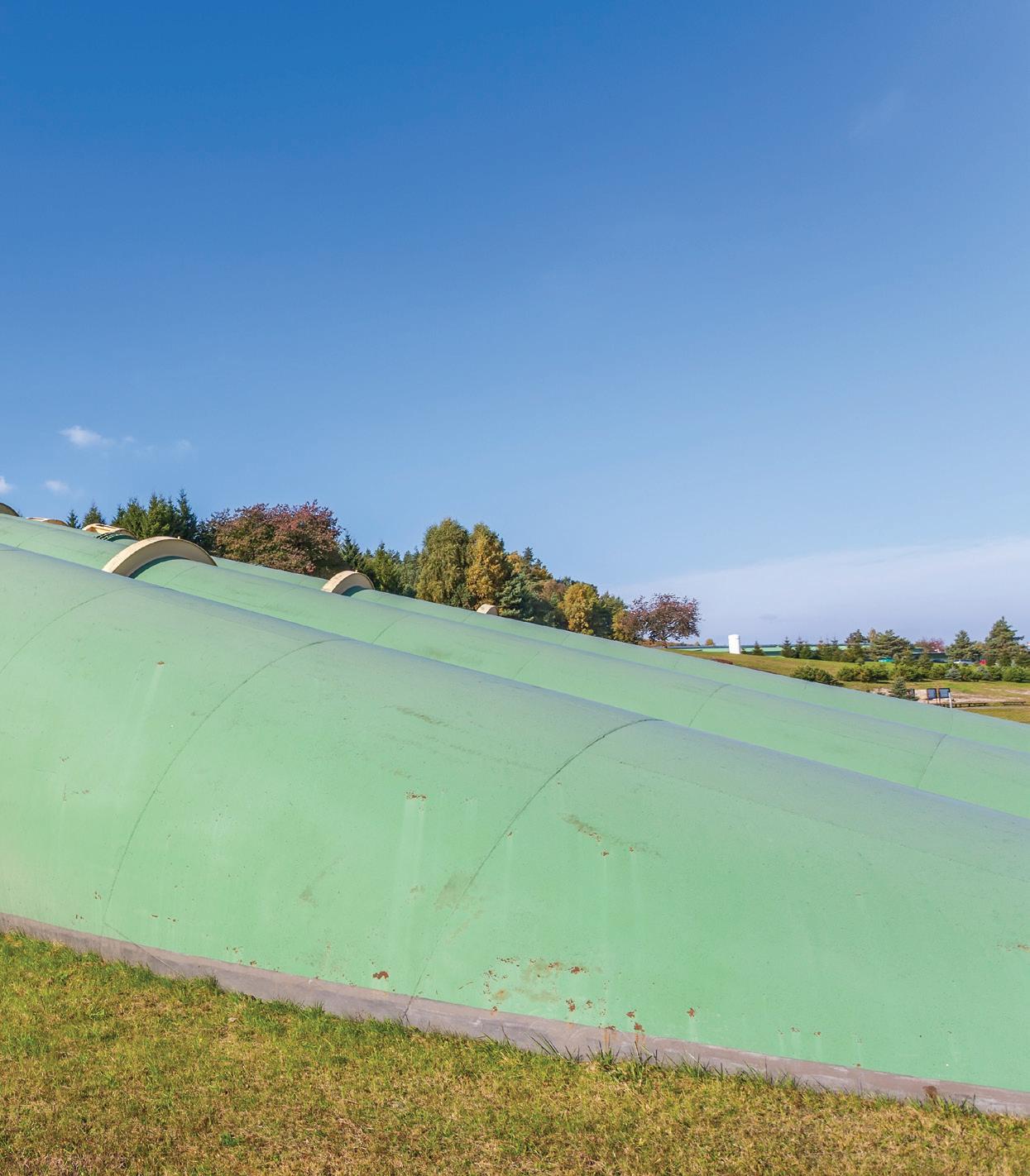
The successful large-scale energy storage will operate alongside the state’s two existing grid-scale batteries – the 100MW/129MWh Tesla battery at the Hornsdale Wind Farm and 30MW/8MWh ESCRI system at the Dalrymple substation.
Although these large batteries are effective, they don’t come cheap in comparison to pumped hydro. The system consistently demonstrates one of the most affordable, reliable forms of energy storage and generation, which is anticipated to become a growing industry in Australia’s renewable future.
PHES projects are continuing to pop up across the country, as the resource garners more interest from government, industry and the wider public. As pumped hydro systems develop, and the security and reliability of our energy system evolves, they will likely form a critical role in Australia’s energy future.
More dispatchable energy generation and storage puts downward pressure on electricity prices, reducing Australia’s reliance on more expensive forms of generation. High profile projects like Snowy 2.0 and Marinus are expected to bring exciting new prospects to the industry, create a smooth transition to a low-cost and reliable energy supply for customers, and give the ageing energy infrastructure a much-needed refresh.
www.energymagazine.com.au March 2020 ISSUE 9 59 PUMPED HYDRO
LIFE-SAVING TECHNOLOGY FOR POWERLINES AWARENESS
Energy Queensland has 1.7 million power poles and over 225,000km of overhead and underground powerlines across Queensland. Unfortunately, powerlines are accidentally contacted by workers all too frequently, which can result in severe and sometimes fatal injuries. Ergon Energy and Energex, as part of Energy Queensland, have developed a lifesaving tool to help improve safety around powerlines, that was formally recognised at the Safe Work Awards as Queensland’s ‘best solution to an identified electrical issue’.
Look Up and Live is an online mapping application that pinpoints the location of 210,000km of overhead powerlines and 1.7 million poles across Queensland. Energy Queensland’s network businesses, Ergon and Energex, have been running a general campaign around powerline awareness and safety for some time now, and the online application is an extension of this.
Aaron Smith, HSE Business Partner and Community Safety Manager at Energy Queensland, said the utility’s team of community safety specialists has been collecting statistics on accidental powerline contacts for over ten years to better understand why these incidents are occurring and how they could be prevented.

“From our investigation of powerline incidents, a clear issue stands out – a distinct lack of planning and powerline awareness. This lack of planning leads to workers not identifying any of the risks or hazards and therefore using no hierarchy of control to mitigate them,” Mr Smith said.
“The team fosters a positive and proactive association of powerline safety messages within the community by building awareness of the dangers of accidental contact with powerlines –via our program of engaging, educating and enabling workers.
“The Look Up and Live tool enables behaviour change by helping workers to adequately plan work and put effective controls in place, such as de-energisation, relocations, augmenting lines, and safety observers and/or rotamarkers (powerline markers) to highlight powerlines and keep persons clear.”
60 SPATIAL & GIS
The Look Up and Live application runs on ESRI’s ArcGIS platform and took nearly four years to develop, test and gain final approvals.
“The Community Safety team worked with members of our Digital Enablement and Asset Safety teams internally to build a product that would be easy for ‘at risk’ industries and general members of the public to use,” Mr Smith said.
“It was built at a very low cost with existing tools and technology, imagery and publicly available GIS data incorporating roads, local government boundaries and land use.
“Once the tool was built, the teams gained approval to trial it with members of ‘at risk’ industries to gauge usability and collect feedback from industry groups.”
Feedback was very positive, and the tool was then made available at lookupandlive.com.au. After approval from internal stakeholders at Energy Queensland, the tool was released for public use in April 2019.
“Essentially this tool and process is similar to a Dial Before You Dig request, but provides an interactive self-serve safety tool for overhead powerlines,” Mr Smith said.
For example, if used at the quoting stage of a construction site, the overhead powerline hazard could be eliminated by contacting the asset owner to have the lines removed and replaced with underground powerlines, or they could be de-energised when work needs to be performed around them.
“The teams are still taking feedback on the tool, including adding extra features that have been requested such as the ability to export data as kml or kmz files so it overlays onto existing GPS systems; an instant quoting tool to give indications of the cost of de-energising, relocating or raising powerlines; and an online risk assessment form incorporating imagery and powerline overlays.”
A valuable addition to the planning toolkit
The application is targeted towards ‘at risk’ industries, such as building and construction, agriculture, aviation, vegetation management, road transport and earthmoving.
Mr Smith said these industries are most at risk due to lack of planning and inattentional blindness.
“All these accidents are avoidable and mainly occur due to inattentional blindness, which is when an individual fails to perceive danger in plain sight, such as powerlines. Put simply we plan to work near the powerlines we cannot see,” Mr Smith said.

“There is the Dial Before You Dig tool for identifying underground assets, but there has never been a tool for planning work near overhead powerlines.
“We have put ourselves in the shoes of workers and geospatially overlaid powerlines onto imagery enabling workers and the community to effectively plan work near powerlines.”
“The user is now able to look at the worksite from a new vantage point and identify the electrical hazards, assess powerline risks, implement appropriate control measures and access links with additional safety advice.”
Unfortunately, the statistics speak for themselves. In Queensland, an average of 750 accidental contacts with powerlines occur each year – at least one person is electrocuted and approximately 15 people are injured.
61 SPATIAL & GIS
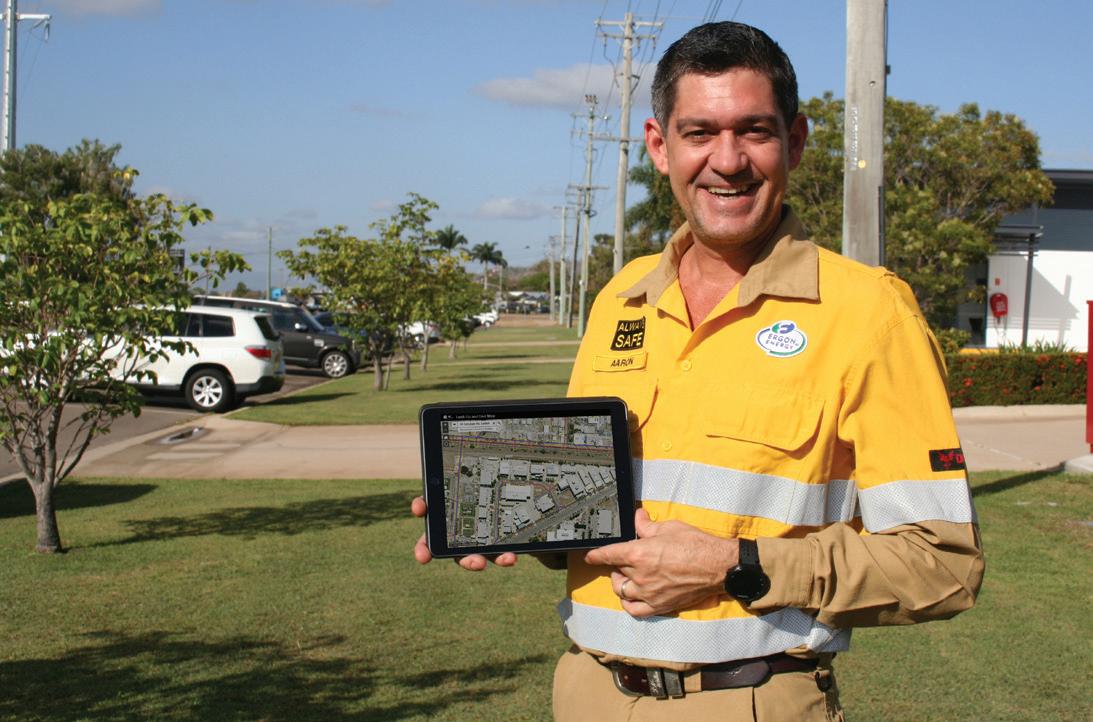
The Queensland Electrical Safety Act 2002 stipulates that powerlines up to 132,000V must have a 3m exclusion zone for untrained persons, but most people are unaware of this requirement for safe work near powerlines.
“The Community Safety team now share this tool when engaged in face-to-face discussions at industry events and when delivering powerline safety talks, as well as through social media, editorials and advertisements,” Mr Smith said.
“Our vision is to market this tool nationally to raise powerline safety awareness and reduce accidental powerline contacts.
“Feedback from ‘at risk’ industries has been very positive and has seen an increase in requests for safety advice and rotamarkers.

We have had tremendous feedback from companies such as Fulton Hogan, John Holland, Aerial Applicators Association of Australia (AAAA), Cotton Australia, Agforce, and local government councils and structural designers across Queensland.”
The Look Up and Live tool was recognised at the 2019 Queensland Safe Work and Return to Work Awards, winning the ‘best solution to an identified electrical issue’ category, which recognises excellence in developing and implementing a solution to an identified workplace electrical safety issue.
The tool was also recognised by the AAAA at its National Convention and Trade Show, taking out the 2019 Leland Snow Innovation Award.
THE LOOK UP AND LIVE APPLICATION FEATURES:
» Free access at www.lookupandlive.com.au
» Simple powerline overlay onto imagery
» Works on all devices, including phones and tablets
» Includes exclusion zone overlays
» Displays voltages and indicates the owners of powerlines
» User can start different safety processes, for example to have a powerline removed from a property or order the installation of a powerline marker
» User can draw/write on the map then print out the plan for their property or construction site
» Instantly share your location or screen via email with contractors/workers
» Quick links to order free safety stickers
» Quick links to watch safety videos
» Quick link to start a Dial Before You Dig enquiry
62 SPATIAL & GIS
An Ergon Energy employee with the Look Up and Live tool.
Brisbane Convention & Exhibition Centre
Exhibition opportunities available and selling fast.
Visit en2020.com.au
to find out how you can be involved.
early bird closes 16th2020March Register now
w.EN2020.com.au
RESEARCH PARTNER PRINCIPAL SPONSOR
HOW THERMAL AERIAL IMAGING IS CHANGING SOLAR FARM MANAGEMENT
Thermal aerial imaging is being used more and more by solar farm managers to assess and track the performance of PV arrays on large solar farms, and here, we take a closer look at the productivity gains this method of asset management and assessment can provide.
Traditional aerial thermal imaging techniques can relatively easily identify an array which is running at a higher temperature than other arrays, indicating the possibility of a faulty or declining panel in the array.
Aerodyne Australia UAV has stepped up the solar PV imaging standard with the use of aerial thermal imaging that can be captured quickly, but can still be used to identify individual panels in a PV array that are faulty or underperforming.
Aerodyne has also revolutionised how aerial thermal imaging is assessed by solar farm managers, by providing a full service analysis and assessment model that takes the load of solar farm personnel by delivering exception reporting on just those panels where potential issues are being detected.
Aerodyne’s Vertikaliti Solar cloud-based delivery platform adds a further management advantage by providing the ability to rapidly compare imagery from multiple thermal mapping missions to assess and identify trends in PV panel and array performance, which can provide an early indication of PV panel degradation and a means to implement predictive maintenance programs for large solar installations.
Every PV array (or even each PV panel) can be managed within the Vertikaliti platform as an asset, with a precise GIS location, historical inspection data and images, installation reports, maintenance reports, engineering and design data and other useful maintenance documentation, creating a “virtual twin” for each array or panel and enabling greater levels of desktop maintenance assessment.
Of course, the use of drones in solar farm management is nothing new. Traditional methods of panel and array inspection are very time consuming and expensive to sustain in a market where financial returns are still relatively low. Aerial PV array inspections, both visual and thermal, can deliver critical information much faster and usually much more cheaply, but the challenge is that they produce so much data and imagery, which then has to be collated and analysed before it can be readily consumed for maintenance purposes.
“The real game changer,” says Aerodyne Australia CEO, Tony Gilbert, “is capturing high resolution visual and thermal imaging that provides panel level detail, and delivering this data is a way that client management and maintenance personnel can readily and easily use.”
Aerodyne’s analysis team, which includes a thermographer, can now identify, classify and detect each defect in a clear and consistent manner, as well as making assessments on the performance of the system. Once the data is analysed and processed by in-house experts, the end-user will have access to this data who then will have a clear and complete picture of the site and to plan the next action for repair work.
“There’s no mystery about why aerial inspection of solar arrays is becoming so popular,” explains Mr Gilbert. “Because as well as providing better data, it’s also safer and usually cheaper as well!”
Why aerial solar inspections make good business sense
“Last year, our US business, Aerodyne Measure, conducted a study to compare the time, costs and results of using 100 per cent drone-based inspection across four solar PV sites,” said Mr Gilbert. The results speak for themselves.
• Site 1: 100 per cent IR drone inspection for maintenance of 74MW in Sumrall, MS; compared to clamp testing with 20 per cent IV curve tracing testing.
• Site 2: 100 per cent IR drone inspection for maintenance of 30MW in Sprague, CT; compared to Voc/Isc testing at the combiner box with visual inspection.
• Site 3: 100 per cent IR drone inspection for commissioning of 21MW in Rincon, GA; compared to 100 per cent hand-held IR scanning with 15 per cent IV curve tracing testing.
• Site 4: 100 per cent IR drone inspection for commissioning of 12.5MW in Herald, CA; compared to 100 per cent IV curve tracing testing.
“Comparing drone inspection time to relevant manual inspections across the four sites, we saw an increase in inspection efficiency of 97 per cent on average,” said Mr Gilbert.
March 2020 ISSUE 9 www.energymagazine.com.au
64 SPATIAL & GIS ENERGY PARTNER CONTENT
“This study demonstrated clear cost savings due to efficiency gains,” said Mr Gilbert. “These ranged from US$1074 to US$1717 per MW, for an average of US$1254 per MW cost saving.”
For the amount of data that is processed with a typical inspection (approximately 800 images per MW), turn-around time is surprisingly quick. These inspections each took less than five business days to be analysed and delivered.
Why aerial solar inspections make good operational sense
The data accuracy well-equipped and well-operated drones can deliver is very high. In the right hands, industrial grade drones and sensors can match the results from traditional thermographic inspections with 99 per cent accuracy in large photovoltaic plants. A traditional inspection takes about two working days, while a drone inspection can usually be completed in around two hours.
Due to the time and tedium of manually inspecting large solar farms, often located in remote locations and in hot climates, it’s often not realistic or cost-effective to manually inspect every panel of a solar farm. However, that’s not usually the case with drones, and though drone-based inspection is much faster, it can often detect defects that traditional inspections might miss at the string, module and sub-module level.
“Of course, Aerodyne can offer far more than solar module inspections,” said Mr Gilbert. “While drones are on site, there’s the opportunity to capture more accurate information on other site infrastructure as well such as fences, tracks, vegetation and more.”
As well as high resolution thermal data, Aerodyne can provide very high-resolution visual inspection data, 3D LiDAR modelling, multispectral vegetation analysis and more.
“We provide inspection data from our drones to the client in a user-friendly, readily actionable format, which is surprisingly easy to read and consume,” said Mr Gilbert.
Data can even be delivered through a smart phone app, which allows maintenance personnel to proceed directly to detected issue locations, with detailed information about the nature of the detected issue, improving efficiency and reducing costly repair hours. Aerodyne can even prioritise maintenance issues according to client rating scales and even integrate reporting into client ERP systems.

Three ways to receive drone inspection data
Aerodyne offers three typical methods for delivery of relevant and actionable solar farm inspection results:
1. PDF Inspection Reports: High level, brief and prioritised summaries of key inspection results.
2. Online Webmaps: Interactive data hosting in the Amazon S3 Cloud that includes a visual representation of aerial inspection results and a dataset that is exportable, georeferenced, and interactive.
3. Field Repair Application: Smartphone app that routes technicians to malfunctioning modules and allows corrective maintenance or field validation results to be input while onsite.
With drone inspection data in an online portal (or integrated into your internal data systems), you’ll also have data that can be compared over time and across sites. Tracking system issues over time will drive better and better decisions for operations, maintenance, and system design teams.
For more information about Aerodyne Australia’s Solar PV Inspection services, phone Tony Gilbert on 1800 931 866 or email your solar farm details to info@aerodyne.com.au.
Please remember to include a location and the number of solar panels in the facility.
ENERGY PARTNER CONTENT SPATIAL & GIS www.energymagazine.com.au March 2020 ISSUE 9 65
Site 1 Site 2 Site 3 Site 4 Size 74MW 30MW 21MW 12.5MW Drone Inspection Time 24 hrs 6 hrs 7 hrs 4 hrs Manual Inspection Time 778 hrs 293 hrs 208 hrs 195 hrs Hazardous Manhours Avoided 754 hrs 287 hrs 201 hrs 191 hrs Increased Efficiency 97 per cent 98 per cent 97 per cent 98 per cent Net Cost Saving $68,399 $25,485 $17,063 $19,552
Figure 1. Drone data delivered by Webmap and Field Application.
CLIMATE CHANGE DENIALISM

Even those who don't question human-induced climate change can fall on the spectrum of climate denialism if they are all talk and no action, a UNSW psychology researcher argues.
Climate change denialism is something that applies to more than just diehard nonbelievers, a UNSW Sydney researcher argues.
The unprecedented bushfire crisis of this summer has strengthened demand for government action on climate change, and galvanised
Australians to take to the streets protesting against the nation’s reliance on fossil fuels.
Some Australians have taken more drastic action, such as actor Yael Stone, who gave up the permanent right to work in the US.
But for many people, such action seems unrealistic.
March 2020 ISSUE 9 www.energymagazine.com.au
66 CLIMATE
DENIALISM – WE’RE ALL GUILTY

“While we may know it is better for the environment to give up our car for public transport, stop using single-use plastics, or eat less meat, we do not always do all these things all the time,” said UNSW Scientia PhD candidate Belinda Xie.
“It’s almost impossible to live with zero impact on the planet, but it’s what we do when we recognise this that matters.”
Ms Xie specialises in cognitive science and researches the psychology of climate change.
“It’s important that we acknowledge we are all climate deniers, to some extent, and then understand how and why we reached this point,” Ms Xie said.
“It’s not simply because humans are bad or selfish people: there are a lot of
external factors out of our control, such as the information we consume that can encourage denialism, or the way our economy is set up.
“So, we then need to ask ourselves: how do we overcome this denialism? What action can we take as a community and what can governments and business do?”
www.energymagazine.com.au March 2020 ISSUE 9 67 CLIMATE

Ms Xie said psychologists’ interest in climate science ramped up when climate scientist James E. Hansen told the US Senate in 1988 that the greenhouse effect had been detected and was changing the climate.
“Climate scientists have been doing their research and communicating it for many decades, but achieving behavioural change has been difficult,” Ms Xie said.
“So, psychologists have been trying to find out why – for example, psychologists discovered that emotions and shared values, not facts, more easily resonate with people.
“People also feel psychologically distant from climate change. They think it’s not going to happen to them, it’s going to happen in the future, or it's going to happen overseas.
“There has also been the emergence of mental health issues stemming from climate change which is another concern to psychologists.”
The denialism spectrum
Ms Xie said researchers defined denialism as a “construct” in the context of climate change and environmental psychology.
“To know that something is real but to actively say it's not – that’s denialism,” Ms Xie said. “Sociologist Stanley Cohen’s well-known categorisation system refers to three types of denial: literal, interpretive and implicatory denial.
“Using climate change as an example, literal denial is: ‘the climate is not changing’. The second level, interpretive denial, is: ‘the climate is changing but it’s not caused by humans’.
“The last one, implicatory denial, is: ‘I accept the climate is changing and that humans are causing it, but whether we need to do anything about it is debatable’.”
Ms Xie said a famous study led by Yale University examined denialism in relation to people’s climate change beliefs.
“The study identified six distinct groups of Americans on a spectrum from climate action to climate denialism, and found three subcategories of deniers,” Ms Xie said.
“The deniers were: dismissive – global warming is not happening; doubtful – I don’t know if global warming is happening but I’m not concerned about it; and disengaged – I don’t know if global warming is happening but because I don’t know enough, I could change my mind.
“Since the original study, the researchers have monitored the size of these six groups and found that most Americans now believe climate change is happening, while a minority remain in the denialist categories.”
Factors behind denialism
Ms Xie said there were a multitude of psychological factors and motivations which contributed to climate denialism, from motivated reasoning, free-market ideology and social norms, to pluralistic ignorance and inefficacy.
“In motivated reasoning, you reach a conclusion first and then you interpret and seek out information that’s consistent with that; for example, you might decide climate change is an obstacle to you enjoying your way of life, so in order to not worry about it you deny its existence,” Ms Xie said.
“There are also social factors and norms; so, if all your friends are denying something
and you still want to be friends with them, then you will probably also deny it.
“Climate change is also a political issue – people affiliate with political parties, their people and policies – and there is a lot of institutional and systematic denial disseminated through fossil fuel companies and parts of the media, so all this information influences people’s beliefs, even if they don’t actively seek it.”
Ms Xie said free market ideology was another key factor in climate change denialism.
“This concept is popular amongst people who are politically conservative: the belief that free markets should be left to function without intervention,” Ms Xie said.
“If people believe in free market ideology, it's more difficult for them to accept climate action, such as government carbon emissions policies.”
The idea of “pluralistic ignorance” was a further important factor in denialism, Ms Xie said.
“This is where a majority of people think their beliefs are in the minority, while a vocal minority thinks their beliefs reflect the majority.
“For example, climate deniers have loud voices that are publicised through a host of major media outlets.
“But, according to many surveys and polls, most Australians accept that climate change is happening and underestimate the rate at which they think other Australians also believe the same thing.”
Ms Xie said that as a result, many Australians could feel uncomfortable expressing their climate change views without knowing their views are, in fact, popular.
“In the case of climate change then, it could well be that the so-called ‘quiet Australians’ are those who support climate action,” Ms Xie said.
Recognising climate denialism
Ms Xie said it was important to recognise that we are all on the spectrum of climate denialism.
“The alternative, to be constantly thinking about and acting on the climate crisis, would be debilitating.
“We are all hypocrites to some extent, including the celebrities who signed the controversial letter supporting environmental group Extinction Rebellion.
“The letter acknowledged the undersigned were hypocrites for wanting climate action while leading high emissions lifestyles.”
Ms Xie said the letter showed how denial could be one contributor to people continuing their high emissions lifestyles.
March 2020 ISSUE 9 www.energymagazine.com.au 68 CLIMATE
The summer bushfire season has seen Australians gathering together to protest a lack of action on climate change.
“There are, however, a lot of other obstacles discouraging people from taking action,” Ms Xie said.
“In behaviour change psychology, there’s a spectrum of activity: risk perception leading to behavioural intention, leading to actual behaviour.
“For example, you think climate change is a problem, you plan to do something about climate change and then you take action.”
Ms Xie’s research on predicting climate change risk perception and willingness to act was published in the Journal of Environmental Psychology last year.
“In the context of promoting climate mitigation, we proposed behavioural willingness as a more important outcome variable than risk perception.
“We noted, however, that behavioural willingness is ultimately different from actual behaviour.
“So, by identifying how much other factors influence behavioural willingness and actual behaviour, researchers will be better positioned to advise policymakers and communicators on how to increase climate action.”
Overcoming climate denialism
Ms Xie said it was a challenge to live without having an impact on the environment and even she could be a denier at times.
“I sometimes deny it in order to live. For example, I felt terrible taking a plane trip back home for Christmas, but I denied it to keep on living,” Ms Xie said.
“Australia is a wealthy nation with high emissions, so it's difficult to live here without being some sort of hypocrite and engaging in action that involves emissions.

“For a modern society to function there will be some denial involved.”
Ms Xie said it was important to recognise this and take action to move beyond our own climate denialism and then urge others to do the same.
“It could be as simple as starting a conversation with friends and family, writing to MPs, donating to a climate action organisation, or becoming a more environmentally conscious consumer,” she said.
“You might even attend a rally – we argued that striking to support climate action can promote the psychological factors most important for fighting climate change.
“Based on our research, decreasing inefficacy – the belief that ‘I can’t make a

difference’ – and promoting social norms, are some of the most effective ways to encourage action on climate.”
Ms Xie said appealing to emotions and shared values was also key to fostering action, because researchers in psychology agreed that facts were not always a good strategy for changing minds.
“For example, even if you provide people with the facts about climate change, not everyone is going to interpret them in the way that you intend,” Ms Xie said.
“So, there is an increasing focus on engaging people's values through interesting stories and having those stories told through diverse sources to encourage connections and ultimately, action on climate.
“Making behavioural change at an individual level is important, but it’s just as important for the people and institutions at the top to inspire and implement change for the good of our planet and future generations.”
www.energymagazine.com.au March 2020 ISSUE 9 69 CLIMATE
Belinda Xie's research paper, Predicting climate change risk perception and willingness to act is available in the Journal of Environmental Psychology. This article was originally published by UNSW Sydney.
While many Australians believe that climate change is real, we struggle to relate the change to ourselves personally, and thus struggle to translate our beliefs into action.
UNSW Scientia PhD candidate Belinda Xie.
STAND-ALONE POWER SYSTEMS – A ROLE TO PLAY IN BUSHFIRE PREVENTION?
by Andrew Dillon, Chief Executive Officer, Energy Networks Australia
After a catastrophic summer bushfire season, Energy Networks Australia Chief Executive Officer Andrew Dillon takes a closer look at Stand-alone Power Systems and the role they can play in reducing the risk of bushfire.

March 2020 ISSUE 9 www.energymagazine.com.au
70 CLIMATE
Image courtesy Essential Energy.

With about 918,000km of lines and more than seven million power poles, Australia’s electricity network is very vulnerable to bushfires.
At the edge of the grid, thousands of customers in remote locations are served by long, skinny connections.
Maintaining these is expensive, and power can be unreliable.
This bushfire season has seen unprecedented damage with more than 100,000 customers losing power.
Preparing for fires and restoring connections is also costly, with many power poles being replaced only to be again destroyed by fire or falling trees.
Stand-alone power systems (SAPS) may help reduce risks, time of outages and costs.
The damage so far
The devastation has been unprecedented.
Thousands of kilometres of network have been damaged, more than 5000 power poles have been destroyed or require replacement, and more than 100,000 customers experienced power outages across the National Electricity Market (NEM).
The efforts of networks to restore and maintain power to customers has been herculean.
On New Year's Eve, fires tore through south-east New South Wales leaving 37,000 Essential Energy customers without power. By 3 January, 25,000 had been restored. However, over the
following weekend, further fire damage impacted power to more than 35,000 customers.
Overall, Essential Energy has had 1.5 million hectares or 32 per cent of its network footprint impacted by fire. This is an area larger than the entire Greater Sydney Region and includes 14,000 network assets.
And this is just one of the networks affected.
NSW’s Endeavour Energy and TransGrid, Victoria’s AusNet Services and SA Power Networks also have experienced significant damage and managed power outages to thousands of customers.
Bushfire preparation
Vegetation contacting power lines can damage infrastructure, triggering fires and power outages.
In a previous article, we outlined the steps networks take to mitigate risks, including year-round inspections and new technologies.
Settings on auto-reclosers can also be adjusted during the fire season, and some networks will de-energise to reduce fire risks.
Stand-alone Power Systems (SAPS)
Stand-alone power systems and microgrids can efficiently power individual properties or small, remote communities.
SAPS are usually a combination of solar PV, batteries and diesel (which serves as a backup) and do not require a connection to the main grid.
www.energymagazine.com.au March 2020 ISSUE 9 71 CLIMATE
Image courtesy Essential Energy.


These communities (or sometimes individual properties) are at the edge of the grid, sitting at the end of often long, vulnerable powerlines.
SAPS reduce the amount of infrastructure exposed to natural hazards and therefore the chance of damage or powerlines starting fires.
Eliminating sometimes hundreds of kilometres of powerlines also drastically reduces maintenance costs.
In Western Australia, Horizon Power and Western Power are marching down the path of supplying selected remote customers with SAPS and disconnecting them from the grid.
The result? Seventy-one fewer hours of power outages over a year, 90 per cent of electricity generated from solar panels and a significant rise in customer satisfaction. Also, the elimination of the risk of the old poles and wires starting fires.
What’s next?
SAPS and microgrids don’t make sense in suburban areas such as our larger cities.
It’s not practical to have a diesel generator running in a Fitzroy apartment building.
We need to let networks identify who would benefit most from these systems and how they can reduce costs for the wider community.
The Australian Energy Market Commission (AEMC) has drafted the rule changes required to allow electricity networks to deploy SAPS in the NEM.
Energy Networks Australia and electricity networks have been working with the AEMC, providing feedback on the draft.
The process is expected to be completed mid-2021.

March 2020 ISSUE 9 www.energymagazine.com.au
72 CLIMATE
A Western Power stand-alone power system (image courtesy Western Power).
A Western Power stand-alone power system (image courtesy Western Power).

YOU’VE JUST FOUND THEM. LOOKING FOR THE NUMBER ONE MARKETING AGENCY IN THE ENERGY INDUSTRY?
you like to work with us? Get in touch and we’ll arrange a time to chat. Ph: (03) 9988 4950 Email: info@monkeymedia.com.au www.monkeymedia.com.au CONTENT MARKETING SEO DIGITAL DESIGN SOCIAL MEDIA GOOGLE ADWORDS WE ARE MONKEY MEDIA. Our team uses their industry-specific knowledge to help you reach your target audience. We can help you navigate:
Would
LNG has a clear role to play as the world transitions to cleaner sources of energy.
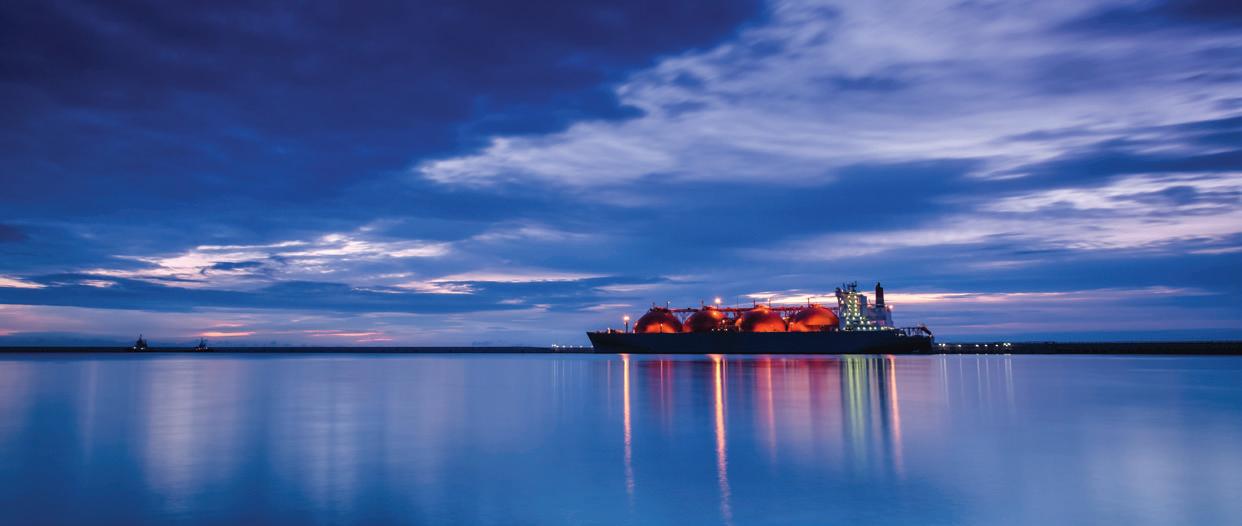
THE ROLE OF LNG IN ACHIEVING EMISSIONS REDUCTION
As the energy industry around Australia, and indeed the world, grapples with how we realistically manage the transition to more renewable energy sources, the role of gas as a transition fuel is becoming increasingly clear.
The global conversation around energy sources and consumption in recent years has been clear: we are being called upon to facilitate cleaner, greener options and create a significant reduction in greenhouse gas emissions.
But how do we achieve this and satisfy a growing appetite for energy?
In many parts of Asia, for example, energy consumption will continue to increase, and often the basis of that energy consumption is on emissions-intensive fuels.
While important, isolating and measuring each country’s efforts to reduce carbon emissions individually diminishes the progress. A collective approach should be taken – as a global society we need to find a global solution to a global challenge.
So how can we reduce greenhouse gas emissions while continuing to meet the world’s energy needs?
Natural gas is recognised as the perfect complement to the growing use of renewable sources, to enable us to become a cleaner, greener planet.
In a National Press Club address in January, Prime Minister Scott Morrison highlighted the importance of using natural gas to help the transition to renewable energy.
“Gas has a critical role to play as a backstop to our record investment in renewable energy generation. It helps ensure we can keep the lights on when the wind isn’t blowing and the sun isn’t shining,” Prime Minister Morrison said.
“Gas can help us bridge the gap while our investments in batteries, hydrogen and pumped hydro energy storage bring these technologies to economic parity with traditional energy sources.”
Natural gas, as a lower-carbon, cleaner energy source, delivers an array of environmental benefits:
» Reduced emissions of fine particulates
» Reduced emissions of nitrogen oxides and sulphur dioxide (an important contributor to smog and acid rain)
» Significantly lower demand for water in power station cooling
And as the largest liquefied natural gas exporter in the world, Australia is perfectly placed to aid the reduction in worldwide carbon emissions.
APPEA Chief Executive Andrew McConville says LNG exports from Australia have the potential to save global emissions equal to over a quarter of the country’s total annual domestic greenhouse gas emissions.
“Clearly there are emissions associated with producing LNG, but there can be real emissions reductions in its use in Australia’s export customer countries.”
Latest figures from the Australian Government show that our country’s LNG exports have the potential to lower emissions in importing countries by around 159 million tonnes by displacing coal consumption in those countries1
This is the equivalent of equalling nearly 30 per cent of Australia’s total annual emissions and is more than the entire emissions from the Australian transport and waste sectors combined.
The 2019 World Energy Outlook (WEO) report2 from the International Energy Agency found that in both their Stated Policies Scenario (incorporating current policy intentions and targets) and Sustainable Development Scenario (what needs to be done to achieve climate and other energy goals), the role of natural gas globally does increase, with the rate of increasing varying by scenario.
What remains constant, however, is the notion that a future with a combination of energy sources, including natural gas and renewable energy, will reduce global emissions and contribute to achieving our global solution.
1. https://www.minister.industry.gov.au/ministers/taylor/media-releases/australias-national-greenhouse-gas-inventory-december-2018-quarterly
2. www.iea.org/topics/world-energy-outlook

March 2020 ISSUE 9 www.energymagazine.com.au
74 CLIMATE ENERGY PARTNER CONTENT

ESB TO PROVIDE RELIABILITY ADVICE AND SECURITY MEASURES
March 2020 ISSUE 9 www.energymagazine.com.au 76 SECURITY
The Energy Security Board (ESB) has been tasked with providing advice on the implementation of interim measures to preserve reliability and system security in the National Electricity Market during the transition to the post-2025 market design.
The COAG Energy Council said the advice should include the review of the reliability standard and should be achieved by using existing mechanisms where possible.
This advice should be provided for Council consideration and decision by early this year.
Review of the Reliability Standard
The ESB will undertake a review of the reliability standard that should:
» Include cost/benefit analysis and impacts on prices for consumers by jurisdiction
» Identify options that may reduce energy costs to consumers, including by incentivising investment in new generation and interconnection
» Take into account the increased level of risk to reliability, e.g. from ageing thermal generation units
» Reflect community expectations that electricity supply will remain reliable during a “1 in 10” year summer
» Undertake any necessary stakeholder consultation
Any new recommended standard will:
» Apply for the 2020-2021 summer and beyond for the purposes of the 2020 Electricity Statement of Opportunities (ESOO), RERT triggering and Retailer Reliability Obligation (RRO) triggering
» Enable AEMO to better capture tail risks (such as anticipated deterioration of generation fleet)
» The ESB will consider broader implications of any new reliability standard (such as any implications for the market price cap) as part of its ongoing reliability work program
The ESB will report to the Energy Council with any recommended new reliability standard and draft rule changes pursuant to section 90F of the National Electricity Law (NEL) by March 2020, and if agreed, the package will be implemented in time for the ESOO for the summer of 2020-21.
System security services
The ESB will also provide advice on prioritising initiatives currently underway aimed at identifying the range of essential system security services required as the NEM transitions, how these services can be valued and how they can be efficiently procured.
The ESB will work with the market bodies to develop a system security workplan that will ensure the numerous current initiatives are fully coordinated and lead to a coherent overall design.
The ESB will provide advice on arrangements to give visibility of available resources and options to ensure their sufficiency, including ahead markets and unit commitment runs, to ensure that the right resources are available at the right time to ensure cooptimisation of necessary resources and services.
This should:
» Include the impact on price paid by consumers, investment and contract markets
» Be coordinated with implementation of current reforms such as access reform, the wholesale demand response mechanism and five-minute settlement, as well as possible longer-term market design changes under consideration by the p2025 project such as two-sided markets
» Include stakeholder consultation undertaken as necessary
Advice on preferred frameworks should be provided by March 2020, with detailed analysis to be provided in final advice by the end of 2020.
www.energymagazine.com.au March 2020 ISSUE 9
77 SECURITY
TOP TIER SPEAKERS AT TOP TIER CONFERENCE

The program for the energy industry’s leading event, Energy Networks 2020, has been released and will feature international and domestic experts in the sector.
The Energy Networks 2020 Conference + Exhibition is being held in Brisbane from 2-4 June 2020. Hosted by Energy Networks Australia, sessions will cover the key, pressing issues facing the energy sector.
The first plenary session will focus on the topic “Data to enable the energy transformation” and is sponsored by CutlerMerz. Moderator, CSIRO’s Brian Spak, will quiz senior leaders of Essential Energy, GreenSync and ABB on the growing need to enhance and optimise the use of data. As our grid becomes ever more complex with growing numbers of distributed energy resources, the potential for microgrids and shifting customer demand, data will be key to ensure network stability.
On the gas front, plenary two, supported by GHD, will look at “Greening gaschallenges and opportunities”. This session will look at the critical next steps in the life of gas networks as businesses start
pursuing a hydrogen and renewable gas future. Speakers include Anna Skarbek, the CEO of Climate Works.
With transmission development an increasingly hot topic, the challenges of managing regulatory approval processes, attracting investment and of fair allocation of costs are growing. Schneider Electric is sponsoring the third plenary session on “The Energy future: who pays?”, which will feature speakers including TransGrid’s Paul Italiano and Lawrence Jones from the Edison Electric Institute.
The final plenary session for the conference will focus on consumers. With the support of Siemens, the session will be moderated by Acting CEO of Energy Consumers Australia, Lynne Gallagher. Confirmed speakers include CEO of Ausgrid, Richard Gross, Andrew Richards from the EUAA and Lauren Solomon from the Consumer Policy Research Centre. This session has the topic “Network report card: the customer journey”.


To find out more about the program and speakers, head to www.en2020.com.au/program. Early bird registrations close on 16 March, to secure the discounted rate book now.

March 2020 ISSUE 9 www.energymagazine.com.au 78
EVENTS
Monitor up to 3 tenants with one compact device
NMI/Pattern Approved for billing purposes
Up to 75% space saving for cost effective installation
Unparalleled Accuracy - Class 0.5S - Better than a traditional Class 1 meter
Battery backed clock (RTC)
Suitable for electricity, water and gas usage
NEM 12/13 data generated via eXpertPower
Integrated architecture for residential, commercial and industrial tariffs
Value added support providing market growth with customer satisfaction


80 March 2020 ISSUE 9 www.energymagazine.com.au FEATURES SCHEDULE
Aerodyne Australia....................................................... 64–65 ANT Energy Solutions 31 Australian Energy Storage................................................. IBC Brighter 75 Close Comfort ................................................................... 45 Energy Networks 2020 62 Hexagon ........................................................................... 27 Monkey Media 73 Nearmap ........................................................................... 35 Ningbo Ginlong Technologies ........................................... IFC Omicron Electronics Australia ......................................... OBC Position Partners ................................................................ 17 Renewable Baseload Generators 44 ResourceCo 47 Risen Energy (Australia) ...................................................... 9 SATEC Australia ................................................................. 79 Smart Energy Conference & Exhibition..................................39 Veolia Energy 41 Vermeer Corp .................................................................... 21
MAJOR FEATURES Grid integration and stabilisation Disruption Embedded networks Biofuels SPECIAL FOCUS Electric vehicles IoT & cloud communication Demand management EQUIPMENT & MACHINERY Switchgear EVENT DISTRIBUTION TBC MAJOR FEATURES Solar Domestic gas outlook Hydrogen and future fuels SPECIAL FOCUS Smart networks (big data, smart meters and smart grids) Consumer and industrial retail Security EQUIPMENT & MACHINERY Spatial & GIS EVENT DISTRIBUTION Digital Utilities Smart Cities MAJOR FEATURES Energy networks Storage and solar Safety and risk management Waste-to-energy SPECIAL FOCUS Automation Asset management Industrial energy EQUIPMENT & MACHINERY Transformers and substations Vegetation management EVENT DISTRIBUTION Smart Cities EN2020 Australian Energy Week Enlit Australia Energy Next June 2020 Deadline: 24 April 2020 November 2020 Deadline: 16 October 2020
FEATURES Wind Nuclear energy Gas pipelines Energy efficiency SPECIAL FOCUS Microgrids Disaster management Distributed generation EQUIPMENT & MACHINERY Asset inspection & drones/UAVs EVENT DISTRIBUTION Critical Infrastructure Summit September 2020 Deadline: 24 July 2020 March 2021 Deadline: TBC
FEATURES SCHEDULE
ADVERTISERS’ INDEX
MAJOR










































































SEE OUR STRONGEST LINE-UP YET
With the program theme “Powering Change”, The Australian Energy Storage Conference and Exhibition will continue to discuss the most topical storage projects and innovations from around the world. This year, we are proud to expand the program to encompass a new stream with sessions focused on PPA’s, commercially sited renewable energy, and energy efficient projects helping to transition business, government and networks to 100% renewable energy.
REGISTER BEFORE MARCH 24
TO SAVE UP TO $300
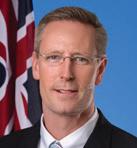


PRINCIPAL PARTNERS BROUGHT TO YOU BY AUSTRALIA’S LARGEST DEDICATED ENERGY STORAGE EXHIBITION FREE!

The free-to-attend exhibition provides an opportunity to see first-hand the latest products and solutions able to deliver cost effective energy for Australia’s utilities, commercial, industrial sector and more.
FREE-TO-ATTEND REGISTRATION OPEN NOW!



www.australianenergystorage.com.au
 THE
THE
HON. DAN VAN HOLST PELLEKAAN Minister for Energy and Mining, Government of South Australia
STEFFEN HEINRICH CEO, Qinous GmbH
ADEL AIDE CO N VENTION CENTRE, ADEL AIDE 20 - 21 MAY
CAROLINE WYKAMP CCO, Hydro Tasmania
Andreas Klien Cyber Security Expert


Effectively detect and react to cyberattacks
Along with the growing digitization and networking of energy systems, there is also a growing danger that IEC 61850 systems will become the target of cyber attacks. Therefore, cyber security must also play a vital role in the planning and operation of substations. The StationGuard monitoring system allows utilities to detect cyber attacks and malfunctions in substations immediately so they can react to them at an early stage.
www.omicronenergy.com/stationguard info.australia@omicronenergy.com
Australia: 03 9473 8400









































 Kane
Kane


 Marie Lam-Frendo
Marie Lam-Frendo































 by Claire Johnson, Co-Founder & CEO, Hydrolytics
by Claire Johnson, Co-Founder & CEO, Hydrolytics






































































































 THE
THE


